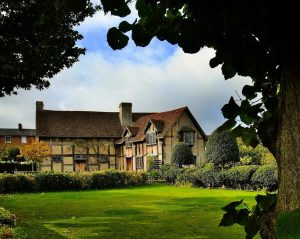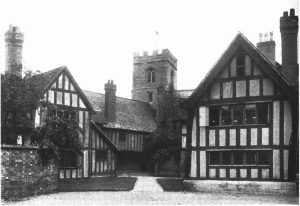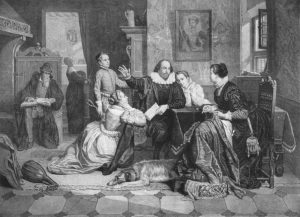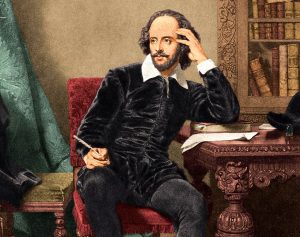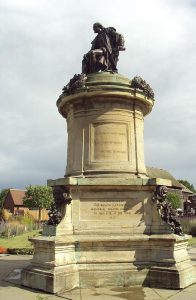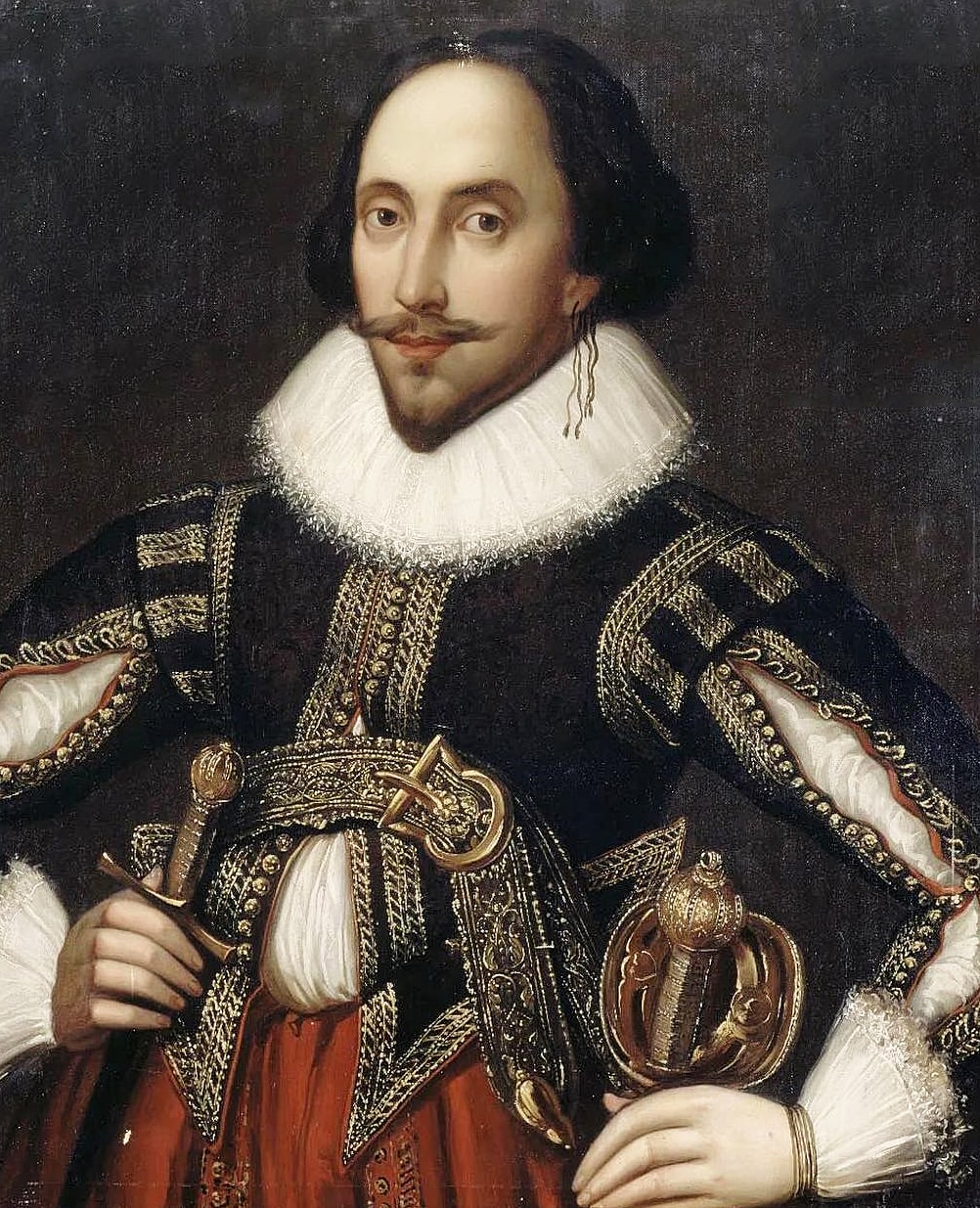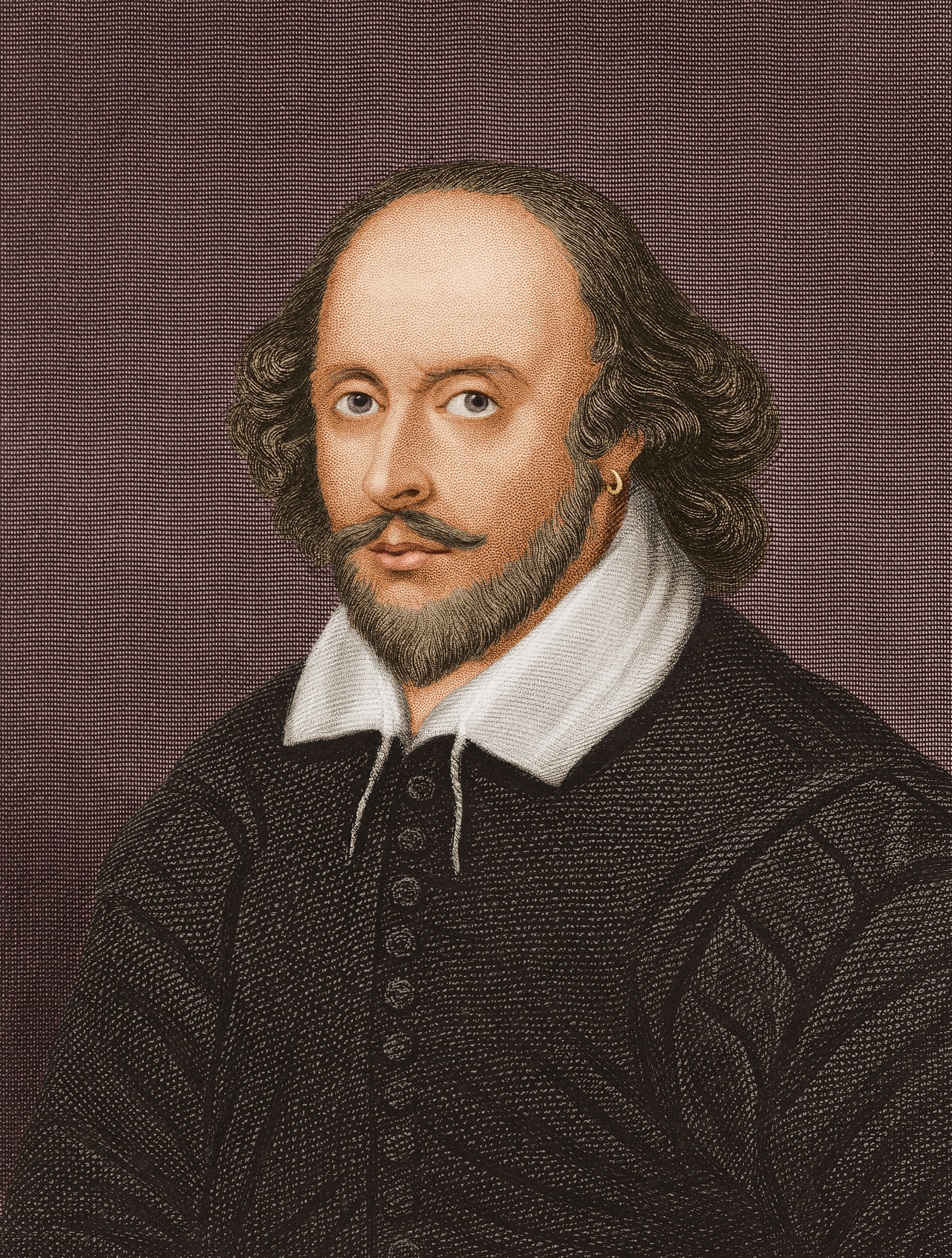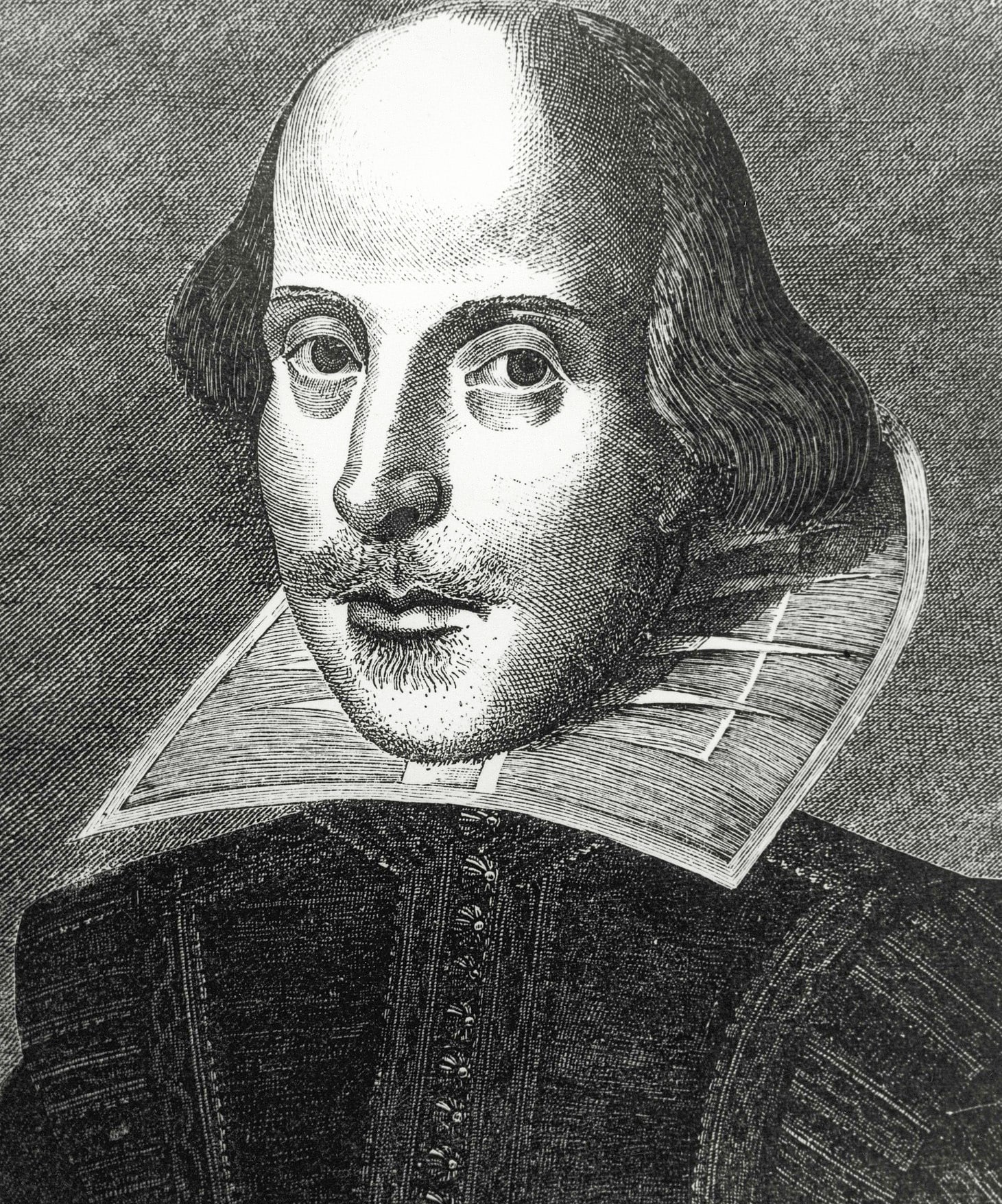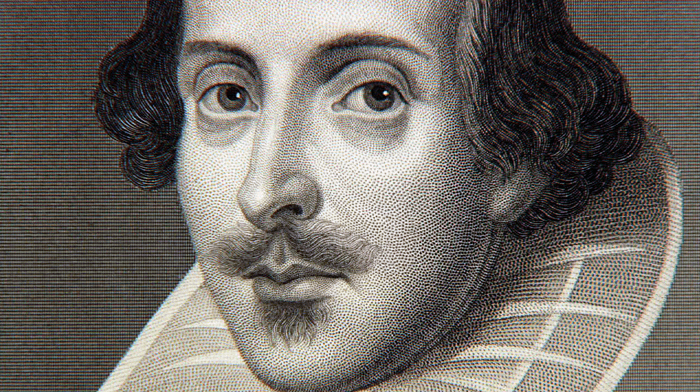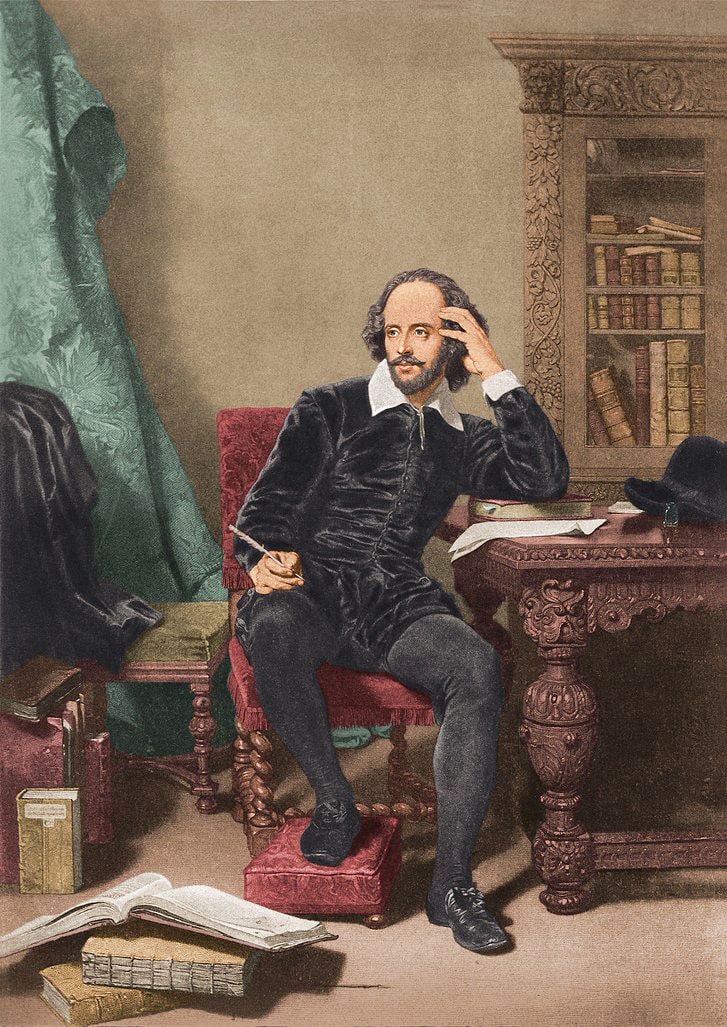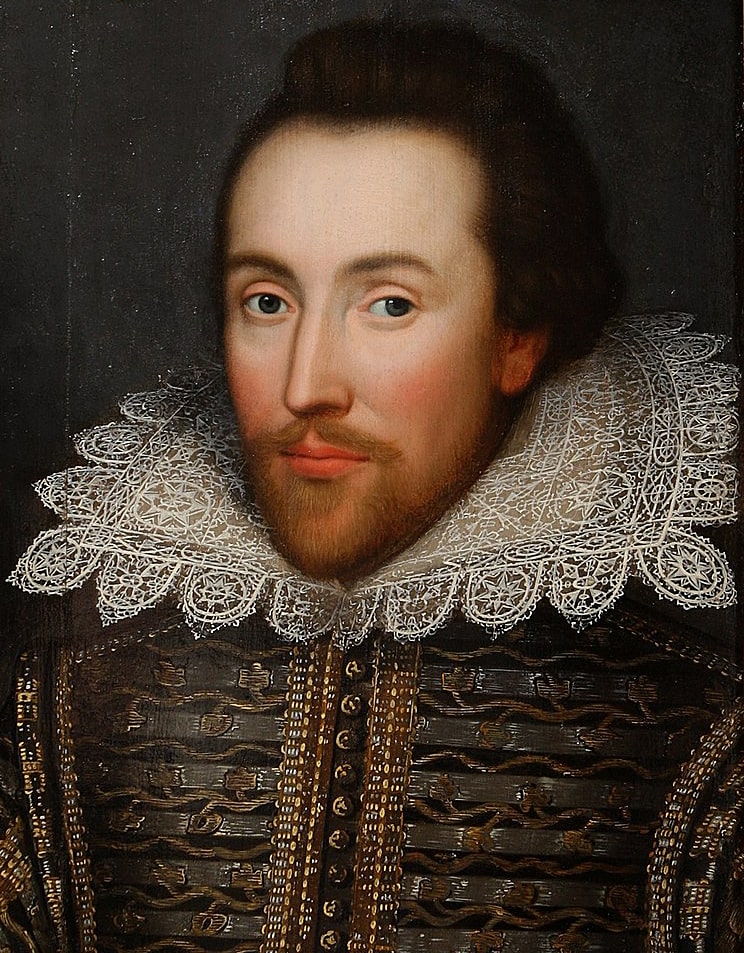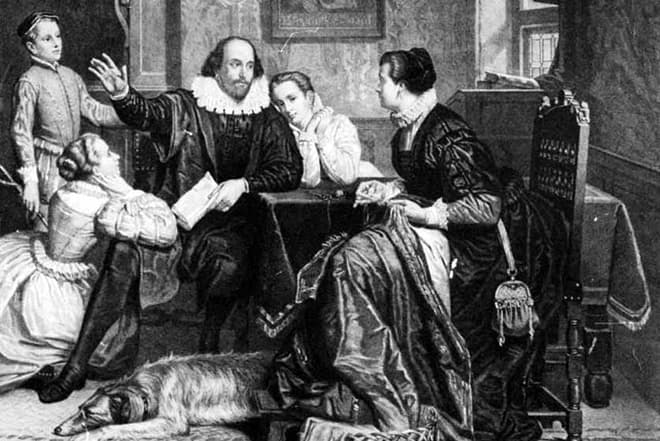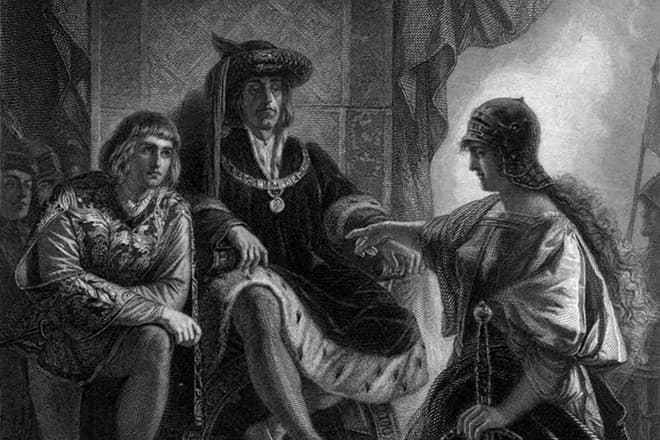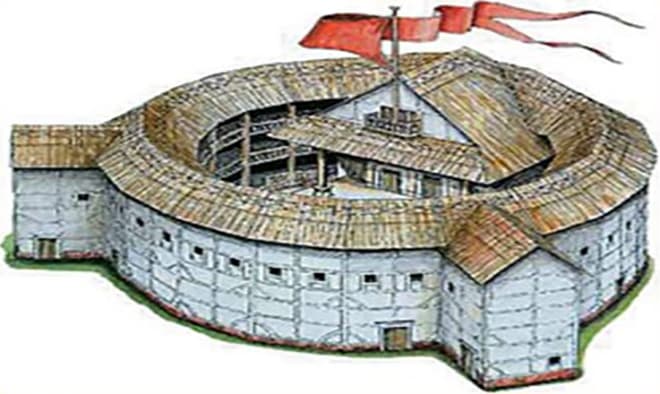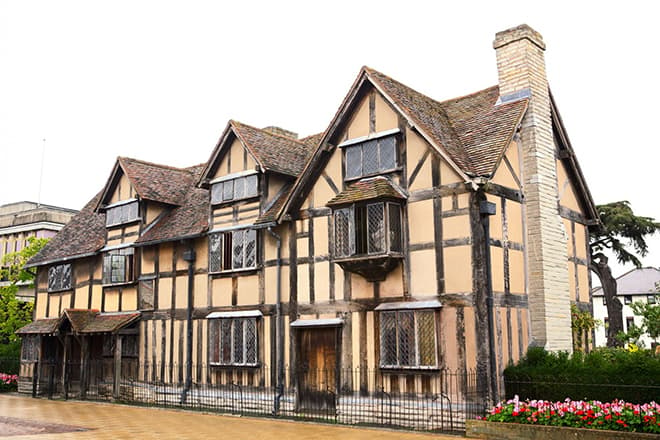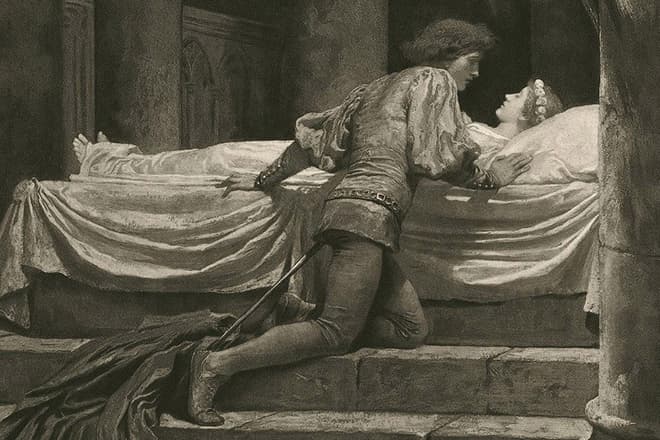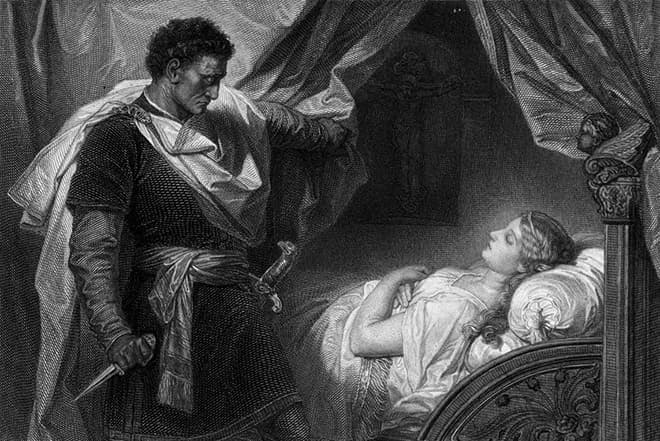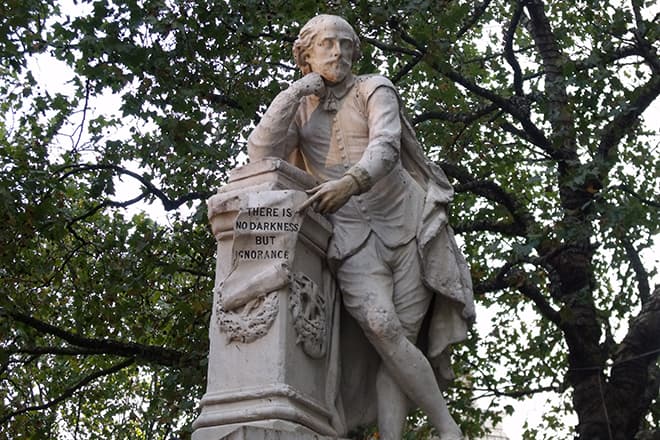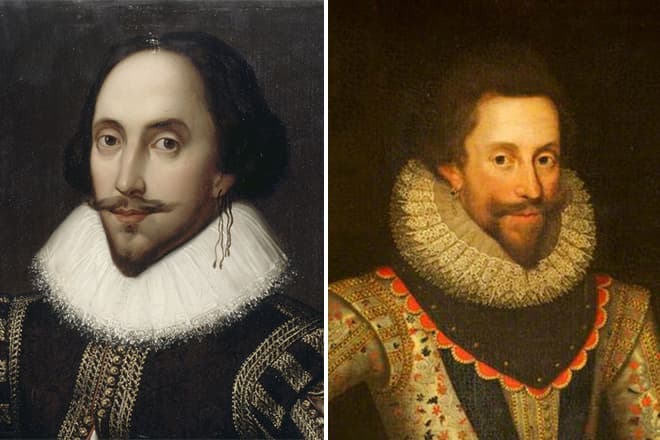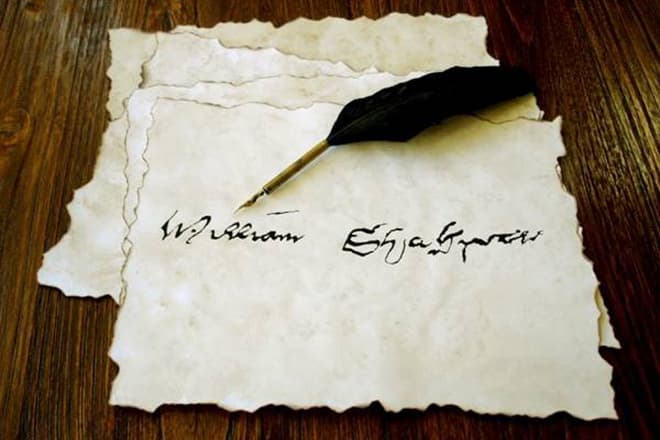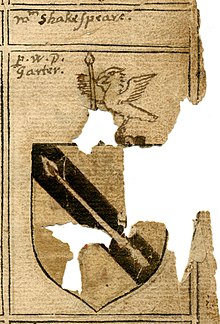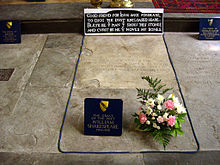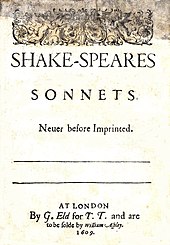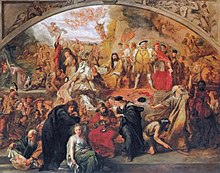Уильям Шекспир — биография
Уильям Шекспир – английский драматург, поэт. Автор многочисленных пьес, поэм, сонетов, эпитафий, национальный поэт Англии. Именно его перу принадлежит трагедия Ромео и Джульетты
Сложно найти человека, который бы никогда не слышал имя Уильяма Шекспира – поэта и драматурга, гуманиста и человека Возрождения. Он самый великий англоязычный писатель, национальный поэт Великобритании и лучших драматург среди всех, известных в мире. Его произведения переведены и изданы практически на всех языках, некоторые из них входят в обязательную школьную программу. Фильмы, снятые на основе его пьес, остаются актуальными даже спустя несколько веков после их создания.
Детство
Родился Уильям Шекспир предположительно 23 апреля 1564 года в английском городе Стратфорд-апон-Эйвоне, недалеко от Лондона. Точная дата рождения поэта неизвестна, есть только данные о дне его крещения – 26 апреля.
Отца звали Джон Шекспир, он занимался земледелием, изготавливал перчатки и слыл мелким ростовщиком. Потом занимал должность олдермена, то есть, возглавлял муниципальное собрание, а потом стал во главе совета города. Мама мальчика – Мэри Арден принадлежала к старинному и очень уважаемому саксонскому роду.
Сохранились сведения о том, что Джон придерживался католической веры, за что впоследствии его преследовала церковь. Он был вынужден продать все земли, которые приобрел за свою жизнь. Джон постоянно платил штрафы протестантской церкви за то, что не ходил на службы. У супругов родилось восемь детей, Уильям был третьим из них.
Начальное образование Шекспир получил в родном городе Стратфорд. Он учился в грамматической школе, где основной упор делался на изучение латыни и древнегреческого языка.
В школе постоянно ставили пьесы на латыни, педагоги считали, что только таким образом можно глубоко изучить древние языки.
Есть мнение, что кроме грамматической школы, Уильям учился еще и в королевской школе. Там он впервые прочел труды древнеримских поэтов.
Загадочные семь лет
Поэт принадлежит к тем историческим личностям, биографию которых пришлось складывать как мозаику из мелких частиц. Нет никаких биографических записей о его жизни, поэтому источники сведений о жизни Шекспира были в основном второстепенными. К примеру, записи каких-то административных учреждений или высказывание о нем современников.
Самым загадочным отрезком его жизни стали семь лет, которые прошли между рождением двойняшек и первыми упоминаниями о его деятельности в Лондоне. Для исследователей этот отрезок стал настоящей загадкой.
Говорили, что он поступил на службу к знатному землевладельцу, потом учительствовал, работал в театре в качестве суфлера, рабочего сцены, и некоторое время коневода. Однако насколько эти сведения достоверны, никто сказать не может.
Могут быть знакомы
Лондон
Первое упоминание о Шекспире появляется в 1592 году. Английский поэт Роберт Грин дал свою оценку творчеству Уильяма, и его высказывание появилось в прессе. Аристократ посмеивался над молодым драматургом, потому что понимал, что перед ним достойный конкурент, хотя и без благородного происхождения и достойного образования. Примерно в это время появляются упоминания о первой постановке пьесы «Генрих VI», авторство которой принадлежит Шекспиру. Она вышла на сцене лондонского театра «Роза».
Пьеса написана в жанре хроники, очень модном в те годы в Англии. Это было типичным для эпохи Возрождения, повествование имело эпический характер, и зачастую состояло из разрозненных картин и сценок, не имеющих связи между собой. В хрониках воспевалась государственность страны, порицались междоусобные войны и феодальная раздробленность. В 1594 году Уильям Шекспир вступил в сообщество актеров под названием «Слуги лорда-камергера». Прошло немного времени, и он стал одним из его соучредителей.
Спектакли пользовались большим успехом, что позволило труппе разбогатеть буквально за короткий промежуток времени. Поэтому было принято решение о строительстве отдельного здания для театра, получившего название «Глобус». Стройка длилась пять лет. В 1608 году сообщество стало владельцем еще и закрытого помещения «Блэкфрайерс».
Такого успеха артисты достигли благодаря благосклонности английских монархов. Елизавета I и ее сын Яков I имели особое отношение к театру. Яков даже разрешил коллективу сменить статус, и в 1603-м труппа стала называться «Слуги Короля».
Уильям был не только автором пьес, он активно участвовал в постановках спектаклей. До наших дней дошли сведения, что всех главных героев своих произведений автор играл сам.
Творчество
Вклад Шекспира в сокровищницу мировой литературы сложно переоценить. Более пяти веков его произведения вдохновляют актеров и композиторов, театральных и кинорежиссеров. Творческая деятельность Уильяма состоит из нескольких периодов, в каждом из которых он полностью менял стиль написания своих шедевров.
Его первые произведения были копиями популярных в те годы сюжетов и жанров – «Укрощение строптивой», «Тит Андроник» реальное тому подтверждение. Первая написана в комедийном жанре, вторая в «трагедии ужаса». Произведения имели громоздкую форму, большое количество ролей и очень сложный в восприятии слог. Это было время учебы, постижения азов написания драматических произведений.
Во второй половине 90-х годов 16 века в драматургии появились сочинения, которые характеризовались отточенными формами и содержанием. Шекспир занялся поисками новой формы, при этом он по-прежнему творит в рамках ренессансной трагедии и комедии. В старых, изживших себя формах, прослеживается новое содержание. Так родились гениальные произведения «Сон в летнюю ночь», «Ромео и Джульетта», «Венецианский купец». Они отличались свежестью повествования, облаченной в запоминающийся своей необычностью сюжет. Пьесы Шекспира набирают популярность у самого разного зрителя.
Одновременно с этим, Уильям стал автором цикла сонетов, используя очень популярный жанр любовной лирики в стихах. На протяжении двух столетий об этих сонетах не вспоминали, а когда наступила эпоха романтизма, они снова оказались на вершине славы. В 19-м веке стало модным цитировать именно эти бессмертные строки Шекспира.
Эти стихи стали своеобразным посланием неизвестному молодому человеку, и только 26 последних из ста пятидесяти четырех сочинений обращены к прекрасной брюнетке. По мнению некоторых исследователей, в сонетах можно найти указание на моменты из биографии автора, в том числе и на его нетрадиционную ориентацию. Однако другие историки предполагают, что посредством своих сочинений поэт общается со своим другом и покровителем графом Саутгемптоном. Именно таким образом тогда происходило общение в светском обществе.
На границе двух веков Уильям создал свои бессмертные произведения, увековечившие его имя в истории литературы и театра. В это время он уже был состоявшимся и успешным литератором, достаточно обеспеченным в финансовом плане. Он пишет пьесы, принесшие ему известность далеко за пределами родной Англии. Одна за одной выходят трагедии «Макбет», «Гамлет», «Отелло», «Король Лир». Благодаря этим произведениям театр «Глобус» приобрел невероятную популярность и стал самым посещаемым увеселительным заведением в Лондоне. Вскоре владельцы театра прочувствовали эту славу на собственном финансовом состоянии – они стали в несколько раз богаче.
Третий период творчества великого драматурга начался уже на закате его профессиональной деятельности. Он стал автором произведений, которые имели совершенно новую форму, где трагедия вплотную переплетается с комедийным жанром, а сказка соседствует с повседневной жизнью. Среди них стоит отметить «Зимнюю сказку», «Бурю», «Антония и Клеопатру», «Кориолана». Эти шедевры мастера лишний раз подтверждают, что он стал настоящим знатоком драматического жанра, с легкостью собирающего в одном месте трагедийные и сказочные черты, высокий слог и обычную речь.
Многие произведения Шекспира увидели свет еще при жизни автора. А вот до издания полного собрания сочинений дело дошло только в 1623-м. Сборник вышел только благодаря участию ближайших друзей драматурга – Генри Кондела и Джона Хеминга, артистов труппы театра «Глобус». В книгу вошло тридцать шесть пьес Шекспира, и ее назвали «Первое фолио».
На протяжении 17 века удалось напечатать еще три таких фолио, некоторые из них содержали изменения в тексте в сравнении с первоисточником.
Личная жизнь
Поэт очень рано устроил свою личную жизнь. Ему исполнилось всего 18, когда он завел романтические отношения с соседской девушкой Энн Хататуй. Ей на тот момент исполнилось 26, и вскоре влюбленные поженились. Такая спешка была вызвана беременностью Энн. В те годы добрачная беременность считалась чем-то закономерным, очень часто молодые люди женились, когда невеста уже находилась в интересном положении. Важно было только успеть обвенчаться до того, как родится малыш. В 1583-м Уильям стал отцом дочери Сьюзен, которую любил больше остальных своих детей. Спустя два года супруга подарила Шекспиру двойню – сына Хемнета и дочь Джудит.
Детей у них больше не было, скорее всего, по причине тяжелейших вторых родов Энн. В 1556-м семью постигло несчастье – Хемнет заболел дизентерией, и доктора не смогли спасти единственного наследника поэта. Вскоре Шекспир переехал в Лондон, а жена и дети остались жить в родном городе. Уильям регулярно навещал семью, хотя эти посещения были достаточно редкими.
О том, как устроилась личная жизнь Шекспира в Лондоне, точно ничего неизвестно. Ходило много слухов и пересудов о том, что он коротал ее не в полном одиночестве. По мнению исследователей биографии Шекспира, он имел любовные связи, причем, не только с женщинами. Однако проверить достоверность этой информации не представляется возможным.
Смерть
За несколько лет до смерти Уильям мучился от серьезного заболевания, в результате которого у него сильно изменился почерк. По этой же причине он не мог самостоятельно писать, и свои последние сочинения создал вместе с Джоном Флетчером, драматургом театра «Глобус».
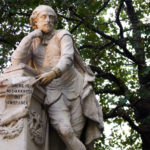
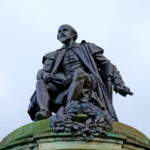
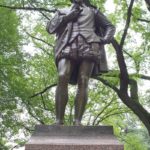
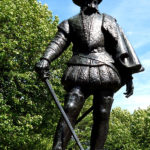
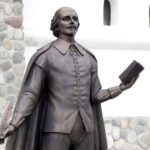
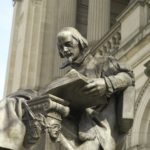
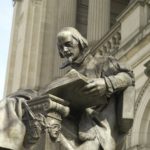
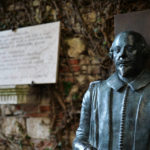
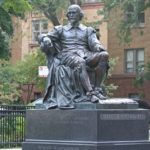
В 1613 году Шекспир окончательно уезжает из Лондона, однако продолжает заниматься некоторыми делами театра. Он стал свидетелем со стороны защиты на суде у своего приятеля, успевает стать владельцем еще одного роскошного особняка в Блэкфриарском приходе. Несколько недель драматург живет у своего зятя – Джона Холла, супруга старшей дочери.
В том же, 1613-м, поэт составил завещание, по которому все нажитое имущество отписывает старшей дочери. Днем смерти Шекспира принято считать 23 апреля 1616 года, хотя эти сведения тоже ничем не подтверждены. Супруга скончалась через семь лет после его смерти.
На тот момент старшая дочь Сьюзен уже родила Шекспиру внучку Элизабет. Она потом дважды была замужем, но в 1867 году умерла, так и оставшись бездетной. Младшая дочь поэта – Джудит вышла замуж за Томаса Куини, вскоре после смерти Уильяма. В этом браке родилось три мальчика, однако они все умерли молодыми. Таким образом, прервался род гениального поэта, ни одного прямого наследника у него не осталось.
Состояние
Существуют некоторые свидетельства приличного состояния Шекспира. Судя по приобретенной недвижимости, поэт хорошо зарабатывал, и его финансовые дела шли отлично. Поговаривали, что он занимался ростовщичеством.
Значительные накопления драматурга помогли приобретению шикарного особняка в родном городе Стратфорде. Помимо этого, после смерти для Уильяма уже было готово место упокоения – алтарь церкви Святой Троицы, тоже в родном городе. И все это не благодаря особым заслугам перед городом, а потому, что он заранее оплатил приличную сумму за это место.
Факты
- Точную дату рождения Шекспира выяснить не удалось никому. Историки располагают только церковной записью об обряде его крещения, состоявшемся 26 апреля 1564 года. Биографы приходят к выводу, что мальчика крестили спустя три дня после рождения, поэтому ориентировочно ставят дату рождения 23 апреля, точно так же, что и дату смерти.
- Шекспир имел феноменальную память, обладал энциклопедическими знаниями. Он говорил на двух древних языках, помимо этого свободно общался на современном итальянском, французском, испанском языках, хотя дальше Англии никогда не выезжал. Уильям был знатоком истории и политики, музыки и живописи, досконально разбирался в ботанике.
- Историки постоянно обсуждают нетрадиционную ориентацию поэта, мотивируя тем, что он слишком долго жил без семьи и поддерживал тесную связь с графом Саутгемптоном. Последний был большим оригиналом, его часто видели в женской одежде и с накрашенным лицом. Хотя найти прямые доказательства этому пока никому не удалось.
- Много вопросов возникает и по поводу протестантского вероисповедания драматурга и его родных. Его отец был католиком, хотя прямых доказательств этому нет, да и во времена правления Елизаветы I эта вера была практически под запретом. Многим католикам приходилось откупаться и таким образом иметь возможность тайно бывать на католических богослужениях.
- Единственным автографом Шекспира, сохранившимся для потомков, стало его завещание. Там перечислено все состояние поэта, вплоть до незначительных мелочей, однако о литературных работах нет ни слова.
- На протяжении жизни Шекспир успел сменить множество профессий. Он охранял конюшню в театре, в качестве актера выходил на сцену, был одним из соучредителей и главным постановщиком «Глобуса». Кроме этого занимался ростовщичеством, варил пиво и даже сдавал в аренду жилье.
- Существует версия, по которой был некий неизвестный писатель, который использовал Шекспира в качестве подставного лица. В Британской энциклопедии написано, что автором пьес, подписанных от имени Шекспира, мог стать граф Эдуард де Вер. Некоторые приписывают авторство произведений Уильяма лорду Фрэнсису Бэкону и даже королеве Елизавете I.
- Благодаря поэтическому слогу драматурга сформировалась современная английская грамматика, обогатилась литературная речь жителей туманного Альбиона. В ней часто встречаются фразы, взятые из произведений великого Шекспира. После себя поэт оставил огромное наследие – свыше 1700 новых слов.
Цитаты великого драматурга
В популярных фразах поэта и драматурга встречаются настоящие философские выражения, причем очень лаконичные и точные. В основном, они касаются любовной сферы.
Каждый читающий эти крылатые выражения находит именно то, что касается лично его. Классик призывал не судить других за грехи, лучше обратить внимание на свои, тогда и до чужих не будет дела.
Труды
Трагедии
- Ромео и Джульетта
- Кориолан
- Тит Андроник
- Тимон Афинский
- Юлий Цезарь
- Макбет
- Гамлет
- Троил и Крессида
- Король Лир
- Отелло
- Антоний и Клеопатра
- Цимбелин
Поэмы
- Сонеты Уильяма Шекспира
- Венера и Адонис
- Обесчещенная Лукреция
- Страстный пилигрим
- Феникс и голубка
- Жалоба влюблённой
Комедии
- Всё хорошо, что хорошо кончается
- Как вам это понравится
- Комедия ошибок
- Бесплодные усилия любви
- Мера за меру
- Венецианский купец
- Виндзорские насмешницы
- Сон в летнюю ночь
- Много шума из ничего
- Перикл
- Укрощение строптивой
- Буря
- Двенадцатая ночь
- Два веронца
- Два знатных родича
- Зимняя сказка
Ссылки
- Страница в Википедии
Для нас важна актуальность и достоверность информации. Если вы обнаружили ошибку или неточность, пожалуйста, сообщите нам. Выделите ошибку и нажмите сочетание клавиш Ctrl+Enter.
Биография Шекспира
23 Апреля 1564 – 23 Апреля 1616 гг. (52 года)
4.1
Средняя оценка: 4.1
Всего получено оценок: 3910.
Уильям Шекспир (1564–1616) – всемирно известный драматург, поэт и писатель. Многие произведения Шекспира переведены на русский язык. Уильям Шекспир, биография которого содержит много тайн и загадок, является автором многих пьес, таких, как «Гамлет», «Ромео и Джульетта», «Отелло» и другие.
Опыт работы учителем русского языка и литературы — 27 лет.
Детские годы
Не сохранилась точная дата появления на свет будущего талантливого писателя. Считают, что он родился в Стратфорд-на-Эйвоне в апреле 1564 года. Доподлинно известно, что 26 апреля он был окрещён в местной церкви. Его детство прошло в многодетной состоятельной семье, он был третьим ребёнком среди семи братьев и сестёр.
Юношеская пора
Исследователи жизни и творчества Шекспира предполагают, что своё образование он получал сначала в грамматической школе Стратфорда, а потом продолжал обучение в школе короля Эдуарда Шестого. В восемнадцатилетнем возрасте он обзаводится семьёй. Его избранницей становится девушка по имени Энн. В семье писателя было трое детей.
Жизнь в Лондоне
В 20-летнем возрасте Шекспир покидает родной город, перебирается в Лондон. Там его жизнь складывается нелегко: чтобы заработать средства, он вынужден соглашаться на любую работу в театре. Затем ему доверяют играть небольшие роли. В 1603 году на сцене театра появляются его пьесы и Шекспир становится совладельцем труппы под названием «Слуги короля». Позже театр получает название «Глобус», перебирается в новое здание. Материальное состояние Уильяма Шекспира становится гораздо лучше.
Литературная деятельность
Первая книга писателя была издана в 1594 году. Она принесла ему успех, деньги и признание. Несмотря на это, писатель продолжает работу в театре.
Литературное творчество Шекспира можно условно разделить на четыре периода.
На раннем этапе он создаёт комедии и поэмы. В это время им написаны такие произведения, как «Два веронца», «Укрощение строптивой», «Комедия ошибок».
Позже появляются романтические произведения: «Сон в летнюю ночь», «Венецианский купец».
Самые глубокие философские книги появляются в третьем периоде его творчества. Именно в эти годы Шекспир создаёт пьесы «Гамлет», «Отелло», «Король Лир».
Последние произведения мастера характеризуются отточенным слогом и изящным поэтическим мастерством. «Антоний и Клеопатра», «Кориолан» являются вершиной поэтического искусства.
Оценка критиков
Интересным фактом является оценка произведений Уильяма Шекспира критиками. Так Бернард Шоу считал Шекспира устаревшим писателем по сравнению с Ибсеном. Лев Толстой неоднократно выражал сомнение в драматургическом таланте Шекспира. И всё-таки талант и гениальность великого классика – неоспоримый факт. Как говорил известный поэт Т. С. Элиот: «Пьесы Шекспира всегда будут современными».
В рамках краткой биографии Шекспира невозможно подробно рассказать о жизни писателя и проанализировать его произведения. Для того чтобы оценить личность и творческое наследие, необходимо читать произведения и знакомиться с трудами литературоведов о жизни и творчестве Уильяма Шекспира.
Хронологическая таблица
Другие варианты биографии
Более сжатая для доклада или сообщения в классе
Вариант 2
Интересные факты
- Будущий поэт появился на свет в небольшом английском городе Стратфорде, расположенном на реке Эйвон. Событие это произошло в семье Джона Шекспира и Мари Арден, которые принадлежали к ограниченному числу состоятельных граждан. Глава семейства зарабатывал на хлеб изготовлением перчаток. Его безмерно уважали и несколько раз приглашали в совет правления города.
Все интересные факты из жизни Шекспира
Тест по биографии
После прочтения биографии попробуйте пройти тест:
Доска почёта

Чтобы попасть сюда — пройдите тест.
-
София Менглебей
9/12
-
Андрей Бекетов
8/12
-
Нурдана Нурбек-Кызы
11/12
-
Fatima Soldatbekova
10/12
-
Максим Николаев
9/12
-
Захар Одырейко
11/12
-
Любовь Савченко
12/12
-
Tatyana Yartseva
11/12
-
Наталья Разживина
8/12
-
Вафина Наталия
10/12
Оценка по биографии
4.1
Средняя оценка: 4.1
Всего получено оценок: 3910.
А какая ваша оценка за эту биографию?
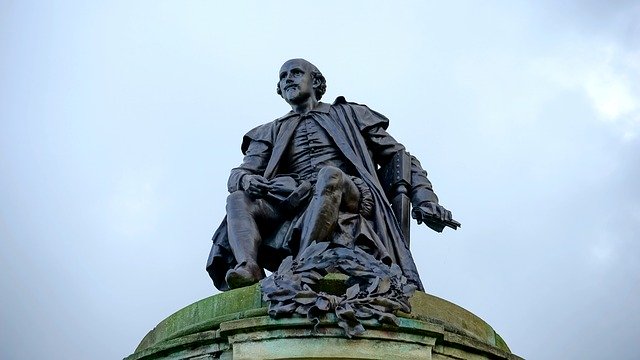
Национальная гордость Англии, один из лучших поэтов в мире – так говорят об этом авторе.
Уильям Шекспир (William Shakespeare, англ.) – знаменитый британский поэт и драматург, талант которого признан критиками и ценителями поэзии во всем мире.
Произведения автора переведены на множество языков. Некоторые литературные шедевры поэта включены в школьную программу. Их в обязательном порядке изучают дети.
Кроме того, по пьесам Шекспира ставят спектакли во многих театрах мира. И доказано, что произведения английского автора выбирают для театральных постановок чаще, чем работы других драматургов.
Фото У. Шекспира
Годы жизни и место рождения драматурга
Дата рождения Шекспира – 26 апреля 1564 года.
Дата смерти – 23 апреля 1616.
Город, где родился и вырос поэт − Стратфорд-апон-Эйвон.
Родился поэт в состоятельной семье. Его родители были уважаемыми людьми. Мать драматурга принадлежала к одной из старых саксонских семей. Отец был ремесленником, но при этом видным общественным деятелем. Он неоднократно занимал серьезные общественные должности – был членом муниципального собрания, главой городского совета. Интересный факт из биографии отца – он отказывался посещать церковь, за что ему приходилось платить немалые штрафы.
Семья и детские годы
Семья у Шекспира была большая. Кроме Уильяма, было еще 7 детей. Но, благодаря тому, что торговые предприятия отца приносили неплохую прибыль, у будущего поэта была возможность посещать местную школу и получить базовое образование.
Основным предметом в школе была латынь, но также ученикам преподавали основы риторики и грамматики. В учебную программу входило изучение великих философов и поэтов. И это наложило отпечаток на творчество Шекспира.
Работать Вильям Шекспир начал рано. К тому времени, когда ему исполнилось 16 лет, дела отца шли уже не так блестяще, как ранее. Поэтому ему пришлось начать работать, чтобы помогать семье.
Кем работал будущий поэт, достоверно неизвестно. По разным источникам он мог быть учителем в деревенской школе или подмастерьем в небольшой лавке.
Личная жизнь поэта
Женился драматург, когда ему исполнилось 18 лет. Это произошло в 1582 году.
Его избранницей стала Энн Хатауэй из семьи землевладельцев. Супруга была старше Вильяма на восемь лет.
На момент свадьбы Хатауэй была беременна, и в 1583 году у Шекспира родилась первая дочь, которую назвали Сьюзен. Через два года у пары родились двойняшки – мальчик и девочка, которых назвали Хемнет и Джудит.
К сожалению, Хемнет прожил всего 11 лет и скончался в августе 1596 года (точная дата смерти неизвестна).
Биография Шекспира имеет немало белых пятен. Историки до сих пор не могут восстановить ее полностью.
Так, известно, что из города, где родился Шекспир, он через 3 года после свадьбы переехал в Лондон. Но причины этого переезда достоверно неизвестны. Некоторые исследователи утверждают, что это произошло из-за того, что будущий драматург бежал из родного города из-за гнева помещика, который выяснил, что Вильям занимается браконьерством на его угодьях.
Начало творческой карьеры
С переезда в Лондон началась новая глава биографии Уильяма Шекспира. Но и про эти годы жизни поэта достоверно известно далеко не все.
Считается, что сразу после приезда он устроился работать в театр на самую низшую должность – в его обязанность входило присматривать за лошадьми господ, посещающих храм Мельпомены.
Есть информация, что он занимался не лошадьми, а переработкой старых пьес на современный лад. Также имеются предположения, что Шекспир попытался стать актером, но потерпел неудачу.
Что из краткой биографии поэта известно достоверно – Уильям входил в театральную труппу «Слуги лорда-камергера». И он был не только актером, выступавшим на сцене, но и одним из соучредителей.
Также он писал для труппы пьесы. Поставленные на основе произведений автора спектакли пользовались невероятным успехом у лондонских жителей из всех слоев общества – аристократии, простых горожан.
Благодаря быстрорастущей популярности к поэту пришел и финансовый успех. В 1599 год участники труппы основали свой театр под названием «Глобус», который находился на левом берегу реки Темза. Еще через несколько лет (1608 г.) ими был выкуплен театр «Блэкфрайер».
С этого времени поэт стал считаться одним из самых богатых людей Лондона.
Судя по отчетам, свидетельствующим о покупке недвижимости, финансовое благополучие действительно пришло к драматургу после вхождения в труппу «Слуги лорда-камергера». В качестве доказательства этого приводится тот факт из биографии автора, что он в 1597 году приобрел один из самых больших по площади домов в Стратфорде.
Что за годы творчества написал Шекспир
За годы творческой деятельности из-под пера автора вышло немало литературных шедевров. Но британский поэт не зацикливался на каком-то одном жанре.
Его произведения можно условно разделить на 4 категории. Что написал Шекспир:
- легкие комедии;
- античные пьесы и сонеты;
- трагедии;
- драматические сказки.
Первые литературные произведения Шекспира отличались легкостью, обилием иронии. Но с течением времени его пьесы становятся более серьезными, глубокими, содержательными.
В XVI веке в Англии были популярны произведения, в основе которых лежит исторический сюжет. И Шекспир не упустил этот момент.
В начале 1590-х годов он создал пьесы «Ричард III» и «Генрих VI» в трех частях. Это были одни из его ранних работ. И их хорошо встретила местная публика.
К сожалению, с датированием выхода произведений британского автора у ученых были и до сих пор возникают сложности. Слишком мало сохранилось достоверных источников, чтобы определить точный год выхода работ драматурга. Но исследователи, изучающие, жизнь и творчество великого мастера классической английской литературы, все же постарались выделить годы, в которые могла быть написано та или иная работа.
Например, трагедию «Тит Андроник», пьесы «Два венца» и «Укрощение строптивой», комедию «Комедия ошибок» принято относить к периоду раннего творчества Шекспира.
Середина 1590-х – годы изменения стиля работ автора. Оставив в прошлом легкие и ироничные комедии, он начинает писать романтические произведения.
Именно в это время появляются такие шедевры, как «Сон в летнюю ночь», «Венецианский купец», «Много шума из ничего», «Как вам это понравится», «Двенадцатая ночь».
В начале XVII века драматург создает несколько ставших знаменитыми пьес и трагедий. В это время свет увидели «Мера за меру», «Все хорошо, что хорошо кончается», «Троил и Крессида». Также в этот период Шекспир написал ставшего на весь мир знаменитого «Гамлета», «Отелло».
Всего за годы жизни Шекспиром было написано 154 сонета, 38 пьес, 3 эпитафии, 4 поэмы.
Список всех произведений
Трагедии:
- Макбет;
- Ромео и Джульетта;
- Король Лир;
- Кориолан;
- Король Лир;
- Отелло;
- Тит Андроник;
- Антоний и Клеопатра;
- Гамлет;
- Тимон Афинский;
- Троил и Крессида;
- Юлий Цезарь;
- Цимбелин.
Комедии:
- Как вам это понравится;
- Комедия ошибок;
- Буря;
- Мера за меру;
- Зимняя сказка;
- Два веронца;
- Много шума из ничего;
- Бесплодные усилия любви;
- Венецианский купец;
- Все хорошо, что хорошо кончается;
- Сон в летнюю ночь;
- Виндзорские насмешницы;
- Укрощение строптивой;
- Перикл;
- Двенадцатая ночь;
- Два знатных родича.
Поэмы:
- Жалоба влюбленной;
- Венера и Адонис;
- Сонеты Уильяма Шекспира;
- Феникс и голубка;
- Обесчещенная Лукреция;
- Страстный пилигрим.
Исторические хроники:
- Ричард II;
- Ричард III;
- Генрих IV, часть 1, 2;
- Генрих V;
- Генрих VI, часть 1, 2, 3;
- Генрих VIII;
- Король Иоанн.
Последние годы жизни и кончина поэта
Последние годы жизни английский поэт провел в своем родном городе. По предположениям историков, возвращение из Лондона произошло по причине вспышки чумы, из которой театрам приходилось останавливать деятельность, а у актеров резко снизилось количество работы.
Но Шекспир не осел полностью в родном городе, ему часто приходилось ездить в Лондон по делам.
За 3 – 5 лет до смерти Шекспир перестал заниматься творчеством. Кроме того, по мнению ученых, в 1612 – 1613 гг. драматург был чем-то серьезно болен. Такие выводы исследователи сделали при внимательном изучении почерка автора, который незадолго до его смерти значительно изменился.
Жена Шекспира пережила его на 7 лет, Энн Хатауэй скончалась в 1623 году.
Некоторое замешательство исследователей жизни драматурга вызвало оставленное им завещание. Согласно наследному документу, большую часть имущества получала старшая дочь Сьюзен и ее прямые потомки. Но удивление вызвало не то, что Уильям решил оставить почти все состояние дочери, а то, что он передал по наследству своей жене.
Драматург завещал Энн Хатауэй «мою вторую по качеству кровать». Эта формулировка вызвала среди историков немалые споры. Некоторые ученые считают, что таким заявлением поэт оскорбил свою жену. У других – мнение иное, противоположное. Некоторые историки считают, что драматург, когда составлял завещание, имел в виду супружеское ложе, поэтому причин говорить об оскорблении жены нет.
Похоронен Шекспир в церкви Святой Троицы в Стратфорде.
На надгробии поэта нанесена эпитафия, которая в переводе на русский язык звучит так:
Друг, ради Господа, не рой
Останков, взятых сей землей;
Нетронувший блажен в веках,
И проклят — тронувший мой прах.
Перевод выполнен Александром Величанским.
Репутация Шекспира и влияние его творчества на культуру
Хотя всемирно прославился Шекспир уже после своей смерти, при жизни его произведения находили отклик не только у зрителей, но и у критиков.
Так, Френсис Мерис (писатель-священнослужитель) отзывается о поэте как о самом превосходном английском писателе в жанрах комедии и трагедии. Немало похвал получает драматург у критиков XVIII века, а к 1800 году за ним надежно закрепляется звание национального английского поэта.
Еще позже, в XIX веке, известность драматурга выходит за пределы Англии. Восхищение талантом У. Шекспира высказывают такие знаменитые авторы, как Гете, Вольтер и Гюго.
Но не все готовы согласиться с тем, что Шекспир – великий поэт. Есть критики, которые высказывали о его творчестве негативное мнение.
Одним из них был русский писатель Лев Толстой. Он подверг критике талант британского поэта как драматурга.
Некоторые критики высказывают свое неприятие таланта поэта из-за того, что часть из своих знаменитых произведений он писал в соавторстве с другими литературными деятелями.
Есть даже гипотеза, что Шекспир – это не один человек, а псевдоним, под которым создавали пьесы несколько писателей. На чем базируется подобное заявление – не сохранилось ни одной рукописи, которая была бы написана рукой самого драматурга.
Кроме того, противников Шекспира удивляет его богатый словарный запас, хотя не сохранилось источников, подтверждающих получения им серьезного образования.
Что бы ни говорили о Шекспире критики, он уже несколько веков – один из самых популярных поэтов не только Англии, но и мира.
Практически в каждом театре ставят хотя бы одно его произведение. И это неудивительно. Творчество автора оказало серьезное воздействие на культуру и искусство. Под воздействием таланта Шекспира в мире появлялись новые произведения, герои которых имели те же черты, что и персонажи пьес драматурга.
По подсчетам ученых, примерно 20 тысяч музыкальных произведений связаны с творениями английского поэта. Кроме того, считается, что слог языка драматурга послужил основой для формирования современного английского языка.
Внешность драматурга
Изображение с гравюры
О том, насколько достоверными можно назвать растиражированные фото Шекспира, тоже идут споры между специалистами. Дело в том, что точных описаний внешности драматурга не сохранилось. Поэтому отражающим истинный облик поэта принято считать Друшаутский портрет (гравюра), созданный Мартином Друшаутом.
Шекспир – один из авторов, успех которого трудно повторить, хотя его литературная деятельность продолжалась всего 20 лет. Но, в каком веке жил Шекспир? В 16, а это значит, что уже целых 500 лет люди читают его произведения и находят их интересными.
 Роль и место в литературе
Роль и место в литературе
Творчество Уильяма Шекспира – это значимая страница в большой книге мировой Литературы. Созданные драматургом образы пополнили ряды вечных художественных образов. Гамлет, Ромео и Джульетта, Отелло, Король Лир – герои, которые давно вышли за пределы сочинений Шекспира и до сих пор живут в искусстве.
Происхождение
Дом в Стратфорде, где родился Шекспир. Сейчас музей
Великий драматург Уильям Шекспир появился на свет в 1564 году. Точные данные о дне рождения не сохранились. Город Стратфорд-апон-Эйвон (Англия) считается местом его рождения.
Отец – Джон Шекспир, зажиточный ремесленник. Он принимал активное участие в жизни города, был не единожды избранным на разные общественные должности. Так же о нем известно, что он не ходил на церковные собрания, за что платил большие штрафы. Это послужило поводом предположить, что Джон Шекспир был тайным католиком.
Мать – Мэри Шекспир (в девичестве Арден), представительница одного из старейших саксонских родов. Вышла замуж за Джона и родила ему восьмерых детей. Уильям стал третьим.
Детство будущего драматурга прошло в состоятельной многодетной семье.
Образование
Грамматическая школа
Принято считать, что начальное образование Шекспир получил в Стратфордской грамматической школе. Там делали уклон на изучение латыни, учитель даже писал стихи по латыни. Есть версия, что продолжил учебу Вильям в школе короля Эдуарда Шестого. К сожалению, школьные журналы этой школы не сохранились, поэтому нельзя это утверждать.
Юношеская пора
Шекспир обзаводится собственной семьей в довольно юном возрасте – в 18 лет. Его избранницей стала Энн Хатауэй, дочь землевладельца. Девушка была старше Уильяма на 8 лет. В 1582 году состоялась их женитьба. На момент регистрации брака Энн уже ждала ребенка.
Когда Уильяму было 20 лет, он вместе с семьей переезжает в Лондон. Молодой мужчина устраивается разнорабочим в театр. Чтобы нормально жить, ему приходилось соглашаться там на любую работу. Со временем, заметив рвение молодого Уильяма, ему все же стали доверять играть небольшие роли.
Творчество
Литературный дебют Шекспира состоялся в 1594 году, когда была издана его первая книга. С этого момента он становится известным. Но, несмотря на успех, Уильям продолжает работать в театре.
Семья Шекспира
В 1599 году Вильям Шекспир становится одним из совладельцев театра «Глобус».
Творчество Шекспира принято делить на четыре периода:
- Первый – ранний период. В это время он создает свои первые комедии и поэмы. Известными стали такие сочинения: «Комедия ошибок», «Укрощение строптивой» и т. д.
- Второй – романтический период. Наиболее значимые произведения этого периода – «Венецианский купец», «Сон в летнюю ночь».
- Третий – философский период. Именно в этот период рождаются самые глубокие произведения автора, такие как: «Отелло» и «Гамлет».
- Четвертый – вершина творчества. Автор уже был на этот момент опытным мастером слова и создавал такие изящные произведения, как «Антоний и Клеопатра».
Основные произведения
Рождение шедевра
Памятник поэту
К основным произведениям Шекспира относят такие его трагедии: «Гамлет», «Ромео и Джульетта», «Король Лир», «Отелло». Их читатели изучают еще со школьных лет. Именно эти произведения до сих пор на пике популярности в театре, музыке и кино.
Чем же они так привлекают сердца и умы поклонников? «Гамлет» заставляет нас задуматься о смысле человеческой жизни, о сложных противоречивых моментах, о том, что порой сложно понять: «быть или не быть»? А история Ромео и Джульетты навсегда останется примером настоящей любви!
Последние годы
Есть мнение, что последние годы жизни драматург проводил в родном городе, Стратфорде. Скорее всего, его мучила какая-то болезнь, потому что на всех его последних документах стоит неразборчивая подпись. После 1613 года автор не создает пьес. В 1616 году его не стало.
Хронологическая таблица
| Год (годы) | Событие |
| 1564 | Год рождения Уильяма Шекспира |
| 1571-1578 | Годы обучения в Стратфордской грамматической школе |
| 1582 | Брак с Энн Хатауэй |
| 1584(5) | Переезд в Лондон |
| Конец 80-ых годов | Начало работы в театре |
| 1594 | Выход первой книги |
| 1599 | Открылся театр «Глобус» |
| 1601-1602 | Работа над трагедией «Гамлет» |
| 1605 | Работа над трагедией «Король Лир» |
| 1613 | Переезд в родной город Стратфорд |
| 1616 | Не стало драматурга |
Интересные факты
- Кроме литературного таланта, у Шекспира была способность к иностранным языкам и отменная память. Он знал французский, итальянский и испанский языки.
- Шекспир был человеком с разносторонними интересами: варил пиво, занимался арендой квартир.
- Точно неизвестно, кем был Вильям Шекспир: католиком или протестантом. Он это скрывал, как и его отец.
Музей писателя
Дом, в котором провел детство Уильям Шекспир, сейчас является музеем и одним из достояний Великой Британии. Дом-музей находится в городе Стратфорде на улице Хенли.
Ирина Зарицкая | Просмотров: 9.9k
Уильям Шекспир – один из самых великих драматургов и поэтов в истории. Его произведения изучают во всех школах мира, а пьесы переведены на все основные языки и ставятся на сценах театров чаще, чем пьесы каких-либо других авторов.
Работы Шекспира состоят из 38 пьес, 154 сонетов, 4 поэм и 3 эпитафий. Шекспир именуется национальным поэтом Англии, а его фамилия с английского языка переводится как «потрясающий копьём».
В биографии Шекспира много темных пятен, которые едва ли когда-то прояснятся. Однако это делает фигуру величайшего драматурга еще более загадочной, таинственной и привлекательной.
Итак, вашему вниманию предлагается биография Уильяма Шекспира. К слову, самые интересные факты про Шекспира читайте здесь.
Биография Шекспира
Биографы Уильяма Шекспира до сих пор спорят об истинной дате его рождения. Считается, что он родился 23 апреля 1564 г. в небольшом английском городе Стратфорд-на-Эйвоне.
Однако эта дата точно соответствует дню его смерти, отчего ее корректность еще больше подвергается сомнению.
Более того, 23 апреля отмечается день святого Георгия, покровителя Англии, поэтому вполне возможно, что благодарные потомки попросту приурочили к этому дню рождение величайшего национального поэта.
Любопытно происхождение фамилии «Шекспир», которая переводится с английского языка как «потрясающий копьём».
Детство и юность
Уильям Шекспир рос в обеспеченной семье. Его отец, Джон, занимался изготовлением перчаток. Благодаря этому он нажил неплохое состояние и неоднократно избирался на разные государственные должности.
Интересен факт, что отец Шекспира намеренно не ходил в храмы во время богослужений официальной Англиканской церкви, вследствие чего ему приходилось платить большие штрафы. Биографы считают, что возможно он был тайным католиком.
Мать Шекспира, Мэри Арден, являлась урожденной саксонкой, принадлежавшей к древнему роду. Кроме Уильяма в семье Шекспиров родилось еще 7 детей.
Образование
О том где учился Уильям Шекспир также точно неизвестно. Считается, что он ходил в грамматическую школу, находящуюся в его родном городе. Он хорошо учился и глубоко изучал латинский язык.
Существует мнение, что будущий драматург продолжил учебу в королевской школе, где ему удалось познакомиться с трудами древних римских поэтов.
Так или иначе, но судя по произведениям Шекспира можно смело утверждать, что он был чрезвычайно образованным человеком.
Личная жизнь
В 18 лет в биографии Шекспира произошло знаковое событие. Он женился на дочке землевладельца Энн Хатауэй, с которой жил по соседству. Интересен факт, что избранница Уильяма была старше его на 8 лет.
Исследователи Шекспира считают, что этот брак был вынужденным, по причине беременности Энн. Через несколько месяцев после женитьбы у них родилась дочка Сьюзен, а через 2 года у пары появились двойняшки – мальчик Хемнет, и девочка Джудит.
При этом стоит заметить, что ряд биографов Шекспира считают, что он вообще никогда не был женат.
Существует даже предположение, будто драматург имел отношения с мужчинами, однако такая версия не подтверждена никакими серьезными фактами.
Театральная карьера в Лондоне
Любопытно, что о семи годах (1585-1592) биографии Шекспира вообще ничего не известно. Только в 1592 г. появляется первое свидетельство о том, что он занимается театральной деятельностью.
Поэтому достоверно узнать о том, в каком возрасте Шекспир начал писать свои пьесы – не представляется возможным.
На сегодняшний день известно, что он состоял в труппе «Слуги лорда-камергера», будучи одним из ее соучредителей. Шекспир писал для труппы пьесы, и сам же выступал на сцене в качестве актера.
Постановки имели невероятный успех у публики, которая с интересом смотрела на игру артистов. Интересно, что на спектакли ходили не только простые люди, но и вся королевская знать.
Благодаря этому актеры стали очень хорошо зарабатывать и смогли построить собственный театр, который был назван «Глобус».
Спустя несколько лет они выкупили театр «Блэкфрайер», а Уильям Шекспир стал одним из самых богатых людей Лондона.
Литературная деятельность
Принято считать, что Шекспир одновременно занимался, как актерской, так и литературной деятельностью. Его первое произведение было опубликовано в 1594 г.
Творческий период драматурга можно условно разделить на 4 части:
- Написание легких комедий, «трагедий ужаса», хроник и двух поэм. В это время его произведения были еще достаточно сырыми и отличались наличием большого количества персонажей.
- Появление зрелой драматургии, хроник с драматическим повествованием, античных пьес и сонетов.
- Написание античных и мрачных трагедий.
- Сочинение драматических сказок.
Драматургия
Уильям Шекспир по праву считается самым великим драматургом всех времен и народов. В конце 16 века многие литераторы стремились писать исторические драмы.
В связи с этим в биографии Шекспира появились пьесы «Ричард 3» и «Генрих 6».
Как уже говорилось, первые произведения Шекспира отличались легкостью и ироничностью. В поздний период его пьесы становятся уже более интересными и содержательными.
Одними из самых известных его трагедий являются «Гамлет», «Отелло» и «Король Лир».
С каждым годом его произведения становились все лучше и содержательнее. Ему удавалось в тонкостях передавать детали разных исторических событий, а также мастерски описывать характеры своих героев.
Шекспировские драмы «Антоний и Клеопатра» и «Кориолан» считаются эталоном совершенства.
Интересно, что некоторые биографы Шекспира убеждены в том, что несколько своих пьес он написал в соавторстве с другими писателями.
Но даже если предположить, что это действительно так было, в этом нет ничего удивительного, поскольку такая практика была вполне распространенной в то время.
Поэмы и сонеты
В 1593 г. в Англии свирепствовала эпидемия чумы, унесшая десятки тысяч жизней. На протяжении 2 лет люди умирали в страшных мучениях думая, что их постигла кара Божья. Само собой разумеется, что театральное искусство в то время было не очень актуальным.
В связи с этим Уильям Шекспир какое-то время не участвовал в спектаклях. Вместо этого он много читал. После прочтения «Метаморфоз» Овидия из-под его пера вышло 2 эротических поэмы.
Однако больше всего драматург прославился, как автор сонетов. За свою биографию Шекспир написал 154 сонета, каждый из которых состоит из 14 строк.
Стиль Шекспира
Изначально творчество Шекспира сильно не отличалась от литераторов того времени.
Однако почувствовав уверенность в собственных силах, ему захотелось достичь больших успехов на писательском поприще, поэтому он часто экспериментировал с различными стилями написания пьес и сонетов.
В своих произведениях Уильям Шекспир нередко прибегал к так называемым анжамбеманам, когда автор использует нестандартные конструкции и меняет длину предложений.
Кроме этого, он неоднократно предлагал читателю самостоятельно додумывать окончание той или иной фразы.
Критика
Бесспорно, Шекспир считается литературным гением мирового значения. Его творчеством восхищались такие русские поэты и писатели, как Пушкин, Лермонтов, Тургенев, Достоевский, Некрасов и многие другие.
Интересен факт, что при жизни талант драматурга не был оценен по достоинству. Лишь столетие спустя Шекспир станет национальным героем Англии, после чего его книги начнут переводить на все языки мира.
Однако были и те, кто скептически относился к творчеству английского писателя. Одним из самых авторитетных его критиков являлся Лев Толстой. Он публично критиковал способности Шекспира, как драматурга.
При этом великий русский драматург Антон Чехов называл Шекспира «объективным поэтом» и очень восхищался им. Станиславский считал Чехова продолжателем шекспировских традиций.
Смерть
В последние годы жизни Уильям Шекспир жил в родном городе, где продолжал писать пьесы. Чем он занимался еще невозможно сказать по причине отсутствия какой-либо достоверной исторической информации.
Биографы, изучающие рукописи Шекспира, отмечали, что в конце жизни его почерк стал более размашистым и неуверенным. На основании этого некоторые из них выдвинули версию о том, что драматург был серьезно болен.
23 апреля 1616 г. Уильям Шекспир умер в возрасте 52 лет.
После смерти все его имущество перешло дочерям. Интересен факт, что на том месте, где Шекспир прожил свои последние годы, ему был позже установлен памятник.
Если вам понравилась биография Шекспира – поделитесь ею в социальных сетях. Если же вам нравятся биографии великих людей вообще, и интересные истории из их жизни в частности – подписывайтесь на сайт InteresnyeFakty.org. С нами всегда интересно!
Понравился пост? Нажми любую кнопку:
Уильям Шекспир (1564-1616) – великий английский поэт и драматург, входит в число лучших писателей мира, национальный поэт Англии. Произведения Шекспира имеют переводы на все основные языки мира и наибольшее количество театральных постановок по сравнению со всеми другими драматургами.
Рождение и семья
Уильям родился в 1564 году в небольшом местечке Стратфорд-апон-Эйвон. Точно неизвестен день его рождения, есть только запись о крещении малыша, которая прошла 26 апреля. Так как в то время младенцев крестили на третий день после рождения, предполагается, что поэт появился на свет 23 апреля.
Отец будущего гения, Джон Шекспир (1530-1601), – зажиточный горожанин, занимался торговлей мясом, шерстью и зерном, имел перчаточное ремесло, позднее увлёкся политикой. Он часто избирался на значимые в обществе должности: в 1565 году олдерменом (членом муниципального собрания), в 1568 году бальи (мэром города). В Стратфорде отец имел много домов, так что семья далеко не бедствовала. Отец никогда не ходил на службу в церковь, за это на него возлагались немалые штрафы, предполагается, что он тайно исповедовал католицизм.
Мама поэта, Мэри Арден (1537-1608), вышла из старейшего дворянского рода Саксонии. Уильям был третьим из восьми детей, родившихся в семье Шекспиров.
Учёба
Маленький Шекспир посещал местную «грамматическую» школу, где занимался риторикой, латынью и грамматикой. Дети в подлиннике знакомились с произведениями знаменитых древних мыслителей и поэтов: Сенеки, Виргилия, Цицерона, Горация, Овидия. Это раннее изучение лучших умов отложило отпечаток на дальнейшее творчество Уильяма.
Провинциальный городок Стратфорд был маленький, все люди знали там друг друга в лицо, общались независимо от сословия. Шекспир играл с детьми обычных горожан и знакомился с их жизнью. Он познавал фольклор и впоследствии списывал со стратфордских жителей многих героев своих произведений. В его пьесах появятся хитрые слуги, высокомерные вельможи, простые люди, страдающие из-за рамок условностей, все эти образы он черпал в детских воспоминаниях.
Молодые годы
Шекспир был очень трудолюбивым, тем более что жизнь заставила его рано начать работать. Когда Уильяму было 16 лет, отец совсем запутался в своих торговых делах, обанкротился и не мог содержать семью. Будущий поэт пробовал себя в качестве сельского учителя и подмастерья в мясной лавке. Уже тогда проявлялась его творческая натура, перед тем, как забить животное, он произносил торжественную речь.
Когда Шекспиру было 18 лет, он сочетался браком с 26-летней Энн Хатауэй. Отец Энн был местным землевладельцем, на момент бракосочетания девушка ждала ребёнка. В 1583 году Энн родила девочку Сьюзен, в 1585 году в семье появилась двойня – девочка Джудит и мальчик Хемнет (умер в 11 лет).
Спустя три года после женитьбы семья уехала в Лондон, потому что Уильяму пришлось скрываться от местного помещика Томаса Люси. В те времена считалось особой доблестью убить оленя в поместье местного богача. Этим занимался Шекспир, и Томас начал его преследование.
Творчество
В английской столице Шекспир устроился работать в театр. Сначала его работа заключалась в присмотре за лошадьми посетителей театра. Потом ему доверили «штопать пьесы», на современный лад он был рерайтером, то есть переделывал старые произведения для новых спектаклей. Пробовал играть на сцене, но знаменитого актёра из него не вышло.
Со временем Уильяму предложили работу театрального драматурга. Его комедии и трагедии играла труппа «Слуги лорда-камергера», которая занимала одну из ведущих позиций среди театральных лондонских коллективов. В 1594 году Уильям стал совладельцем этой труппы. В 1603 году после кончины королевы Елизаветы коллектив переименовали в «Слуги Короля».
В 1599 году на южном берегу реки Темзы Уильям с партнёрами выстроил новый театр, получивший название «Глобус». К 1608 году относится приобретение закрытого театра «Блэкфрайерс». Шекспир стал довольно состоятельным человеком и приобрёл дом Нью-Плэйс, в родном городке Стратфорде это строение было вторым по величине.
С 1589 по 1613 годы Уильям сочинил основную часть своих произведений. Его раннее творчество состоит в большей степени из хроник и комедий:
- «Всё хорошо, что хорошо кончается»;
- «Виндзорские насмешницы»;
- «Комедия ошибок»;
- «Много шума из ничего»;
- «Венецианский купец»;
- «Двенадцатая ночь»;
- «Сон в летнюю ночь»;
- «Укрощение строптивой».
Позднее у драматурга наступил период трагедий:
- «Ромео и Джульетта»;
- «Юлий Цезарь»;
- «Гамлет»;
- «Отелло»;
- «Король Лир»;
- «Антоний и Клеопатра».
Всего Шекспиром написано 4 поэмы, 3 эпитафии, 154 сонета и 38 пьес.
Смерть и наследие
Начиная с 1613 года, Уильям больше не писал, а три последние его произведения были созданы уже в творческом союзе с другим автором.
Шекспир умер 3 мая 1616 года. Супруга пережила его на семь лет.
Свою недвижимость поэт завещал старшей дочке Сьюзен, а после неё уже прямым наследникам. Сьюзен в 1607 году сочеталась браком с Джоном Холлом, у них родилась девочка Элизабет, которая потом два раза выходила замуж, но оба брака были бездетными.
Младшая дочь Шекспира Джудит вступила в брак с виноделом Томасом Куини вскоре после смерти отца. У них было трое детей, но все они умерли, не успев создать семьи и родить наследников.
Всё творческое наследие великого драматурга досталось благодарным потомкам. В мире установлено огромное количество монументов, памятников и статуй, посвящённых Уильяму. Сам он захоронен в церкви Святой Троицы города Стратфорда.
Биография
Великий драматург Англии эпохи Ренессанса, национальный поэт, получивший мировое признание, Уильям Шекспир появился на свет в городке Стратфорде, который находится севернее Лондона. В истории сохранились только сведения о его крещении 26 апреля 1564 года.
Родителями мальчика были Джон Шекспир и Мэри Арден. Они входили в число зажиточных граждан города. Отец мальчика помимо земледелия занимался изготовлением перчаток, а также мелким ростовщичеством. Его несколько раз выбирали в совет правления города, он был констеблем и даже мэром.
По некоторым данным, Джон принадлежал к католическому вероисповеданию, за что в конце жизни подвергся преследованиям, заставившим его распродать все свои земли. В течение своей жизни он выплачивал большие суммы протестантской церкви за непосещение службы. Мать Уильяма была урожденной саксонкой, она принадлежала к древней уважаемой фамилии. Мэри родила 8 детей, третьим из которых был Уильям.
В Стратфорде маленький Уильям Шекспир получил по тем временам хорошее образование. В детстве он поступил в грамматическую школу, где изучали латынь и древнегреческий язык. Для более глубокого и полного освоения древних языков предполагалось участие учеников в школьных постановках пьес на латыни.
По некоторым данным, помимо этого учебного заведения Уильям Шекспир в юношестве посещал ещё и королевскую школу, которая также находилась в родном городке. Там у него была возможность ознакомиться с древнеримскими поэтическими трудами.
Личная жизнь
В 18 лет у молодого Уильяма завязался роман с 26-летней дочерью соседа Энн Хатауэй, с которой они вскоре поженились. Причиной поспешной женитьбы стала беременность девушки. В те времена добрачные связи в Англии считались нормой, женитьба часто проходила после зачатия первенца. Единственным условием таких связей было обязательное венчание до рождения ребёнка. Когда в 1583 году у молодой четы родилась дочь Сьюзен, Уильям был счастлив. Всю жизнь он был особенно привязан к ней, даже после рождения через два года двойняшек сына Хемнета и второй дочери Джудит.
Больше в семье поэта детей не было, скорее всего из-за вторых тяжёлых родов его жены Энн. В 1596 году чета Шекспиров переживёт личную трагедию: во время эпидемии дизентерии умрёт их единственный наследник. После переезда Уильяма в Лондон его семья осталась в родном городке. Нечасто, но регулярно Уильям посещал своих родных.
О его личной жизни в Лондоне историки строят много загадок. Вполне возможно, что драматург жил один. Некоторые исследователи биографии поэта приписывают ему любовные связи, в том числе и с мужским полом. Но эта информация так и остаётся недоказанной.
Неизвестные семь лет
Уильям Шекспир — один из немногих авторов, о котором сведения собирались буквально по крупицам. Осталось очень мало прямых свидетельств о его жизни. В основном все сведения об Уильяме Шекспире извлекали из второстепенных источников, таких как высказывания современников или административные записи. Поэтому о семи годах после рождения его двойни и до первых упоминаний о его работе в Лондоне, исследователи строят загадки.
Шекспиру приписывают и службу у знатного землевладельца в качестве учителя, и работу в лондонских театрах суфлером, рабочим сцены и даже коневодом. Но по-настоящему достоверных сведений об этом периоде жизни поэта нет.
Лондонский период
В 1592 году в прессе появляется высказывание английского поэта Роберта Грина о творчестве молодого Уильяма. Это первое упоминание о Шекспире, как об авторе. Аристократ в своём памфлете постарался высмеять молодого драматурга, так как видел в нем сильного конкурента, но который, не отличался благородным происхождением и хорошим образованием. В это же время упоминается о первых постановках пьесы Шекспира «Генрих VI» в лондонском театре «Роза».
Это произведение было написано в духе популярного английского жанра хроники. Такой тип представлений был распространен в эпоху Возрождения в Англии, он носил эпический характер повествования, сцены и картины часто были не связаны между собой. Хроники были призваны воспевать государственность Англии в противовес феодальной раздробленности и междоусобным войнам.
Известно, что Уильям с 1594 года входит в крупное актерское сообщество «Слуги лорда-камергера» и становится вскоре его соучредителем. Постановки приносили большой успех, и труппа за короткое время настолько разбогатела, что позволила себе построить в течение следующих пяти лет знаменитое здание театра «Глобус». А к 1608 году театралы приобрели себе ещё и закрытое помещение, которое назвали «Блэкфрайерс».
Во многом успеху способствовало благоволение правителей Англии: Елизаветы I и её наследника Якова I, у которого театральный коллектив приобрёл себе разрешение на смену статуса. С 1603 года труппа получила название «Слуги Короля». Шекспир не только занимался написанием пьес, он также принимал активное участие в постановках своих произведений. В частности, сохранились сведения о том, что Уильям играл во всех своих пьесах главные роли.
Состояние
По некоторым свидетельствам, в частности, о сделанных покупках недвижимости Уильямом Шекспиром, он зарабатывал достаточно и был успешен в финансовых делах. Драматургу приписывают занятия ростовщичеством.
Благодаря своим накоплениям в уже 1597 году Уильям смог позволить себе купить просторный особняк в Стратфорде. Кроме того, Шекспир после смерти был сразу же захоронен в алтаре церкви Святой Троицы родного города. Такая честь была оказана ему не за особые заслуги, а за то, что он ещё при жизни заплатил положенную сумму за место своего погребения.
Периоды творчества
Великий драматург создал бессмертную сокровищницу, которая питает мировую культуру вот уже более пяти веков подряд. Сюжеты его пьес стали вдохновением не только для артистов драматических театров, но и для многих композиторов, а также для кинорежиссеров. За всю свою творческую жизнь Шекспир неоднократно менял характер написания своих произведений.
Первые его пьесы по своей структуре часто копировали популярные в то время жанры и сюжеты, такие как хроники, комедии Возрождения («Укрощение строптивой»), «трагедии ужаса» («Тит Андроник»). Это были громоздкие произведения с большим количеством героев и неестественным для восприятия слогом. На классических для того времени формах молодой Шекспир постигал азы написания драмы.
Вторая половина 90- х годов XVI столетия ознаменовалась появлением драматургически отточенных по форме и содержанию сочинений для театра. Поэт ищет новую форму, не отходя от заданных рамок ренессансной комедии и трагедии. Он наполняет старые изжившие формы новым содержанием. Так на свет появляется гениальная трагедия «Ромео и Джульетта», комедии «Сон в летнюю ночь», «Венецианский купец». Свежесть стиха в новых сочинениях Шекспира сочетается с необычным и запоминающимся сюжетом, что делает эти пьесы популярными у публики всех слоёв населения.
В это же время Шекспир создаёт цикл сонетов, знаменитого в то время жанра любовной стихотворной лирики. Почти на два столетия были забыты эти поэтические шедевры мастера, но с возникновением романтизма они вновь обрели славу. В XIX веке появилась мода на цитирование бессмертных строк, написанных на исходе ренессанса английским гением.
Тематически стихи представляют собой любовные послания к неизвестному юноше, и лишь последние 26 сонетов из 154 — это обращение к черноволосой даме. Многие исследователи усматривают в этом цикле автобиографические черты, предполагая нетрадиционную ориентацию драматурга. Но некоторые историки склоняются к мысли, что в этих сонетах используется обращение Уильяма Шекспира к своему покровителю и другу графу Саутгемптону в принятой тогда светским обществом форме.
На рубеже веков в творчестве Уильяма Шекспира появляются произведения, которые сделали его имя бессмертным в истории мировой литературы и театра. Практически состоявшийся, успешный творчески и финансово драматург создаёт ряд трагедий, принесших ему славу не только в Англии. Это пьесы «Гамлет», «Макбет», «Король лир», «Отелло». Данные произведения подняли популярность театра «Глобус» до высот одного из самых посещаемых увеселительных заведений Лондона. При этом состояние его владельцев, в том числе и Шекспира, за короткий период неоднократно возросло.
На закате своего творчества Шекспир сочиняет ряд бессмертных произведений, которые удивили современников своей новой формой. В них трагедия сочетается с комедией, а сказочные сюжеты вплетены в канву описания ситуаций из повседневной жизни. Прежде всего это пьесы-фантазии «Буря», «Зимняя сказка», а также драмы на античные сюжеты — «Кориолан», «Антоний и Клеопатра». В этих произведениях Шекспир выступил в качестве большого знатока законов драмы, который легко и изящно собирает воедино черты трагедии и сказки, сложный высоких слог и понятные речевые обороты.
По отдельности многие из драматических произведений Шекспира были изданы ещё при его жизни. Но полное собрание сочинений, в которой вошли практически все канонические пьесы драматурга, появилось лишь в 1623 году. Сборник напечатан был по инициативе друзей Шекспира Уильяма Джона Хеминга и Генри Кондела, которые работали в труппе «Глобуса». Книга, состоящая из 36 пьес английского автора, увидела свет под названием «Первое фолио».
В течение XVII столетия было издано ещё три фолио, которые выходили с некоторыми изменениями и с добавлениями ранее неизданных пьес.
Смерть
Так как последние годы своей жизни Уильям Шекспир страдал серьёзным недугом, свидетельством чему является его измененный почерк, некоторые из последних пьес он создавал в соавторстве с другим драматургом труппы, которого звали Джон Флетчер.
После 1613 года Шекспир окончательно покидает Лондон, но не бросает ведения некоторых дел. Он ещё успевает поучаствовать в судебном процессе своего друга в качестве свидетеля защиты, а также приобретает ещё один особняк в бывшем Блэкфриарском приходе. Некоторое время Уильям Шекспир живёт в поместье своего зятя Джона Холла.
За три года до смерти Уильям Шекспир пишет своё завещание, в котором практически все имущество оставляет за своей старшей дочерью. Скончался английский литератор в конце апреля 1616 года в собственном доме. Его жена Энн пережила своего мужа на 7 лет.
В семье старшей дочери Сьюзен к этому моменту уже была рождена внучка гения Элизабет, но умерла она бездетной. В семье младшей дочери Шекспира Джудит, которая вышла замуж буквально через два месяца после смерти отца за Томаса Куини, было трое мальчиков, но все они умерли в юности. Поэтому прямых потомков у Шекспира не осталось.
Интересные факты
- Точной даты появления на свет Уильяма Шекспира никто не знает. В арсенале историков есть лишь церковная запись о крещении малыша, которое пришлось на 26 апреля 1564 года. Исследователи предполагают, что обряд был совершен на третий день после рождения. Соответственно невероятным образом дата рождения и смерти драматурга пришлись на одно и то же число — 23 апреля.
- Великий английский поэт обладал феноменальной памятью, его познания можно было сравнить с энциклопедическими. Помимо владения двумя древними языками он также знал современные диалекты Франции, Италии и Испании, хотя сам никогда не покидал пределов Английского государства. Шекспир разбирался как в тонких исторических вопросах, так и в текущей политической обстановке. Его познания затрагивали музыку и живопись, он досконально изучил целый пласт ботаники.
- Многие историки склоняются к мысли о нетрадиционной ориентации поэта, ссылаясь на факт отдельного проживания драматурга от семьи, а также на его долгую дружбу с графом Саутгемптоном, который имел привычку одеваться в женскую одежду и наносить большое количество краски на лицо. Но никаких прямых доказательств этому нет.
- Под сомнением остаётся протестантское вероисповедание Шекспира и его семьи. Есть косвенные доказательства о принадлежности его отца к католической конфессии. Но во времена правления Елизаветы I запрещено было быть открытым католиком, поэтому многие приверженцы этого ответвления просто откупались от реформаторов и посещали католическое богослужение тайно.
- Единственный автограф писателя, дошедший до наших дней — это его завещание. В нем он перечисляет все своё имущество до мелочей, но ни разу не упоминает о своих литературных трудах.
- За всю жизнь, предположительно, Шекспир сменил около 10 профессий. Он был сторожем на конюшне театра, актером, соучредителем театра и постановщиком спектаклей. Параллельно с актерской деятельностью Уильям вел ростовщические дела, а в конце жизни занимался пивоварением и сдавал жильё.
- Современные историки поддерживают версию о неизвестном писателе, который сделал Шекспира своим подставным лицом. Даже Британская энциклопедия не отказывается от версии, что создавать пьесы под псевдонимом Шекспир мог граф Эдуард де Вер. Ещё по ряду догадок это могли быть лорд Фрэнсис Бэкон, Королева Елизавета I и даже целая группа лиц аристократического происхождения.
- Поэтический слог Шекспира оказал большое влияние на развитие английского языка, сформировав основу современной грамматики, а также обогатив литературную речь англичан новыми фразами, в качестве которых использовались цитаты из произведений классика. Шекспир оставил в наследие соотечественникам более 1700 новых слов.
Знаменитые цитаты Шекспира
Известные фразы классика часто содержат философские мысли, которые выражены очень точно и лаконично. Большое количество тонких наблюдений посвящено любовной сфере. Вот некоторые из них:
«Грехи других судить Вы так усердно рвётесь – начните со своих и до чужих не доберётесь»;
«Клятвы, данные в бурю, забываются в тихую погоду»;
«Одним взглядом можно убить любовь, одним же взглядом можно воскресить её»;
«Что значит имя? Роза пахнет розой, хоть розой назови ее, хоть нет»;
«Любовь бежит от тех, кто гонится за нею, а тем, кто прочь бежит, кидается на шею».
|
William Shakespeare |
|
|---|---|
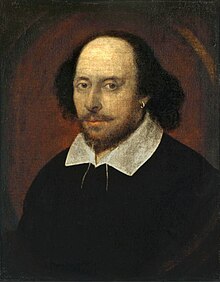
The Chandos portrait (held by the National Portrait Gallery, London) |
|
| Born |
Stratford-upon-Avon, England |
| Baptised | 26 April 1564 |
| Died | 23 April 1616 (aged 52)[a]
Stratford-upon-Avon, England |
| Resting place | Church of the Holy Trinity, Stratford-upon-Avon |
| Occupations |
|
| Years active | c. 1585–1613 |
| Era |
|
| Notable work |
|
| Movement | English Renaissance |
| Spouse |
Anne Hathaway (m. 1582) |
| Children |
|
| Parents |
|
| Signature | |
William Shakespeare (bapt. 26 April[b] 1564 – 23 April 1616)[c] was an English playwright, poet and actor. He is widely regarded as the greatest writer in the English language and the world’s pre-eminent dramatist.[2][3][4] He is often called England’s national poet and the «Bard of Avon» (or simply «the Bard»).[5][d] His extant works, including collaborations, consist of some 39 plays,[e] 154 sonnets, three long narrative poems, and a few other verses, some of uncertain authorship. His plays have been translated into every major living language and are performed more often than those of any other playwright.[7] He remains arguably the most influential writer in the English language, and his works continue to be studied and reinterpreted.
Shakespeare was born and raised in Stratford-upon-Avon, Warwickshire. At the age of 18, he married Anne Hathaway, with whom he had three children: Susanna, and twins Hamnet and Judith. Sometime between 1585 and 1592, he began a successful career in London as an actor, writer, and part-owner of a playing company called the Lord Chamberlain’s Men, later known as the King’s Men. At age 49 (around 1613), he appears to have retired to Stratford, where he died three years later. Few records of Shakespeare’s private life survive; this has stimulated considerable speculation about such matters as his physical appearance, his sexuality, his religious beliefs and whether the works attributed to him were written by others.[8][9][10]
Shakespeare produced most of his known works between 1589 and 1613.[11][12][f] His early plays were primarily comedies and histories and are regarded as some of the best works produced in these genres. He then wrote mainly tragedies until 1608, among them Hamlet, Romeo and Juliet, Othello, King Lear, and Macbeth, all considered to be among the finest works in the English language.[2][3][4] In the last phase of his life, he wrote tragicomedies (also known as romances) and collaborated with other playwrights.
Many of Shakespeare’s plays were published in editions of varying quality and accuracy in his lifetime. However, in 1623, John Heminges and Henry Condell, two fellow actors and friends of Shakespeare’s, published a more definitive text known as the First Folio, a posthumous collected edition of Shakespeare’s dramatic works that included all but two of his plays.[13] Its Preface was a prescient poem by Ben Jonson, a former rival of Shakespeare, that hailed Shakespeare with the now famous epithet: «not of an age, but for all time».[13]
Life
Early life
Shakespeare was the son of John Shakespeare, an alderman and a successful glover (glove-maker) originally from Snitterfield in Warwickshire, and Mary Arden, the daughter of an affluent landowning family.[14] He was born in Stratford-upon-Avon, where he was baptised on 26 April 1564. His date of birth is unknown, but is traditionally observed on 23 April, Saint George’s Day.[15] This date, which can be traced to William Oldys and George Steevens, has proved appealing to biographers because Shakespeare died on the same date in 1616.[16][17] He was the third of eight children, and the eldest surviving son.[18]
Although no attendance records for the period survive, most biographers agree that Shakespeare was probably educated at the King’s New School in Stratford,[19][20][21] a free school chartered in 1553,[22] about a quarter-mile (400 m) from his home. Grammar schools varied in quality during the Elizabethan era, but grammar school curricula were largely similar: the basic Latin text was standardised by royal decree,[23][24] and the school would have provided an intensive education in grammar based upon Latin classical authors.[25]
At the age of 18, Shakespeare married 26-year-old Anne Hathaway. The consistory court of the Diocese of Worcester issued a marriage licence on 27 November 1582. The next day, two of Hathaway’s neighbours posted bonds guaranteeing that no lawful claims impeded the marriage.[26] The ceremony may have been arranged in some haste since the Worcester chancellor allowed the marriage banns to be read once instead of the usual three times,[27][28] and six months after the marriage Anne gave birth to a daughter, Susanna, baptised 26 May 1583.[29] Twins, son Hamnet and daughter Judith, followed almost two years later and were baptised 2 February 1585.[30] Hamnet died of unknown causes at the age of 11 and was buried 11 August 1596.[31]
Shakespeare’s coat of arms, from the 1602 book The book of coates and creasts. Promptuarium armorum. It features spears as a pun on the family name.[g]
After the birth of the twins, Shakespeare left few historical traces until he is mentioned as part of the London theatre scene in 1592. The exception is the appearance of his name in the «complaints bill» of a law case before the Queen’s Bench court at Westminster dated Michaelmas Term 1588 and 9 October 1589.[32] Scholars refer to the years between 1585 and 1592 as Shakespeare’s «lost years».[33] Biographers attempting to account for this period have reported many apocryphal stories. Nicholas Rowe, Shakespeare’s first biographer, recounted a Stratford legend that Shakespeare fled the town for London to escape prosecution for deer poaching in the estate of local squire Thomas Lucy. Shakespeare is also supposed to have taken his revenge on Lucy by writing a scurrilous ballad about him.[34][35] Another 18th-century story has Shakespeare starting his theatrical career minding the horses of theatre patrons in London.[36] John Aubrey reported that Shakespeare had been a country schoolmaster.[37] Some 20th-century scholars suggested that Shakespeare may have been employed as a schoolmaster by Alexander Hoghton of Lancashire, a Catholic landowner who named a certain «William Shakeshafte» in his will.[38][39] Little evidence substantiates such stories other than hearsay collected after his death, and Shakeshafte was a common name in the Lancashire area.[40][41]
London and theatrical career
It is not known definitively when Shakespeare began writing, but contemporary allusions and records of performances show that several of his plays were on the London stage by 1592.[42] By then, he was sufficiently known in London to be attacked in print by the playwright Robert Greene in his Groats-Worth of Wit:
… there is an upstart Crow, beautified with our feathers, that with his Tiger’s heart wrapped in a Player’s hide, supposes he is as well able to bombast out a blank verse as the best of you: and being an absolute Johannes factotum, is in his own conceit the only Shake-scene in a country.[43]
Scholars differ on the exact meaning of Greene’s words,[43][44] but most agree that Greene was accusing Shakespeare of reaching above his rank in trying to match such university-educated writers as Christopher Marlowe, Thomas Nashe, and Greene himself (the so-called «University Wits»).[45] The italicised phrase parodying the line «Oh, tiger’s heart wrapped in a woman’s hide» from Shakespeare’s Henry VI, Part 3, along with the pun «Shake-scene», clearly identify Shakespeare as Greene’s target. As used here, Johannes Factotum («Jack of all trades») refers to a second-rate tinkerer with the work of others, rather than the more common «universal genius».[43][46]
Greene’s attack is the earliest surviving mention of Shakespeare’s work in the theatre. Biographers suggest that his career may have begun any time from the mid-1580s to just before Greene’s remarks.[47][48][49] After 1594, Shakespeare’s plays were performed only by the Lord Chamberlain’s Men, a company owned by a group of players, including Shakespeare, that soon became the leading playing company in London.[50] After the death of Queen Elizabeth in 1603, the company was awarded a royal patent by the new King James I, and changed its name to the King’s Men.[51]
«All the world’s a stage,
and all the men and women merely players:
they have their exits and their entrances;
and one man in his time plays many parts …»
—As You Like It, Act II, Scene 7, 139–142[52]
In 1599, a partnership of members of the company built their own theatre on the south bank of the River Thames, which they named the Globe. In 1608, the partnership also took over the Blackfriars indoor theatre. Extant records of Shakespeare’s property purchases and investments indicate that his association with the company made him a wealthy man,[53] and in 1597, he bought the second-largest house in Stratford, New Place, and in 1605, invested in a share of the parish tithes in Stratford.[54]
Some of Shakespeare’s plays were published in quarto editions, beginning in 1594, and by 1598, his name had become a selling point and began to appear on the title pages.[55][56][57] Shakespeare continued to act in his own and other plays after his success as a playwright. The 1616 edition of Ben Jonson’s Works names him on the cast lists for Every Man in His Humour (1598) and Sejanus His Fall (1603).[58] The absence of his name from the 1605 cast list for Jonson’s Volpone is taken by some scholars as a sign that his acting career was nearing its end.[47] The First Folio of 1623, however, lists Shakespeare as one of «the Principal Actors in all these Plays», some of which were first staged after Volpone, although one cannot know for certain which roles he played.[59] In 1610, John Davies of Hereford wrote that «good Will» played «kingly» roles.[60] In 1709, Rowe passed down a tradition that Shakespeare played the ghost of Hamlet’s father.[35] Later traditions maintain that he also played Adam in As You Like It, and the Chorus in Henry V,[61][62] though scholars doubt the sources of that information.[63]
Throughout his career, Shakespeare divided his time between London and Stratford. In 1596, the year before he bought New Place as his family home in Stratford, Shakespeare was living in the parish of St. Helen’s, Bishopsgate, north of the River Thames.[64][65] He moved across the river to Southwark by 1599, the same year his company constructed the Globe Theatre there.[64][66] By 1604, he had moved north of the river again, to an area north of St Paul’s Cathedral with many fine houses. There, he rented rooms from a French Huguenot named Christopher Mountjoy, a maker of women’s wigs and other headgear.[67][68]
Later years and death
Nicholas Rowe was the first biographer to record the tradition, repeated by Samuel Johnson, that Shakespeare retired to Stratford «some years before his death».[69][70] He was still working as an actor in London in 1608; in an answer to the sharers’ petition in 1635, Cuthbert Burbage stated that after purchasing the lease of the Blackfriars Theatre in 1608 from Henry Evans, the King’s Men «placed men players» there, «which were Heminges, Condell, Shakespeare, etc.».[71] However, it is perhaps relevant that the bubonic plague raged in London throughout 1609.[72][73] The London public playhouses were repeatedly closed during extended outbreaks of the plague (a total of over 60 months closure between May 1603 and February 1610),[74] which meant there was often no acting work. Retirement from all work was uncommon at that time.[75] Shakespeare continued to visit London during the years 1611–1614.[69] In 1612, he was called as a witness in Bellott v Mountjoy, a court case concerning the marriage settlement of Mountjoy’s daughter, Mary.[76][77] In March 1613, he bought a gatehouse in the former Blackfriars priory;[78] and from November 1614, he was in London for several weeks with his son-in-law, John Hall.[79] After 1610, Shakespeare wrote fewer plays, and none are attributed to him after 1613.[80] His last three plays were collaborations, probably with John Fletcher,[81] who succeeded him as the house playwright of the King’s Men. He retired in 1613, before the Globe Theatre burned down during the performance of Henry VIII on 29 June.[80]
Shakespeare died on 23 April 1616, at the age of 52.[h] He died within a month of signing his will, a document which he begins by describing himself as being in «perfect health». No extant contemporary source explains how or why he died. Half a century later, John Ward, the vicar of Stratford, wrote in his notebook: «Shakespeare, Drayton, and Ben Jonson had a merry meeting and, it seems, drank too hard, for Shakespeare died of a fever there contracted»,[82][83] not an impossible scenario since Shakespeare knew Jonson and Drayton. Of the tributes from fellow authors, one refers to his relatively sudden death: «We wondered, Shakespeare, that thou went’st so soon / From the world’s stage to the grave’s tiring room.»[84][i]
He was survived by his wife and two daughters. Susanna had married a physician, John Hall, in 1607,[85] and Judith had married Thomas Quiney, a vintner, two months before Shakespeare’s death.[86] Shakespeare signed his last will and testament on 25 March 1616; the following day, his new son-in-law, Thomas Quiney was found guilty of fathering an illegitimate son by Margaret Wheeler, who had died during childbirth. Thomas was ordered by the church court to do public penance, which would have caused much shame and embarrassment for the Shakespeare family.[86]
Shakespeare bequeathed the bulk of his large estate to his elder daughter Susanna[87] under stipulations that she pass it down intact to «the first son of her body».[88] The Quineys had three children, all of whom died without marrying.[89][90] The Halls had one child, Elizabeth, who married twice but died without children in 1670, ending Shakespeare’s direct line.[91][92] Shakespeare’s will scarcely mentions his wife, Anne, who was probably entitled to one-third of his estate automatically.[j] He did make a point, however, of leaving her «my second best bed», a bequest that has led to much speculation.[94][95][96] Some scholars see the bequest as an insult to Anne, whereas others believe that the second-best bed would have been the matrimonial bed and therefore rich in significance.[97]
Shakespeare’s grave, next to those of Anne Shakespeare, his wife, and Thomas Nash, the husband of his granddaughter
Shakespeare was buried in the chancel of the Holy Trinity Church two days after his death.[98][99] The epitaph carved into the stone slab covering his grave includes a curse against moving his bones, which was carefully avoided during restoration of the church in 2008:[100]
|
Good frend for Iesvs sake forbeare, |
Good friend, for Jesus’ sake forbear, |
Some time before 1623, a funerary monument was erected in his memory on the north wall, with a half-effigy of him in the act of writing. Its plaque compares him to Nestor, Socrates, and Virgil.[102] In 1623, in conjunction with the publication of the First Folio, the Droeshout engraving was published.[103] Shakespeare has been commemorated in many statues and memorials around the world, including funeral monuments in Southwark Cathedral and Poets’ Corner in Westminster Abbey.[104][105]
Plays
Procession of Characters from Shakespeare’s Plays by an unknown 19th-century artist
Most playwrights of the period typically collaborated with others at some point, as critics agree Shakespeare did, mostly early and late in his career.[106]
The first recorded works of Shakespeare are Richard III and the three parts of Henry VI, written in the early 1590s during a vogue for historical drama. Shakespeare’s plays are difficult to date precisely, however,[107][108] and studies of the texts suggest that Titus Andronicus, The Comedy of Errors, The Taming of the Shrew, and The Two Gentlemen of Verona may also belong to Shakespeare’s earliest period.[109][107] His first histories, which draw heavily on the 1587 edition of Raphael Holinshed’s Chronicles of England, Scotland, and Ireland,[110] dramatise the destructive results of weak or corrupt rule and have been interpreted as a justification for the origins of the Tudor dynasty.[111] The early plays were influenced by the works of other Elizabethan dramatists, especially Thomas Kyd and Christopher Marlowe, by the traditions of medieval drama, and by the plays of Seneca.[112][113][114] The Comedy of Errors was also based on classical models, but no source for The Taming of the Shrew has been found, though it is related to a separate play of the same name and may have derived from a folk story.[115][116] Like The Two Gentlemen of Verona, in which two friends appear to approve of rape,[117][118][119] the Shrew‘s story of the taming of a woman’s independent spirit by a man sometimes troubles modern critics, directors, and audiences.[120]
Shakespeare’s early classical and Italianate comedies, containing tight double plots and precise comic sequences, give way in the mid-1590s to the romantic atmosphere of his most acclaimed comedies.[121] A Midsummer Night’s Dream is a witty mixture of romance, fairy magic, and comic lowlife scenes.[122] Shakespeare’s next comedy, the equally romantic Merchant of Venice, contains a portrayal of the vengeful Jewish moneylender Shylock, which reflects dominant Elizabethan views but may appear derogatory to modern audiences.[123][124] The wit and wordplay of Much Ado About Nothing,[125] the charming rural setting of As You Like It, and the lively merrymaking of Twelfth Night complete Shakespeare’s sequence of great comedies.[126] After the lyrical Richard II, written almost entirely in verse, Shakespeare introduced prose comedy into the histories of the late 1590s, Henry IV, parts 1 and 2, and Henry V. His characters become more complex and tender as he switches deftly between comic and serious scenes, prose and poetry, and achieves the narrative variety of his mature work.[127][128][129] This period begins and ends with two tragedies: Romeo and Juliet, the famous romantic tragedy of sexually charged adolescence, love, and death;[130][131] and Julius Caesar— based on Sir Thomas North’s 1579 translation of Plutarch’s Parallel Lives—which introduced a new kind of drama.[132][133] According to Shakespearean scholar James Shapiro, in Julius Caesar, «the various strands of politics, character, inwardness, contemporary events, even Shakespeare’s own reflections on the act of writing, began to infuse each other».[134]
In the early 17th century, Shakespeare wrote the so-called «problem plays» Measure for Measure, Troilus and Cressida, and All’s Well That Ends Well and a number of his best known tragedies.[135][136] Many critics believe that Shakespeare’s greatest tragedies represent the peak of his art. The titular hero of one of Shakespeare’s greatest tragedies, Hamlet, has probably been discussed more than any other Shakespearean character, especially for his famous soliloquy which begins «To be or not to be; that is the question».[137] Unlike the introverted Hamlet, whose fatal flaw is hesitation, the heroes of the tragedies that followed, Othello and King Lear, are undone by hasty errors of judgement.[138] The plots of Shakespeare’s tragedies often hinge on such fatal errors or flaws, which overturn order and destroy the hero and those he loves.[139] In Othello, the villain Iago stokes Othello’s sexual jealousy to the point where he murders the innocent wife who loves him.[140][141] In King Lear, the old king commits the tragic error of giving up his powers, initiating the events which lead to the torture and blinding of the Earl of Gloucester and the murder of Lear’s youngest daughter Cordelia. According to the critic Frank Kermode, «the play…offers neither its good characters nor its audience any relief from its cruelty».[142][143][144] In Macbeth, the shortest and most compressed of Shakespeare’s tragedies,[145] uncontrollable ambition incites Macbeth and his wife, Lady Macbeth, to murder the rightful king and usurp the throne until their own guilt destroys them in turn.[146] In this play, Shakespeare adds a supernatural element to the tragic structure. His last major tragedies, Antony and Cleopatra and Coriolanus, contain some of Shakespeare’s finest poetry and were considered his most successful tragedies by the poet and critic T. S. Eliot.[147][148][149]
In his final period, Shakespeare turned to romance or tragicomedy and completed three more major plays: Cymbeline, The Winter’s Tale, and The Tempest, as well as the collaboration, Pericles, Prince of Tyre. Less bleak than the tragedies, these four plays are graver in tone than the comedies of the 1590s, but they end with reconciliation and the forgiveness of potentially tragic errors.[150] Some commentators have seen this change in mood as evidence of a more serene view of life on Shakespeare’s part, but it may merely reflect the theatrical fashion of the day.[151][152][153] Shakespeare collaborated on two further surviving plays, Henry VIII and The Two Noble Kinsmen, probably with John Fletcher.[154]
Performances
It is not clear for which companies Shakespeare wrote his early plays. The title page of the 1594 edition of Titus Andronicus reveals that the play had been acted by three different troupes.[155] After the plagues of 1592–93, Shakespeare’s plays were performed by his own company at The Theatre and the Curtain in Shoreditch, north of the Thames.[156] Londoners flocked there to see the first part of Henry IV, Leonard Digges recording, «Let but Falstaff come, Hal, Poins, the rest … and you scarce shall have a room».[157] When the company found themselves in dispute with their landlord, they pulled The Theatre down and used the timbers to construct the Globe Theatre, the first playhouse built by actors for actors, on the south bank of the Thames at Southwark.[158][159] The Globe opened in autumn 1599, with Julius Caesar one of the first plays staged. Most of Shakespeare’s greatest post-1599 plays were written for the Globe, including Hamlet, Othello, and King Lear.[158][160][161]
After the Lord Chamberlain’s Men were renamed the King’s Men in 1603, they entered a special relationship with the new King James. Although the performance records are patchy, the King’s Men performed seven of Shakespeare’s plays at court between 1 November 1604, and 31 October 1605, including two performances of The Merchant of Venice.[62] After 1608, they performed at the indoor Blackfriars Theatre during the winter and the Globe during the summer.[162] The indoor setting, combined with the Jacobean fashion for lavishly staged masques, allowed Shakespeare to introduce more elaborate stage devices. In Cymbeline, for example, Jupiter descends «in thunder and lightning, sitting upon an eagle: he throws a thunderbolt. The ghosts fall on their knees.»[163][164]
The actors in Shakespeare’s company included the famous Richard Burbage, William Kempe, Henry Condell and John Heminges. Burbage played the leading role in the first performances of many of Shakespeare’s plays, including Richard III, Hamlet, Othello, and King Lear.[165] The popular comic actor Will Kempe played the servant Peter in Romeo and Juliet and Dogberry in Much Ado About Nothing, among other characters.[166][167] He was replaced around 1600 by Robert Armin, who played roles such as Touchstone in As You Like It and the fool in King Lear.[168] In 1613, Sir Henry Wotton recorded that Henry VIII «was set forth with many extraordinary circumstances of pomp and ceremony».[169] On 29 June, however, a cannon set fire to the thatch of the Globe and burned the theatre to the ground, an event which pinpoints the date of a Shakespeare play with rare precision.[169]
Textual sources
In 1623, John Heminges and Henry Condell, two of Shakespeare’s friends from the King’s Men, published the First Folio, a collected edition of Shakespeare’s plays. It contained 36 texts, including 18 printed for the first time.[170] Many of the plays had already appeared in quarto versions—flimsy books made from sheets of paper folded twice to make four leaves.[171] No evidence suggests that Shakespeare approved these editions, which the First Folio describes as «stol’n and surreptitious copies».[172] Nor did Shakespeare plan or expect his works to survive in any form at all; those works likely would have faded into oblivion but for his friends’ spontaneous idea, after his death, to create and publish the First Folio.[173]
Alfred Pollard termed some of the pre-1623 versions as «bad quartos» because of their adapted, paraphrased or garbled texts, which may in places have been reconstructed from memory.[171][172][174] Where several versions of a play survive, each differs from the other. The differences may stem from copying or printing errors, from notes by actors or audience members, or from Shakespeare’s own papers.[175][176] In some cases, for example, Hamlet, Troilus and Cressida, and Othello, Shakespeare could have revised the texts between the quarto and folio editions. In the case of King Lear, however, while most modern editions do conflate them, the 1623 folio version is so different from the 1608 quarto that the Oxford Shakespeare prints them both, arguing that they cannot be conflated without confusion.[177]
Poems
In 1593 and 1594, when the theatres were closed because of plague, Shakespeare published two narrative poems on sexual themes, Venus and Adonis and The Rape of Lucrece. He dedicated them to Henry Wriothesley, Earl of Southampton. In Venus and Adonis, an innocent Adonis rejects the sexual advances of Venus; while in The Rape of Lucrece, the virtuous wife Lucrece is raped by the lustful Tarquin.[178] Influenced by Ovid’s Metamorphoses,[179] the poems show the guilt and moral confusion that result from uncontrolled lust.[180] Both proved popular and were often reprinted during Shakespeare’s lifetime. A third narrative poem, A Lover’s Complaint, in which a young woman laments her seduction by a persuasive suitor, was printed in the first edition of the Sonnets in 1609. Most scholars now accept that Shakespeare wrote A Lover’s Complaint. Critics consider that its fine qualities are marred by leaden effects.[181][182][183] The Phoenix and the Turtle, printed in Robert Chester’s 1601 Love’s Martyr, mourns the deaths of the legendary phoenix and his lover, the faithful turtle dove. In 1599, two early drafts of sonnets 138 and 144 appeared in The Passionate Pilgrim, published under Shakespeare’s name but without his permission.[181][183][184]
Sonnets
Title page from 1609 edition of Shake-Speares Sonnets
Published in 1609, the Sonnets were the last of Shakespeare’s non-dramatic works to be printed. Scholars are not certain when each of the 154 sonnets was composed, but evidence suggests that Shakespeare wrote sonnets throughout his career for a private readership.[185][186] Even before the two unauthorised sonnets appeared in The Passionate Pilgrim in 1599, Francis Meres had referred in 1598 to Shakespeare’s «sugred Sonnets among his private friends».[187] Few analysts believe that the published collection follows Shakespeare’s intended sequence.[188] He seems to have planned two contrasting series: one about uncontrollable lust for a married woman of dark complexion (the «dark lady»), and one about conflicted love for a fair young man (the «fair youth»). It remains unclear if these figures represent real individuals, or if the authorial «I» who addresses them represents Shakespeare himself, though Wordsworth believed that with the sonnets «Shakespeare unlocked his heart».[187][186]
«Shall I compare thee to a summer’s day?
Thou art more lovely and more temperate …»
—Lines from Shakespeare’s Sonnet 18.[189]
The 1609 edition was dedicated to a «Mr. W.H.», credited as «the only begetter» of the poems. It is not known whether this was written by Shakespeare himself or by the publisher, Thomas Thorpe, whose initials appear at the foot of the dedication page; nor is it known who Mr. W.H. was, despite numerous theories, or whether Shakespeare even authorised the publication.[190] Critics praise the Sonnets as a profound meditation on the nature of love, sexual passion, procreation, death, and time.[191]
Style
Shakespeare’s first plays were written in the conventional style of the day. He wrote them in a stylised language that does not always spring naturally from the needs of the characters or the drama.[192] The poetry depends on extended, sometimes elaborate metaphors and conceits, and the language is often rhetorical—written for actors to declaim rather than speak. The grand speeches in Titus Andronicus, in the view of some critics, often hold up the action, for example; and the verse in The Two Gentlemen of Verona has been described as stilted.[193][194]
Pity by William Blake, 1795, Tate Britain, is an illustration of two similes in Macbeth:
«And pity, like a naked new-born babe,
Striding the blast, or heaven’s cherubim, hors’d
Upon the sightless couriers of the air.»[195]
However, Shakespeare soon began to adapt the traditional styles to his own purposes. The opening soliloquy of Richard III has its roots in the self-declaration of Vice in medieval drama. At the same time, Richard’s vivid self-awareness looks forward to the soliloquies of Shakespeare’s mature plays.[196][197] No single play marks a change from the traditional to the freer style. Shakespeare combined the two throughout his career, with Romeo and Juliet perhaps the best example of the mixing of the styles.[198] By the time of Romeo and Juliet, Richard II, and A Midsummer Night’s Dream in the mid-1590s, Shakespeare had begun to write a more natural poetry. He increasingly tuned his metaphors and images to the needs of the drama itself.
Shakespeare’s standard poetic form was blank verse, composed in iambic pentameter. In practice, this meant that his verse was usually unrhymed and consisted of ten syllables to a line, spoken with a stress on every second syllable. The blank verse of his early plays is quite different from that of his later ones. It is often beautiful, but its sentences tend to start, pause, and finish at the end of lines, with the risk of monotony.[199] Once Shakespeare mastered traditional blank verse, he began to interrupt and vary its flow. This technique releases the new power and flexibility of the poetry in plays such as Julius Caesar and Hamlet. Shakespeare uses it, for example, to convey the turmoil in Hamlet’s mind:[200]
Sir, in my heart there was a kind of fighting
That would not let me sleep. Methought I lay
Worse than the mutines in the bilboes. Rashly—
And prais’d be rashness for it—let us know
Our indiscretion sometimes serves us well …— Hamlet, Act 5, Scene 2, 4–8[200]
After Hamlet, Shakespeare varied his poetic style further, particularly in the more emotional passages of the late tragedies. The literary critic A. C. Bradley described this style as «more concentrated, rapid, varied, and, in construction, less regular, not seldom twisted or elliptical».[201] In the last phase of his career, Shakespeare adopted many techniques to achieve these effects. These included run-on lines, irregular pauses and stops, and extreme variations in sentence structure and length.[202] In Macbeth, for example, the language darts from one unrelated metaphor or simile to another: «was the hope drunk/ Wherein you dressed yourself?» (1.7.35–38); «… pity, like a naked new-born babe/ Striding the blast, or heaven’s cherubim, hors’d/ Upon the sightless couriers of the air …» (1.7.21–25). The listener is challenged to complete the sense.[202] The late romances, with their shifts in time and surprising turns of plot, inspired a last poetic style in which long and short sentences are set against one another, clauses are piled up, subject and object are reversed, and words are omitted, creating an effect of spontaneity.[203]
Shakespeare combined poetic genius with a practical sense of the theatre.[204] Like all playwrights of the time, he dramatised stories from sources such as Plutarch and Holinshed.[205] He reshaped each plot to create several centres of interest and to show as many sides of a narrative to the audience as possible. This strength of design ensures that a Shakespeare play can survive translation, cutting, and wide interpretation without loss to its core drama.[206] As Shakespeare’s mastery grew, he gave his characters clearer and more varied motivations and distinctive patterns of speech. He preserved aspects of his earlier style in the later plays, however. In Shakespeare’s late romances, he deliberately returned to a more artificial style, which emphasised the illusion of theatre.[207][208]
Influence
Shakespeare’s work has made a significant and lasting impression on later theatre and literature. In particular, he expanded the dramatic potential of characterisation, plot, language, and genre.[209] Until Romeo and Juliet, for example, romance had not been viewed as a worthy topic for tragedy.[210] Soliloquies had been used mainly to convey information about characters or events, but Shakespeare used them to explore characters’ minds.[211] His work heavily influenced later poetry. The Romantic poets attempted to revive Shakespearean verse drama, though with little success. Critic George Steiner described all English verse dramas from Coleridge to Tennyson as «feeble variations on Shakespearean themes.»[212] John Milton, considered by many to be the most important English poet after Shakespeare, wrote in tribute: «Thou in our wonder and astonishment/ Has built thyself a live-long monument.»[213]
Shakespeare influenced novelists such as Thomas Hardy, William Faulkner, and Charles Dickens. The American novelist Herman Melville’s soliloquies owe much to Shakespeare; his Captain Ahab in Moby-Dick is a classic tragic hero, inspired by King Lear.[214] Scholars have identified 20,000 pieces of music linked to Shakespeare’s works. These include three operas by Giuseppe Verdi, Macbeth, Otello and Falstaff, whose critical standing compares with that of the source plays.[215] Shakespeare has also inspired many painters, including the Romantics and the Pre-Raphaelites. The Swiss Romantic artist Henry Fuseli, a friend of William Blake, even translated Macbeth into German.[216] The psychoanalyst Sigmund Freud drew on Shakespearean psychology, in particular, that of Hamlet, for his theories of human nature.[217]
In Shakespeare’s day, English grammar, spelling, and pronunciation were less standardised than they are now,[218] and his use of language helped shape modern English.[219] Samuel Johnson quoted him more often than any other author in his A Dictionary of the English Language, the first serious work of its type.[220] Expressions such as «with bated breath» (Merchant of Venice) and «a foregone conclusion» (Othello) have found their way into everyday English speech.[221][222]
Shakespeare’s influence extends far beyond his native England and the English language. His reception in Germany was particularly significant; as early as the 18th century Shakespeare was widely translated and popularised in Germany, and gradually became a «classic of the German Weimar era;» Christoph Martin Wieland was the first to produce complete translations of Shakespeare’s plays in any language.[223][224] Actor and theatre director Simon Callow writes, «this master, this titan, this genius, so profoundly British and so effortlessly universal, each different culture – German, Italian, Russian – was obliged to respond to the Shakespearean example; for the most part, they embraced it, and him, with joyous abandon, as the possibilities of language and character in action that he celebrated liberated writers across the continent. Some of the most deeply affecting productions of Shakespeare have been non-English, and non-European. He is that unique writer: he has something for everyone.»[225]
According to Guinness World Records, Shakespeare remains the world’s best-selling playwright, with sales of his plays and poetry believed to have achieved in excess of four billion copies in the almost 400 years since his death. He is also the third most translated author in history.[226]
Critical reputation
«He was not of an age, but for all time.»
—Ben Jonson[227]
Shakespeare was not revered in his lifetime, but he received a large amount of praise.[228][229] In 1598, the cleric and author Francis Meres singled him out from a group of English playwrights as «the most excellent» in both comedy and tragedy.[230][231] The authors of the Parnassus plays at St John’s College, Cambridge, numbered him with Chaucer, Gower, and Spenser.[232] In the First Folio, Ben Jonson called Shakespeare the «Soul of the age, the applause, delight, the wonder of our stage», although he had remarked elsewhere that «Shakespeare wanted art» (lacked skill).[227]
Between the Restoration of the monarchy in 1660 and the end of the 17th century, classical ideas were in vogue. As a result, critics of the time mostly rated Shakespeare below John Fletcher and Ben Jonson.[233] Thomas Rymer, for example, condemned Shakespeare for mixing the comic with the tragic. Nevertheless, poet and critic John Dryden rated Shakespeare highly, saying of Jonson, «I admire him, but I love Shakespeare».[234] He also famously remarked that Shakespeare «was naturally learned; he needed not the spectacles of books to read nature; he looked inwards, and found her there.»[235] For several decades, Rymer’s view held sway. But during the 18th century, critics began to respond to Shakespeare on his own terms and, like Dryden, to acclaim what they termed his natural genius. A series of scholarly editions of his work, notably those of Samuel Johnson in 1765 and Edmond Malone in 1790, added to his growing reputation.[236][237] By 1800, he was firmly enshrined as the national poet.[238] In the 18th and 19th centuries, his reputation also spread abroad. Among those who championed him were the writers Voltaire, Goethe, Stendhal, and Victor Hugo.[239][l]
A garlanded statue of William Shakespeare in Lincoln Park, Chicago, typical of many created in the 19th and early 20th centuries
During the Romantic era, Shakespeare was praised by the poet and literary philosopher Samuel Taylor Coleridge, and the critic August Wilhelm Schlegel translated his plays in the spirit of German Romanticism.[241] In the 19th century, critical admiration for Shakespeare’s genius often bordered on adulation.[242] «This King Shakespeare,» the essayist Thomas Carlyle wrote in 1840, «does not he shine, in crowned sovereignty, over us all, as the noblest, gentlest, yet strongest of rallying signs; indestructible».[243] The Victorians produced his plays as lavish spectacles on a grand scale.[244] The playwright and critic George Bernard Shaw mocked the cult of Shakespeare worship as «bardolatry», claiming that the new naturalism of Ibsen’s plays had made Shakespeare obsolete.[245]
The modernist revolution in the arts during the early 20th century, far from discarding Shakespeare, eagerly enlisted his work in the service of the avant-garde. The Expressionists in Germany and the Futurists in Moscow mounted productions of his plays. Marxist playwright and director Bertolt Brecht devised an epic theatre under the influence of Shakespeare. The poet and critic T. S. Eliot argued against Shaw that Shakespeare’s «primitiveness» in fact made him truly modern.[246] Eliot, along with G. Wilson Knight and the school of New Criticism, led a movement towards a closer reading of Shakespeare’s imagery. In the 1950s, a wave of new critical approaches replaced modernism and paved the way for post-modern studies of Shakespeare.[247] By the 1980s, Shakespeare studies were open to movements such as structuralism, feminism, New Historicism, African-American studies, and queer studies.[248][249] Comparing Shakespeare’s accomplishments to those of leading figures in philosophy and theology, Harold Bloom wrote, «Shakespeare was larger than Plato and than St. Augustine. He encloses us because we see with his fundamental perceptions.»[250]
Works
Classification of the plays
Shakespeare’s works include the 36 plays printed in the First Folio of 1623, listed according to their folio classification as comedies, histories, and tragedies.[251] Two plays not included in the First Folio, The Two Noble Kinsmen and Pericles, Prince of Tyre, are now accepted as part of the canon, with today’s scholars agreeing that Shakespeare made major contributions to the writing of both.[252][253] No Shakespearean poems were included in the First Folio.
In the late 19th century, Edward Dowden classified four of the late comedies as romances, and though many scholars prefer to call them tragicomedies, Dowden’s term is often used.[254][255] In 1896, Frederick S. Boas coined the term «problem plays» to describe four plays: All’s Well That Ends Well, Measure for Measure, Troilus and Cressida, and Hamlet.[256] «Dramas as singular in theme and temper cannot be strictly called comedies or tragedies», he wrote. «We may, therefore, borrow a convenient phrase from the theatre of today and class them together as Shakespeare’s problem plays.»[257] The term, much debated and sometimes applied to other plays, remains in use, though Hamlet is definitively classed as a tragedy.[258][259][260]
Speculation
Around 230 years after Shakespeare’s death, doubts began to be expressed about the authorship of the works attributed to him.[261] Proposed alternative candidates include Francis Bacon, Christopher Marlowe, and Edward de Vere, 17th Earl of Oxford.[262] Several «group theories» have also been proposed.[263] All but a few Shakespeare scholars and literary historians consider it a fringe theory, with only a small minority of academics who believe that there is reason to question the traditional attribution,[264] but interest in the subject, particularly the Oxfordian theory of Shakespeare authorship, continues into the 21st century.[265][266][267]
Religion
Shakespeare conformed to the official state religion,[m] but his private views on religion have been the subject of debate. Shakespeare’s will uses a Protestant formula, and he was a confirmed member of the Church of England, where he was married, his children were baptised, and where he is buried. Some scholars claim that members of Shakespeare’s family were Catholics, at a time when practising Catholicism in England was against the law.[269] Shakespeare’s mother, Mary Arden, certainly came from a pious Catholic family. The strongest evidence might be a Catholic statement of faith signed by his father, John Shakespeare, found in 1757 in the rafters of his former house in Henley Street. However, the document is now lost and scholars differ as to its authenticity.[270][271] In 1591, the authorities reported that John Shakespeare had missed church «for fear of process for debt», a common Catholic excuse.[272][273][274] In 1606, the name of William’s daughter Susanna appears on a list of those who failed to attend Easter communion in Stratford.[272][273][274] Other authors argue that there is a lack of evidence about Shakespeare’s religious beliefs. Scholars find evidence both for and against Shakespeare’s Catholicism, Protestantism, or lack of belief in his plays, but the truth may be impossible to prove.[275][276]
Sexuality
Few details of Shakespeare’s sexuality are known. At 18, he married 26-year-old Anne Hathaway, who was pregnant. Susanna, the first of their three children, was born six months later on 26 May 1583. Over the centuries, some readers have posited that Shakespeare’s sonnets are autobiographical,[277] and point to them as evidence of his love for a young man. Others read the same passages as the expression of intense friendship rather than romantic love.[278][279][280] The 26 so-called «Dark Lady» sonnets, addressed to a married woman, are taken as evidence of heterosexual liaisons.[281]
Portraiture
No written contemporary description of Shakespeare’s physical appearance survives, and no evidence suggests that he ever commissioned a portrait, so the Droeshout engraving, which Ben Jonson approved of as a good likeness,[282] and his Stratford monument provide perhaps the best evidence of his appearance. From the 18th century, the desire for authentic Shakespeare portraits fuelled claims that various surviving pictures depicted Shakespeare. That demand also led to the production of several fake portraits, as well as misattributions, repaintings, and relabelling of portraits of other people.[283]
See also
- Outline of William Shakespeare
- English Renaissance theatre
- Spelling of Shakespeare’s name
- World Shakespeare Bibliography
Notes and references
Notes
- ^ His monument states that he was in his 53rd year at death, i.e. 52 years old.
- ^ The concept that Shakespeare was born on 23 April, contrary to belief, is a tradition, and not a fact; see the section on Shakespeare’s life below.
- ^ Dates follow the Julian calendar, used in England throughout Shakespeare’s lifespan, but with the start of the year adjusted to 1 January (see Old Style and New Style dates). Under the Gregorian calendar, adopted in Catholic countries in 1582, Shakespeare died on 3 May.[1]
- ^ The «national cult» of Shakespeare, and the «bard» identification, dates from September 1769, when the actor David Garrick organised a week-long carnival at Stratford to mark the town council awarding him the freedom of the town. In addition to presenting the town with a statue of Shakespeare, Garrick composed a doggerel verse, lampooned in the London newspapers, naming the banks of the Avon as the birthplace of the «matchless Bard».[6]
- ^ The exact figures are unknown. See Shakespeare’s collaborations and Shakespeare Apocrypha for further details.
- ^ Individual play dates and precise writing span are unknown. See Chronology of Shakespeare’s plays for further details.
- ^ The crest is a silver falcon supporting a spear, while the motto is Non Sanz Droict (French for «not without right»). This motto is still used by Warwickshire County Council, in reference to Shakespeare.
- ^ Inscribed in Latin on his funerary monument: AETATIS 53 DIE 23 APR (In his 53rd year he died 23 April).
- ^ Verse by James Mabbe printed in the First Folio.[84]
- ^ Charles Knight, 1842, in his notes on Twelfth Night.[93]
- ^ In the scribal abbreviations ye for the (3rd line) and yt for that (3rd and 4th lines) the letter y represents th: see thorn.
- ^ Grady cites Voltaire’s Philosophical Letters (1733); Goethe’s Wilhelm Meister’s Apprenticeship (1795); Stendhal’s two-part pamphlet Racine et Shakespeare (1823–25); and Victor Hugo’s prefaces to Cromwell (1827) and William Shakespeare (1864).[240]
- ^ For example, A.L. Rowse, the 20th-century Shakespeare scholar, was emphatic: «He died, as he had lived, a conforming member of the Church of England. His will made that perfectly clear—in facts, puts it beyond dispute, for it uses the Protestant formula.»[268]
References
- ^ Schoenbaum 1987, p. xv.
- ^ a b Greenblatt 2005, p. 11.
- ^ a b Bevington 2002, pp. 1–3.
- ^ a b Wells 1997, p. 399.
- ^ Dobson 1992, pp. 185–186.
- ^ McIntyre 1999, pp. 412–432.
- ^ Craig 2003, p. 3.
- ^ Shapiro 2005, pp. xvii–xviii.
- ^ Schoenbaum 1991, pp. 41, 66, 397–398, 402, 409.
- ^ Taylor 1990, pp. 145, 210–223, 261–265.
- ^ Chambers 1930a, pp. 270–271.
- ^ Taylor 1987, pp. 109–134.
- ^ a b Greenblatt & Abrams 2012, p. 1168.
- ^ Schoenbaum 1987, pp. 14–22.
- ^ Schoenbaum 1987, pp. 24–26.
- ^ Schoenbaum 1987, pp. 24, 296.
- ^ Honan 1998, pp. 15–16.
- ^ Schoenbaum 1987, pp. 23–24.
- ^ Schoenbaum 1987, pp. 62–63.
- ^ Ackroyd 2006, p. 53.
- ^ Wells et al. 2005, pp. xv–xvi.
- ^ Baldwin 1944, p. 464.
- ^ Baldwin 1944, pp. 179–180, 183.
- ^ Cressy 1975, pp. 28–29.
- ^ Baldwin 1944, p. 117.
- ^ Schoenbaum 1987, pp. 77–78.
- ^ Wood 2003, p. 84.
- ^ Schoenbaum 1987, pp. 78–79.
- ^ Schoenbaum 1987, p. 93.
- ^ Schoenbaum 1987, p. 94.
- ^ Schoenbaum 1987, p. 224.
- ^ Bate 2008, p. 314.
- ^ Schoenbaum 1987, p. 95.
- ^ Schoenbaum 1987, pp. 97–108.
- ^ a b Rowe 1709.
- ^ Schoenbaum 1987, pp. 144–145.
- ^ Schoenbaum 1987, pp. 110–111.
- ^ Honigmann 1999, p. 1.
- ^ Wells et al. 2005, p. xvii.
- ^ Honigmann 1999, pp. 95–117.
- ^ Wood 2003, pp. 97–109.
- ^ Chambers 1930a, pp. 287, 292.
- ^ a b c Greenblatt 2005, p. 213.
- ^ Schoenbaum 1987, p. 153.
- ^ Ackroyd 2006, p. 176.
- ^ Schoenbaum 1987, p. 151–153.
- ^ a b Wells 2006, p. 28.
- ^ Schoenbaum 1987, pp. 144–146.
- ^ Chambers 1930a, p. 59.
- ^ Schoenbaum 1987, p. 184.
- ^ Chambers 1923, pp. 208–209.
- ^ Wells et al. 2005, p. 666.
- ^ Chambers 1930b, pp. 67–71.
- ^ Bentley 1961, p. 36.
- ^ Schoenbaum 1987, p. 188.
- ^ Kastan 1999, p. 37.
- ^ Knutson 2001, p. 17.
- ^ Adams 1923, p. 275.
- ^ Schoenbaum 1987, p. 200.
- ^ Schoenbaum 1987, pp. 200–201.
- ^ Ackroyd 2006, p. 357.
- ^ a b Wells et al. 2005, p. xxii.
- ^ Schoenbaum 1987, pp. 202–203.
- ^ a b Hales 1904, pp. 401–402.
- ^ Honan 1998, p. 121.
- ^ Shapiro 2005, p. 122.
- ^ Honan 1998, p. 325.
- ^ Greenblatt 2005, p. 405.
- ^ a b Ackroyd 2006, p. 476.
- ^ Wood 1806, pp. ix–x, lxxii.
- ^ Smith 1964, p. 558.
- ^ Ackroyd 2006, p. 477.
- ^ Barroll 1991, pp. 179–182.
- ^ Bate 2008, pp. 354–355.
- ^ Honan 1998, pp. 382–383.
- ^ Honan 1998, p. 326.
- ^ Ackroyd 2006, pp. 462–464.
- ^ Schoenbaum 1987, pp. 272–274.
- ^ Honan 1998, p. 387.
- ^ a b Schoenbaum 1987, p. 279.
- ^ Honan 1998, pp. 375–378.
- ^ Schoenbaum 1991, p. 78.
- ^ Rowse 1963, p. 453.
- ^ a b Kinney 2012, p. 11.
- ^ Schoenbaum 1987, p. 287.
- ^ a b Schoenbaum 1987, pp. 292–294.
- ^ Schoenbaum 1987, p. 304.
- ^ Honan 1998, pp. 395–396.
- ^ Chambers 1930b, pp. 8, 11, 104.
- ^ Schoenbaum 1987, p. 296.
- ^ Chambers 1930b, pp. 7, 9, 13.
- ^ Schoenbaum 1987, pp. 289, 318–319.
- ^ Schoenbaum 1991, p. 275.
- ^ Ackroyd 2006, p. 483.
- ^ Frye 2005, p. 16.
- ^ Greenblatt 2005, pp. 145–146.
- ^ Schoenbaum 1987, pp. 301–303.
- ^ Schoenbaum 1987, pp. 306–307.
- ^ Wells et al. 2005, p. xviii.
- ^ BBC News 2008.
- ^ Schoenbaum 1987, p. 306.
- ^ Schoenbaum 1987, pp. 308–310.
- ^ Cooper 2006, p. 48.
- ^ Westminster Abbey n.d.
- ^ Southwark Cathedral n.d.
- ^ Thomson 2003, p. 49.
- ^ a b Frye 2005, p. 9.
- ^ Honan 1998, p. 166.
- ^ Schoenbaum 1987, pp. 159–161.
- ^ Dutton & Howard 2003, p. 147.
- ^ Ribner 2005, pp. 154–155.
- ^ Frye 2005, p. 105.
- ^ Ribner 2005, p. 67.
- ^ Bednarz 2004, p. 100.
- ^ Honan 1998, p. 136.
- ^ Schoenbaum 1987, p. 166.
- ^ Frye 2005, p. 91.
- ^ Honan 1998, pp. 116–117.
- ^ Werner 2001, pp. 96–100.
- ^ Friedman 2006, p. 159.
- ^ Ackroyd 2006, p. 235.
- ^ Wood 2003, pp. 161–162.
- ^ Wood 2003, pp. 205–206.
- ^ Honan 1998, p. 258.
- ^ Ackroyd 2006, p. 359.
- ^ Ackroyd 2006, pp. 362–383.
- ^ Shapiro 2005, p. 150.
- ^ Gibbons 1993, p. 1.
- ^ Ackroyd 2006, p. 356.
- ^ Wood 2003, p. 161.
- ^ Honan 1998, p. 206.
- ^ Ackroyd 2006, pp. 353, 358.
- ^ Shapiro 2005, pp. 151–153.
- ^ Shapiro 2005, p. 151.
- ^ Bradley 1991, p. 85.
- ^ Muir 2005, pp. 12–16.
- ^ Bradley 1991, p. 94.
- ^ Bradley 1991, p. 86.
- ^ Bradley 1991, pp. 40, 48.
- ^ Bradley 1991, pp. 42, 169, 195.
- ^ Greenblatt 2005, p. 304.
- ^ Bradley 1991, p. 226.
- ^ Ackroyd 2006, p. 423.
- ^ Kermode 2004, pp. 141–142.
- ^ McDonald 2006, pp. 43–46.
- ^ Bradley 1991, p. 306.
- ^ Ackroyd 2006, p. 444.
- ^ McDonald 2006, pp. 69–70.
- ^ Eliot 1934, p. 59.
- ^ Dowden 1881, p. 57.
- ^ Dowden 1881, p. 60.
- ^ Frye 2005, p. 123.
- ^ McDonald 2006, p. 15.
- ^ Wells et al. 2005, pp. 1247, 1279.
- ^ Wells et al. 2005, p. xx.
- ^ Wells et al. 2005, p. xxi.
- ^ Shapiro 2005, p. 16.
- ^ a b Foakes 1990, p. 6.
- ^ Shapiro 2005, pp. 125–131.
- ^ Nagler 1958, p. 7.
- ^ Shapiro 2005, pp. 131–132.
- ^ Foakes 1990, p. 33.
- ^ Ackroyd 2006, p. 454.
- ^ Holland 2000, p. xli.
- ^ Ringler 1997, p. 127.
- ^ Schoenbaum 1987, p. 210.
- ^ Chambers 1930a, p. 341.
- ^ Shapiro 2005, pp. 247–249.
- ^ a b Wells et al. 2005, p. 1247.
- ^ Wells et al. 2005, p. xxxvii.
- ^ a b Wells et al. 2005, p. xxxiv.
- ^ a b Pollard 1909, p. xi.
- ^ Mays & Swanson 2016.
- ^ Maguire 1996, p. 28.
- ^ Bowers 1955, pp. 8–10.
- ^ Wells et al. 2005, pp. xxxiv–xxxv.
- ^ Wells et al. 2005, pp. 909, 1153.
- ^ Roe 2006, p. 21.
- ^ Frye 2005, p. 288.
- ^ Roe 2006, pp. 3, 21.
- ^ a b Roe 2006, p. 1.
- ^ Jackson 2004, pp. 267–294.
- ^ a b Honan 1998, p. 289.
- ^ Schoenbaum 1987, p. 327.
- ^ Wood 2003, p. 178.
- ^ a b Schoenbaum 1987, p. 180.
- ^ a b Honan 1998, p. 180.
- ^ Schoenbaum 1987, p. 268.
- ^ Mowat & Werstine n.d.
- ^ Schoenbaum 1987, pp. 268–269.
- ^ Wood 2003, p. 177.
- ^ Clemen 2005a, p. 150.
- ^ Frye 2005, pp. 105, 177.
- ^ Clemen 2005b, p. 29.
- ^ de Sélincourt 1909, p. 174.
- ^ Brooke 2004, p. 69.
- ^ Bradbrook 2004, p. 195.
- ^ Clemen 2005b, p. 63.
- ^ Frye 2005, p. 185.
- ^ a b Wright 2004, p. 868.
- ^ Bradley 1991, p. 91.
- ^ a b McDonald 2006, pp. 42–46.
- ^ McDonald 2006, pp. 36, 39, 75.
- ^ Gibbons 1993, p. 4.
- ^ Gibbons 1993, pp. 1–4.
- ^ Gibbons 1993, pp. 1–7, 15.
- ^ McDonald 2006, p. 13.
- ^ Meagher 2003, p. 358.
- ^ Chambers 1944, p. 35.
- ^ Levenson 2000, pp. 49–50.
- ^ Clemen 1987, p. 179.
- ^ Steiner 1996, p. 145.
- ^ Foundation, Poetry (6 January 2023). «On Shakespeare. 1630 by John Milton». Poetry Foundation. Retrieved 6 January 2023.
- ^ Bryant 1998, p. 82.
- ^ Gross 2003, pp. 641–642.
- ^ Paraisz 2006, p. 130.
- ^ Bloom 1995, p. 346.
- ^ Cercignani 1981.
- ^ Crystal 2001, pp. 55–65, 74.
- ^ Wain 1975, p. 194.
- ^ Johnson 2002, p. 12.
- ^ Crystal 2001, p. 63.
- ^ «How Shakespeare was turned into a German». DW.com. 22 April 2016.
- ^ «Unser Shakespeare: Germans’ mad obsession with the Bard». The Local. 22 April 2016.
- ^ «Simon Callow: What the Dickens? Well, William Shakespeare was the greatest after all…» The Independent. Retrieved 2 September 2020.
- ^ «William Shakespeare:Ten startling Great Bard-themed world records». Guinness World Records. 23 April 2014.
- ^ a b Jonson 1996, p. 10.
- ^ Dominik 1988, p. 9.
- ^ Grady 2001b, p. 267.
- ^ Grady 2001b, p. 265.
- ^ Greer 1986, p. 9.
- ^ Grady 2001b, p. 266.
- ^ Grady 2001b, p. 269.
- ^ Dryden 1889, p. 71.
- ^ «John Dryden (1631-1700). Shakespeare. Beaumont and Fletcher. Ben Jonson. Vol. III. Seventeenth Century. Henry Craik, ed. 1916. English Prose». www.bartleby.com. Retrieved 20 July 2022.
- ^ Grady 2001b, pp. 270–272.
- ^ Levin 1986, p. 217.
- ^ Grady 2001b, p. 270.
- ^ Grady 2001b, pp. 272–74.
- ^ Grady 2001b, pp. 272–274.
- ^ Levin 1986, p. 223.
- ^ Sawyer 2003, p. 113.
- ^ Carlyle 1841, p. 161.
- ^ Schoch 2002, pp. 58–59.
- ^ Grady 2001b, p. 276.
- ^ Grady 2001a, pp. 22–26.
- ^ Grady 2001a, p. 24.
- ^ Grady 2001a, p. 29.
- ^ Drakakis 1985, pp. 16–17, 23–25.
- ^ Bloom 2008, p. xii.
- ^ Boyce 1996, pp. 91, 193, 513..
- ^ Kathman 2003, p. 629.
- ^ Boyce 1996, p. 91.
- ^ Edwards 1958, pp. 1–10.
- ^ Snyder & Curren-Aquino 2007.
- ^ Schanzer 1963, pp. 1–10.
- ^ Boas 1896, p. 345.
- ^ Schanzer 1963, p. 1.
- ^ Bloom 1999, pp. 325–380.
- ^ Berry 2005, p. 37.
- ^ Shapiro 2010, pp. 77–78.
- ^ Gibson 2005, pp. 48, 72, 124.
- ^ McMichael & Glenn 1962, p. 56.
- ^ The New York Times 2007.
- ^ Kathman 2003, pp. 620, 625–626.
- ^ Love 2002, pp. 194–209.
- ^ Schoenbaum 1991, pp. 430–440.
- ^ Rowse 1988, p. 240.
- ^ Pritchard 1979, p. 3.
- ^ Wood 2003, pp. 75–78.
- ^ Ackroyd 2006, pp. 22–23.
- ^ a b Wood 2003, p. 78.
- ^ a b Ackroyd 2006, p. 416.
- ^ a b Schoenbaum 1987, pp. 41–42, 286.
- ^ Wilson 2004, p. 34.
- ^ Shapiro 2005, p. 167.
- ^ Lee 1900, p. 55.
- ^ Casey 1998.
- ^ Pequigney 1985.
- ^ Evans 1996, p. 132.
- ^ Fort 1927, pp. 406–414.
- ^ Cooper 2006, pp. 48, 57.
- ^ Schoenbaum 1981, p. 190.
Sources
- Ackroyd, Peter (2006). Shakespeare: The Biography. London: Vintage. ISBN 978-0-7493-8655-9.
- Adams, Joseph Quincy (1923). A Life of William Shakespeare. Boston: Houghton Mifflin. OCLC 1935264.
- Baldwin, T.W. (1944). William Shakspere’s Small Latine & Lesse Greek. Vol. 1. Urbana, Ill: University of Illinois Press. OCLC 359037.
- Barroll, Leeds (1991). Politics, Plague, and Shakespeare’s Theater: The Stuart Years. Ithaca: Cornell University Press. ISBN 978-0-8014-2479-3.
- Bate, Jonathan (2008). The Soul of the Age. London: Penguin. ISBN 978-0-670-91482-1.
- «Bard’s ‘cursed’ tomb is revamped». BBC News. 28 May 2008. Retrieved 23 April 2010.
- Bednarz, James P. (2004). «Marlowe and the English literary scene». In Cheney, Patrick Gerard (ed.). The Cambridge Companion to Christopher Marlowe. Cambridge: Cambridge University Press. pp. 90–105. doi:10.1017/CCOL0521820340. ISBN 978-0-511-99905-5 – via Cambridge Core.
- Bentley, G.E. (1961). Shakespeare: A Biographical Handbook. New Haven: Yale University Press. ISBN 978-0-313-25042-2. OCLC 356416.
- Berry, Ralph (2005). Changing Styles in Shakespeare. London: Routledge. ISBN 978-0-415-35316-8.
- Bevington, David (2002). Shakespeare. Oxford: Blackwell. ISBN 978-0-631-22719-9.
- Bloom, Harold (1995). The Western Canon: The Books and School of the Ages. New York: Riverhead Books. ISBN 978-1-57322-514-4.
- Bloom, Harold (1999). Shakespeare: The Invention of the Human. New York: Riverhead Books. ISBN 978-1-57322-751-3.
- Bloom, Harold (2008). Heims, Neil (ed.). King Lear. Bloom’s Shakespeare Through the Ages. Bloom’s Literary Criticism. ISBN 978-0-7910-9574-4.
- Boas, Frederick S. (1896). Shakspere and His Predecessors. The University series. New York: Charles Scribner’s Sons. hdl:2027/uc1.32106001899191. OL 20577303M.
- Bowers, Fredson (1955). On Editing Shakespeare and the Elizabethan Dramatists. Philadelphia: University of Pennsylvania Press. OCLC 2993883.
- Boyce, Charles (1996). Dictionary of Shakespeare. Ware, Herts, UK: Wordsworth. ISBN 978-1-85326-372-9.
- Bradbrook, M.C. (2004). «Shakespeare’s Recollection of Marlowe». In Edwards, Philip; Ewbank, Inga-Stina; Hunter, G.K. (eds.). Shakespeare’s Styles: Essays in Honour of Kenneth Muir. Cambridge: Cambridge University Press. pp. 191–204. ISBN 978-0-521-61694-2.
- Bradley, A.C. (1991). Shakespearean Tragedy: Lectures on Hamlet, Othello, King Lear and Macbeth. London: Penguin. ISBN 978-0-14-053019-3.
- Brooke, Nicholas (2004). «Language and Speaker in Macbeth». In Edwards, Philip; Ewbank, Inga-Stina; Hunter, G.K. (eds.). Shakespeare’s Styles: Essays in Honour of Kenneth Muir. Cambridge: Cambridge University Press. pp. 67–78. ISBN 978-0-521-61694-2.
- Bryant, John (1998). «Moby-Dick as Revolution». In Levine, Robert Steven (ed.). The Cambridge Companion to Herman Melville. Cambridge: Cambridge University Press. pp. 65–90. doi:10.1017/CCOL0521554772. ISBN 978-1-139-00037-6 – via Cambridge Core.
- Carlyle, Thomas (1841). On Heroes, Hero-Worship, and The Heroic in History. London: James Fraser. hdl:2027/hvd.hnlmmi. OCLC 17473532. OL 13561584M.
- Casey, Charles (1998). «Was Shakespeare gay? Sonnet 20 and the politics of pedagogy». College Literature. 25 (3): 35–51. JSTOR 25112402.
- Cercignani, Fausto (1981). Shakespeare’s Works and Elizabethan Pronunciation. Oxford: Clarendon Press. ISBN 978-0-19-811937-1.
- Chambers, E.K. (1923). The Elizabethan Stage. Vol. 2. Oxford: Clarendon Press. ISBN 978-0-19-811511-3. OCLC 336379.
- Chambers, E.K. (1930a). William Shakespeare: A Study of Facts and Problems. Vol. 1. Oxford: Clarendon Press. ISBN 978-0-19-811774-2. OCLC 353406.
- Chambers, E.K. (1930b). William Shakespeare: A Study of Facts and Problems. Vol. 2. Oxford: Clarendon Press. ISBN 978-0-19-811774-2. OCLC 353406.
- Chambers, E.K. (1944). Shakespearean Gleanings. Oxford: Oxford University Press. ISBN 978-0-8492-0506-4. OCLC 2364570.
- Clemen, Wolfgang (1987). Shakespeare’s Soliloquies. London: Routledge. ISBN 978-0-415-35277-2.
- Clemen, Wolfgang (2005a). Shakespeare’s Dramatic Art: Collected Essays. New York: Routledge. ISBN 978-0-415-35278-9.
- Clemen, Wolfgang (2005b). Shakespeare’s Imagery. London: Routledge. ISBN 978-0-415-35280-2.
- Cooper, Tarnya (2006). Searching for Shakespeare. Yale University Press. ISBN 978-0-300-11611-3.
- Craig, Leon Harold (2003). Of Philosophers and Kings: Political Philosophy in Shakespeare’s Macbeth and King Lear. Toronto: University of Toronto Press. ISBN 978-0-8020-8605-1.
- Cressy, David (1975). Education in Tudor and Stuart England. New York: St Martin’s Press. ISBN 978-0-7131-5817-5. OCLC 2148260.
- Crystal, David (2001). The Cambridge Encyclopedia of the English Language. Cambridge: Cambridge University Press. ISBN 978-0-521-40179-1.
- Dobson, Michael (1992). The Making of the National Poet: Shakespeare, Adaptation and Authorship, 1660–1769. Oxford: Oxford University Press. ISBN 978-0-19-818323-5.
- Dominik, Mark (1988). Shakespeare–Middleton Collaborations. Beaverton, OR: Alioth Press. ISBN 978-0-945088-01-1.
- Dowden, Edward (1881). Shakspere. New York: D. Appleton & Company. OCLC 8164385. OL 6461529M.
- Drakakis, John (1985). «Introduction». In Drakakis, John (ed.). Alternative Shakespeares. New York: Methuen. pp. 1–25. ISBN 978-0-416-36860-4.
- Dryden, John (1889). Arnold, Thomas (ed.). Dryden: An Essay of Dramatic Poesy. Oxford: Clarendon Press. hdl:2027/umn.31951t00074232s. ISBN 978-81-7156-323-4. OCLC 7847292. OL 23752217M.
- Dutton, Richard; Howard, Jean E. (2003). A Companion to Shakespeare’s Works: The Histories. Vol. II. Oxford: Blackwell. ISBN 978-0-631-22633-8.
- Edwards, Phillip (1958). Shakespeare’s Romances: 1900–1957. Shakespeare Survey. Vol. 11. Cambridge: Cambridge University Press. pp. 1–18. doi:10.1017/CCOL0521064244.001. ISBN 978-1-139-05291-7 – via Cambridge Core.
- Eliot, T.S. (1934). Elizabethan Essays. London: Faber & Faber. ISBN 978-0-15-629051-7. OCLC 9738219.
- Evans, G. Blakemore, ed. (1996). The Sonnets. The New Cambridge Shakespeare. Vol. 26. Cambridge: Cambridge University Press. ISBN 978-0-521-22225-9.
- Foakes, R.A. (1990). «Playhouses and players». In Braunmuller, A.R.; Hattaway, Michael (eds.). The Cambridge Companion to English Renaissance Drama. Cambridge: Cambridge University Press. pp. 1–52. ISBN 978-0-521-38662-3.
- Fort, J.A. (October 1927). «The Story Contained in the Second Series of Shakespeare’s Sonnets». The Review of English Studies. Original Series. III (12): 406–414. doi:10.1093/res/os-III.12.406. ISSN 0034-6551 – via Oxford Journals.
- Friedman, Michael D. (2006). «‘I’m not a feminist director but…’: Recent Feminist Productions of The Taming of the Shrew«. In Nelsen, Paul; Schlueter, June (eds.). Acts of Criticism: Performance Matters in Shakespeare and his Contemporaries. New Jersey: Fairleigh Dickinson University Press. pp. 159–174. ISBN 978-0-8386-4059-3.
- Frye, Roland Mushat (2005). The Art of the Dramatist. London; New York: Routledge. ISBN 978-0-415-35289-5.
- Gibbons, Brian (1993). Shakespeare and Multiplicity. Cambridge: Cambridge University Press. doi:10.1017/CBO9780511553103. ISBN 978-0-511-55310-3 – via Cambridge Core.
- Gibson, H.N. (2005). The Shakespeare Claimants: A Critical Survey of the Four Principal Theories Concerning the Authorship of the Shakespearean Plays. London: Routledge. ISBN 978-0-415-35290-1.
- Grady, Hugh (2001a). «Modernity, Modernism and Postmodernism in the Twentieth Century’s Shakespeare». In Bristol, Michael; McLuskie, Kathleen (eds.). Shakespeare and Modern Theatre: The Performance of Modernity. New York: Routledge. pp. 20–35. ISBN 978-0-415-21984-6.
- Grady, Hugh (2001b). «Shakespeare criticism, 1600–1900». In de Grazia, Margreta; Wells, Stanley (eds.). The Cambridge Companion to Shakespeare. Cambridge: Cambridge University Press. pp. 265–278. doi:10.1017/CCOL0521650941.017. ISBN 978-1-139-00010-9 – via Cambridge Core.
- Greenblatt, Stephen (2005). Will in the World: How Shakespeare Became Shakespeare. London: Pimlico. ISBN 978-0-7126-0098-9.
- Greenblatt, Stephen; Abrams, Meyer Howard, eds. (2012). Sixteenth/Early Seventeenth Century. The Norton Anthology of English Literature. Vol. 2. W.W. Norton. ISBN 978-0-393-91250-0.
- Greer, Germaine (1986). Shakespeare. Oxford: Oxford University Press. ISBN 978-0-19-287538-9.
- Hales, John W. (26 March 1904). «London Residences of Shakespeare». The Athenaeum. No. 3987. London: John C. Francis. pp. 401–402.
- Holland, Peter, ed. (2000). Cymbeline. London: Penguin. ISBN 978-0-14-071472-2.
- Honan, Park (1998). Shakespeare: A Life. Oxford: Clarendon Press. ISBN 978-0-19-811792-6.
- Honigmann, E.A.J. (1999). Shakespeare: The ‘Lost Years’ (Revised ed.). Manchester: Manchester University Press. ISBN 978-0-7190-5425-9.
- Jackson, MacDonald P. (2004). Zimmerman, Susan (ed.). «A Lover’s Complaint revisited». Shakespeare Studies. XXXII. ISSN 0582-9399 – via The Free Library.
- Johnson, Samuel (2002) [first published 1755]. Lynch, Jack (ed.). Samuel Johnson’s Dictionary: Selections from the 1755 Work that Defined the English Language. Delray Beach, FL: Levenger Press. ISBN 978-1-84354-296-4.
- Jonson, Ben (1996) [first published 1623]. «To the memory of my beloued, The AVTHOR MR. WILLIAM SHAKESPEARE: AND what he hath left vs». In Hinman, Charlton (ed.). The First Folio of Shakespeare (2nd ed.). New York: W.W. Norton & Company. ISBN 978-0-393-03985-6.
- Kastan, David Scott (1999). Shakespeare After Theory. London: Routledge. ISBN 978-0-415-90112-3.
- Kermode, Frank (2004). The Age of Shakespeare. London: Weidenfeld & Nicolson. ISBN 978-0-297-84881-3.
- Kinney, Arthur F., ed. (2012). The Oxford Handbook of Shakespeare. Oxford: Oxford University Press. ISBN 978-0-19-956610-5.
- Knutson, Roslyn (2001). Playing Companies and Commerce in Shakespeare’s Time. Cambridge: Cambridge University Press. doi:10.1017/CBO9780511486043. ISBN 978-0-511-48604-3 – via Cambridge Core.
- Lee, Sidney (1900). Shakespeare’s Life and Work. London: Smith, Elder & Co. OL 21113614M.
- Levenson, Jill L., ed. (2000). Romeo and Juliet. Oxford: Oxford University Press. ISBN 978-0-19-281496-8.
- Levin, Harry (1986). «Critical Approaches to Shakespeare from 1660 to 1904». In Wells, Stanley (ed.). The Cambridge Companion to Shakespeare Studies. Cambridge: Cambridge University Press. ISBN 978-0-521-31841-9.
- Love, Harold (2002). Attributing Authorship: An Introduction. Cambridge: Cambridge University Press. doi:10.1017/CBO9780511483165. ISBN 978-0-511-48316-5 – via Cambridge Core.
- Maguire, Laurie E. (1996). Shakespearean Suspect Texts: The ‘Bad’ Quartos and Their Contexts. Cambridge: Cambridge University Press. doi:10.1017/CBO9780511553134. ISBN 978-0-511-55313-4 – via Cambridge Core.
- Mays, Andrea; Swanson, James (20 April 2016). «Shakespeare Died a Nobody, and then Got Famous by Accident». New York Post. Archived from the original on 21 April 2016. Retrieved 31 December 2017.
- McDonald, Russ (2006). Shakespeare’s Late Style. Cambridge: Cambridge University Press. doi:10.1017/CBO9780511483783. ISBN 978-0-511-48378-3 – via Cambridge Core.
- McIntyre, Ian (1999). Garrick. Harmondsworth, England: Allen Lane. ISBN 978-0-14-028323-5.
- McMichael, George; Glenn, Edgar M. (1962). Shakespeare and his Rivals: A Casebook on the Authorship Controversy. New York: Odyssey Press. OCLC 2113359.
- Meagher, John C. (2003). Pursuing Shakespeare’s Dramaturgy: Some Contexts, Resources, and Strategies in his Playmaking. New Jersey: Fairleigh Dickinson University Press. ISBN 978-0-8386-3993-1.
- Mowat, Barbara; Werstine, Paul (n.d.). «Sonnet 18». Folger Digital Texts. Folger Shakespeare Library. Retrieved 20 March 2021.
- Muir, Kenneth (2005). Shakespeare’s Tragic Sequence. London: Routledge. ISBN 978-0-415-35325-0.
- Nagler, A.M. (1958). Shakespeare’s Stage. New Haven, CT: Yale University Press. ISBN 978-0-300-02689-4.
- «Did He or Didn’t He? That Is the Question». The New York Times. 22 April 2007. Retrieved 31 December 2017.
- Paraisz, Júlia (2006). «The Author, the Editor and the Translator: William Shakespeare, Alexander Chalmers and Sándor Petofi or the Nature of a Romantic Edition». Editing Shakespeare. Shakespeare Survey. Vol. 59. Cambridge: Cambridge University Press. pp. 124–135. doi:10.1017/CCOL0521868386.010. ISBN 978-1-139-05271-9 – via Cambridge Core.
- Pequigney, Joseph (1985). Such Is My Love: A Study of Shakespeare’s Sonnets. Chicago: University of Chicago Press. ISBN 978-0-226-65563-5.
- Pollard, Alfred W. (1909). Shakespeare Quartos and Folios: A Study in the Bibliography of Shakespeare’s Plays, 1594–1685. London: Methuen. OCLC 46308204.
- Pritchard, Arnold (1979). Catholic Loyalism in Elizabethan England. Chapel Hill: University of North Carolina Press. ISBN 978-0-8078-1345-4.
- Ribner, Irving (2005). The English History Play in the Age of Shakespeare. London: Routledge. ISBN 978-0-415-35314-4.
- Ringler, William, Jr. (1997). «Shakespeare and His Actors: Some Remarks on King Lear». In Ogden, James; Scouten, Arthur Hawley (eds.). In Lear from Study to Stage: Essays in Criticism. New Jersey: Fairleigh Dickinson University Press. pp. 123–134. ISBN 978-0-8386-3690-9.
- Roe, John, ed. (2006). The Poems: Venus and Adonis, The Rape of Lucrece, The Phoenix and the Turtle, The Passionate Pilgrim, A Lover’s Complaint. The New Cambridge Shakespeare (2nd revised ed.). Cambridge: Cambridge University Press. ISBN 978-0-521-85551-8.
- Rowe, Nicholas (1997) [first published 1709]. Gray, Terry A. (ed.). Some Account of the Life &c of Mr. William Shakespear. Retrieved 30 July 2007.
- Rowse, A.L. (1963). William Shakespeare; A Biography. New York: Harper & Row. OL 21462232M.
- Rowse, A.L. (1988). Shakespeare: the Man. Macmillan. ISBN 978-0-333-44354-5.
- Sawyer, Robert (2003). Victorian Appropriations of Shakespeare. New Jersey: Fairleigh Dickinson University Press. ISBN 978-0-8386-3970-2.
- Schanzer, Ernest (1963). The Problem Plays of Shakespeare. London: Routledge and Kegan Paul. ISBN 978-0-415-35305-2. OCLC 2378165.
- Schoch, Richard W. (2002). «Pictorial Shakespeare». In Wells, Stanley; Stanton, Sarah (eds.). The Cambridge Companion to Shakespeare on Stage. Cambridge: Cambridge University Press. pp. 58–75. doi:10.1017/CCOL0521792959.004. ISBN 978-0-511-99957-4 – via Cambridge Core.
- Schoenbaum, S. (1981). William Shakespeare: Records and Images. Oxford: Oxford University Press. ISBN 978-0-19-520234-2.
- de Sélincourt, Basil (1909). William Blake. The library of art. London: Duckworth & co. hdl:2027/mdp.39015066033914. OL 26411508M.
- Schoenbaum, S. (1987). William Shakespeare: A Compact Documentary Life (Revised ed.). Oxford: Oxford University Press. ISBN 978-0-19-505161-2.
- Schoenbaum, S. (1991). Shakespeare’s Lives. Oxford: Oxford University Press. ISBN 978-0-19-818618-2.
- Shapiro, James (2005). 1599: A Year in the Life of William Shakespeare. London: Faber and Faber. ISBN 978-0-571-21480-8.
- Shapiro, James (2010). Contested Will: Who Wrote Shakespeare?. New York: Simon & Schuster. ISBN 978-1-4165-4162-2.
- Smith, Irwin (1964). Shakespeare’s Blackfriars Playhouse. New York: New York University Press.
- Snyder, Susan; Curren-Aquino, Deborah, eds. (2007). The Winter’s Tale. Cambridge: Cambridge University Press. ISBN 978-0-521-22158-0.
- «Shakespeare Memorial». Southwark Cathedral. Archived from the original on 4 March 2016. Retrieved 2 April 2016.
- Steiner, George (1996). The Death of Tragedy. New Haven: Yale University Press. ISBN 978-0-300-06916-7.
- Taylor, Gary (1987). William Shakespeare: A Textual Companion. Oxford: Oxford University Press. ISBN 978-0-19-812914-1.
- Taylor, Gary (1990). Reinventing Shakespeare: A Cultural History from the Restoration to the Present. London: Hogarth Press. ISBN 978-0-7012-0888-2.
- Wain, John (1975). Samuel Johnson. New York: Viking. ISBN 978-0-670-61671-8.
- Wells, Stanley; Taylor, Gary; Jowett, John; Montgomery, William, eds. (2005). The Oxford Shakespeare: The Complete Works (2nd ed.). Oxford: Oxford University Press. ISBN 978-0-19-926717-0.
- Wells, Stanley (1997). Shakespeare: A Life in Drama. New York: W.W. Norton. ISBN 978-0-393-31562-2.
- Wells, Stanley (2006). Shakespeare & Co. New York: Pantheon. ISBN 978-0-375-42494-6.
- Wells, Stanley; Orlin, Lena Cowen, eds. (2003). Shakespeare: An Oxford Guide. Oxford: Oxford University Press. ISBN 978-0-19-924522-2.
- Gross, John (2003). «Shakespeare’s Influence». In Wells, Stanley; Orlin, Lena Cowen (eds.). Shakespeare: An Oxford Guide. Oxford: Oxford University Press. ISBN 978-0-19-924522-2.
- Kathman, David (2003). «The Question of Authorship». In Wells, Stanley; Orlin, Lena Cowen (eds.). Shakespeare: an Oxford Guide. Oxford Guides. Oxford: Oxford University Press. pp. 620–632. ISBN 978-0-19-924522-2.
- Thomson, Peter (2003). «Conventions of Playwriting». In Wells, Stanley; Orlin, Lena Cowen (eds.). Shakespeare: An Oxford Guide. Oxford: Oxford University Press. ISBN 978-0-19-924522-2.
- Werner, Sarah (2001). Shakespeare and Feminist Performance. London: Routledge. ISBN 978-0-415-22729-2.
- «Visiting the Abbey». Westminster Abbey. Archived from the original on 3 April 2016. Retrieved 2 April 2016.
- Wilson, Richard (2004). Secret Shakespeare: Studies in Theatre, Religion and Resistance. Manchester: Manchester University Press. ISBN 978-0-7190-7024-2.
- Wood, Manley, ed. (1806). The Plays of William Shakespeare with Notes of Various Commentators. Vol. I. London: George Kearsley.
- Wood, Michael (2003). Shakespeare. New York: Basic Books. ISBN 978-0-465-09264-2.
- Wright, George T. (2004). «The Play of Phrase and Line». In McDonald, Russ (ed.). Shakespeare: An Anthology of Criticism and Theory, 1945–2000. Oxford: Blackwell. ISBN 978-0-631-23488-3.
External links
This audio file was created from a revision of this article dated 11 April 2008, and does not reflect subsequent edits.
- Digital editions
- William Shakespeare’s plays on Bookwise
- Works by William Shakespeare in eBook form at Standard Ebooks
- Internet Shakespeare Editions
- The Folger Shakespeare
- Open Source Shakespeare complete works, with search engine and concordance
- The Shakespeare Quartos Archive
- Works by William Shakespeare at Project Gutenberg
- Works by or about William Shakespeare at Internet Archive
- Works by William Shakespeare at LibriVox (public domain audiobooks)
- Exhibitions
- Shakespeare Documented an online exhibition documenting Shakespeare in his own time
- Shakespeare’s Will from The National Archives
- Discovering Literature: Shakespeare at the British Library
- The Shakespeare Birthplace Trust
- William Shakespeare at the British Library
- Benjamin Blom Drama Collection: Shakespeare Materials at the Harry Ransom Center
- Legacy and criticism
- Records on Shakespeare’s Theatre Legacy from the UK Parliamentary Collections
- Winston Churchill & Shakespeare – UK Parliament Living Heritage
- Other links
- Works by William Shakespeare set to music: free scores in the Choral Public Domain Library (ChoralWiki)
|
William Shakespeare |
|
|---|---|

The Chandos portrait (held by the National Portrait Gallery, London) |
|
| Born |
Stratford-upon-Avon, England |
| Baptised | 26 April 1564 |
| Died | 23 April 1616 (aged 52)[a]
Stratford-upon-Avon, England |
| Resting place | Church of the Holy Trinity, Stratford-upon-Avon |
| Occupations |
|
| Years active | c. 1585–1613 |
| Era |
|
| Notable work |
|
| Movement | English Renaissance |
| Spouse |
Anne Hathaway (m. 1582) |
| Children |
|
| Parents |
|
| Signature | |
William Shakespeare (bapt. 26 April[b] 1564 – 23 April 1616)[c] was an English playwright, poet and actor. He is widely regarded as the greatest writer in the English language and the world’s pre-eminent dramatist.[2][3][4] He is often called England’s national poet and the «Bard of Avon» (or simply «the Bard»).[5][d] His extant works, including collaborations, consist of some 39 plays,[e] 154 sonnets, three long narrative poems, and a few other verses, some of uncertain authorship. His plays have been translated into every major living language and are performed more often than those of any other playwright.[7] He remains arguably the most influential writer in the English language, and his works continue to be studied and reinterpreted.
Shakespeare was born and raised in Stratford-upon-Avon, Warwickshire. At the age of 18, he married Anne Hathaway, with whom he had three children: Susanna, and twins Hamnet and Judith. Sometime between 1585 and 1592, he began a successful career in London as an actor, writer, and part-owner of a playing company called the Lord Chamberlain’s Men, later known as the King’s Men. At age 49 (around 1613), he appears to have retired to Stratford, where he died three years later. Few records of Shakespeare’s private life survive; this has stimulated considerable speculation about such matters as his physical appearance, his sexuality, his religious beliefs and whether the works attributed to him were written by others.[8][9][10]
Shakespeare produced most of his known works between 1589 and 1613.[11][12][f] His early plays were primarily comedies and histories and are regarded as some of the best works produced in these genres. He then wrote mainly tragedies until 1608, among them Hamlet, Romeo and Juliet, Othello, King Lear, and Macbeth, all considered to be among the finest works in the English language.[2][3][4] In the last phase of his life, he wrote tragicomedies (also known as romances) and collaborated with other playwrights.
Many of Shakespeare’s plays were published in editions of varying quality and accuracy in his lifetime. However, in 1623, John Heminges and Henry Condell, two fellow actors and friends of Shakespeare’s, published a more definitive text known as the First Folio, a posthumous collected edition of Shakespeare’s dramatic works that included all but two of his plays.[13] Its Preface was a prescient poem by Ben Jonson, a former rival of Shakespeare, that hailed Shakespeare with the now famous epithet: «not of an age, but for all time».[13]
Life
Early life
Shakespeare was the son of John Shakespeare, an alderman and a successful glover (glove-maker) originally from Snitterfield in Warwickshire, and Mary Arden, the daughter of an affluent landowning family.[14] He was born in Stratford-upon-Avon, where he was baptised on 26 April 1564. His date of birth is unknown, but is traditionally observed on 23 April, Saint George’s Day.[15] This date, which can be traced to William Oldys and George Steevens, has proved appealing to biographers because Shakespeare died on the same date in 1616.[16][17] He was the third of eight children, and the eldest surviving son.[18]
Although no attendance records for the period survive, most biographers agree that Shakespeare was probably educated at the King’s New School in Stratford,[19][20][21] a free school chartered in 1553,[22] about a quarter-mile (400 m) from his home. Grammar schools varied in quality during the Elizabethan era, but grammar school curricula were largely similar: the basic Latin text was standardised by royal decree,[23][24] and the school would have provided an intensive education in grammar based upon Latin classical authors.[25]
At the age of 18, Shakespeare married 26-year-old Anne Hathaway. The consistory court of the Diocese of Worcester issued a marriage licence on 27 November 1582. The next day, two of Hathaway’s neighbours posted bonds guaranteeing that no lawful claims impeded the marriage.[26] The ceremony may have been arranged in some haste since the Worcester chancellor allowed the marriage banns to be read once instead of the usual three times,[27][28] and six months after the marriage Anne gave birth to a daughter, Susanna, baptised 26 May 1583.[29] Twins, son Hamnet and daughter Judith, followed almost two years later and were baptised 2 February 1585.[30] Hamnet died of unknown causes at the age of 11 and was buried 11 August 1596.[31]
Shakespeare’s coat of arms, from the 1602 book The book of coates and creasts. Promptuarium armorum. It features spears as a pun on the family name.[g]
After the birth of the twins, Shakespeare left few historical traces until he is mentioned as part of the London theatre scene in 1592. The exception is the appearance of his name in the «complaints bill» of a law case before the Queen’s Bench court at Westminster dated Michaelmas Term 1588 and 9 October 1589.[32] Scholars refer to the years between 1585 and 1592 as Shakespeare’s «lost years».[33] Biographers attempting to account for this period have reported many apocryphal stories. Nicholas Rowe, Shakespeare’s first biographer, recounted a Stratford legend that Shakespeare fled the town for London to escape prosecution for deer poaching in the estate of local squire Thomas Lucy. Shakespeare is also supposed to have taken his revenge on Lucy by writing a scurrilous ballad about him.[34][35] Another 18th-century story has Shakespeare starting his theatrical career minding the horses of theatre patrons in London.[36] John Aubrey reported that Shakespeare had been a country schoolmaster.[37] Some 20th-century scholars suggested that Shakespeare may have been employed as a schoolmaster by Alexander Hoghton of Lancashire, a Catholic landowner who named a certain «William Shakeshafte» in his will.[38][39] Little evidence substantiates such stories other than hearsay collected after his death, and Shakeshafte was a common name in the Lancashire area.[40][41]
London and theatrical career
It is not known definitively when Shakespeare began writing, but contemporary allusions and records of performances show that several of his plays were on the London stage by 1592.[42] By then, he was sufficiently known in London to be attacked in print by the playwright Robert Greene in his Groats-Worth of Wit:
… there is an upstart Crow, beautified with our feathers, that with his Tiger’s heart wrapped in a Player’s hide, supposes he is as well able to bombast out a blank verse as the best of you: and being an absolute Johannes factotum, is in his own conceit the only Shake-scene in a country.[43]
Scholars differ on the exact meaning of Greene’s words,[43][44] but most agree that Greene was accusing Shakespeare of reaching above his rank in trying to match such university-educated writers as Christopher Marlowe, Thomas Nashe, and Greene himself (the so-called «University Wits»).[45] The italicised phrase parodying the line «Oh, tiger’s heart wrapped in a woman’s hide» from Shakespeare’s Henry VI, Part 3, along with the pun «Shake-scene», clearly identify Shakespeare as Greene’s target. As used here, Johannes Factotum («Jack of all trades») refers to a second-rate tinkerer with the work of others, rather than the more common «universal genius».[43][46]
Greene’s attack is the earliest surviving mention of Shakespeare’s work in the theatre. Biographers suggest that his career may have begun any time from the mid-1580s to just before Greene’s remarks.[47][48][49] After 1594, Shakespeare’s plays were performed only by the Lord Chamberlain’s Men, a company owned by a group of players, including Shakespeare, that soon became the leading playing company in London.[50] After the death of Queen Elizabeth in 1603, the company was awarded a royal patent by the new King James I, and changed its name to the King’s Men.[51]
«All the world’s a stage,
and all the men and women merely players:
they have their exits and their entrances;
and one man in his time plays many parts …»
—As You Like It, Act II, Scene 7, 139–142[52]
In 1599, a partnership of members of the company built their own theatre on the south bank of the River Thames, which they named the Globe. In 1608, the partnership also took over the Blackfriars indoor theatre. Extant records of Shakespeare’s property purchases and investments indicate that his association with the company made him a wealthy man,[53] and in 1597, he bought the second-largest house in Stratford, New Place, and in 1605, invested in a share of the parish tithes in Stratford.[54]
Some of Shakespeare’s plays were published in quarto editions, beginning in 1594, and by 1598, his name had become a selling point and began to appear on the title pages.[55][56][57] Shakespeare continued to act in his own and other plays after his success as a playwright. The 1616 edition of Ben Jonson’s Works names him on the cast lists for Every Man in His Humour (1598) and Sejanus His Fall (1603).[58] The absence of his name from the 1605 cast list for Jonson’s Volpone is taken by some scholars as a sign that his acting career was nearing its end.[47] The First Folio of 1623, however, lists Shakespeare as one of «the Principal Actors in all these Plays», some of which were first staged after Volpone, although one cannot know for certain which roles he played.[59] In 1610, John Davies of Hereford wrote that «good Will» played «kingly» roles.[60] In 1709, Rowe passed down a tradition that Shakespeare played the ghost of Hamlet’s father.[35] Later traditions maintain that he also played Adam in As You Like It, and the Chorus in Henry V,[61][62] though scholars doubt the sources of that information.[63]
Throughout his career, Shakespeare divided his time between London and Stratford. In 1596, the year before he bought New Place as his family home in Stratford, Shakespeare was living in the parish of St. Helen’s, Bishopsgate, north of the River Thames.[64][65] He moved across the river to Southwark by 1599, the same year his company constructed the Globe Theatre there.[64][66] By 1604, he had moved north of the river again, to an area north of St Paul’s Cathedral with many fine houses. There, he rented rooms from a French Huguenot named Christopher Mountjoy, a maker of women’s wigs and other headgear.[67][68]
Later years and death
Nicholas Rowe was the first biographer to record the tradition, repeated by Samuel Johnson, that Shakespeare retired to Stratford «some years before his death».[69][70] He was still working as an actor in London in 1608; in an answer to the sharers’ petition in 1635, Cuthbert Burbage stated that after purchasing the lease of the Blackfriars Theatre in 1608 from Henry Evans, the King’s Men «placed men players» there, «which were Heminges, Condell, Shakespeare, etc.».[71] However, it is perhaps relevant that the bubonic plague raged in London throughout 1609.[72][73] The London public playhouses were repeatedly closed during extended outbreaks of the plague (a total of over 60 months closure between May 1603 and February 1610),[74] which meant there was often no acting work. Retirement from all work was uncommon at that time.[75] Shakespeare continued to visit London during the years 1611–1614.[69] In 1612, he was called as a witness in Bellott v Mountjoy, a court case concerning the marriage settlement of Mountjoy’s daughter, Mary.[76][77] In March 1613, he bought a gatehouse in the former Blackfriars priory;[78] and from November 1614, he was in London for several weeks with his son-in-law, John Hall.[79] After 1610, Shakespeare wrote fewer plays, and none are attributed to him after 1613.[80] His last three plays were collaborations, probably with John Fletcher,[81] who succeeded him as the house playwright of the King’s Men. He retired in 1613, before the Globe Theatre burned down during the performance of Henry VIII on 29 June.[80]
Shakespeare died on 23 April 1616, at the age of 52.[h] He died within a month of signing his will, a document which he begins by describing himself as being in «perfect health». No extant contemporary source explains how or why he died. Half a century later, John Ward, the vicar of Stratford, wrote in his notebook: «Shakespeare, Drayton, and Ben Jonson had a merry meeting and, it seems, drank too hard, for Shakespeare died of a fever there contracted»,[82][83] not an impossible scenario since Shakespeare knew Jonson and Drayton. Of the tributes from fellow authors, one refers to his relatively sudden death: «We wondered, Shakespeare, that thou went’st so soon / From the world’s stage to the grave’s tiring room.»[84][i]
He was survived by his wife and two daughters. Susanna had married a physician, John Hall, in 1607,[85] and Judith had married Thomas Quiney, a vintner, two months before Shakespeare’s death.[86] Shakespeare signed his last will and testament on 25 March 1616; the following day, his new son-in-law, Thomas Quiney was found guilty of fathering an illegitimate son by Margaret Wheeler, who had died during childbirth. Thomas was ordered by the church court to do public penance, which would have caused much shame and embarrassment for the Shakespeare family.[86]
Shakespeare bequeathed the bulk of his large estate to his elder daughter Susanna[87] under stipulations that she pass it down intact to «the first son of her body».[88] The Quineys had three children, all of whom died without marrying.[89][90] The Halls had one child, Elizabeth, who married twice but died without children in 1670, ending Shakespeare’s direct line.[91][92] Shakespeare’s will scarcely mentions his wife, Anne, who was probably entitled to one-third of his estate automatically.[j] He did make a point, however, of leaving her «my second best bed», a bequest that has led to much speculation.[94][95][96] Some scholars see the bequest as an insult to Anne, whereas others believe that the second-best bed would have been the matrimonial bed and therefore rich in significance.[97]
Shakespeare’s grave, next to those of Anne Shakespeare, his wife, and Thomas Nash, the husband of his granddaughter
Shakespeare was buried in the chancel of the Holy Trinity Church two days after his death.[98][99] The epitaph carved into the stone slab covering his grave includes a curse against moving his bones, which was carefully avoided during restoration of the church in 2008:[100]
|
Good frend for Iesvs sake forbeare, |
Good friend, for Jesus’ sake forbear, |
Some time before 1623, a funerary monument was erected in his memory on the north wall, with a half-effigy of him in the act of writing. Its plaque compares him to Nestor, Socrates, and Virgil.[102] In 1623, in conjunction with the publication of the First Folio, the Droeshout engraving was published.[103] Shakespeare has been commemorated in many statues and memorials around the world, including funeral monuments in Southwark Cathedral and Poets’ Corner in Westminster Abbey.[104][105]
Plays
Procession of Characters from Shakespeare’s Plays by an unknown 19th-century artist
Most playwrights of the period typically collaborated with others at some point, as critics agree Shakespeare did, mostly early and late in his career.[106]
The first recorded works of Shakespeare are Richard III and the three parts of Henry VI, written in the early 1590s during a vogue for historical drama. Shakespeare’s plays are difficult to date precisely, however,[107][108] and studies of the texts suggest that Titus Andronicus, The Comedy of Errors, The Taming of the Shrew, and The Two Gentlemen of Verona may also belong to Shakespeare’s earliest period.[109][107] His first histories, which draw heavily on the 1587 edition of Raphael Holinshed’s Chronicles of England, Scotland, and Ireland,[110] dramatise the destructive results of weak or corrupt rule and have been interpreted as a justification for the origins of the Tudor dynasty.[111] The early plays were influenced by the works of other Elizabethan dramatists, especially Thomas Kyd and Christopher Marlowe, by the traditions of medieval drama, and by the plays of Seneca.[112][113][114] The Comedy of Errors was also based on classical models, but no source for The Taming of the Shrew has been found, though it is related to a separate play of the same name and may have derived from a folk story.[115][116] Like The Two Gentlemen of Verona, in which two friends appear to approve of rape,[117][118][119] the Shrew‘s story of the taming of a woman’s independent spirit by a man sometimes troubles modern critics, directors, and audiences.[120]
Shakespeare’s early classical and Italianate comedies, containing tight double plots and precise comic sequences, give way in the mid-1590s to the romantic atmosphere of his most acclaimed comedies.[121] A Midsummer Night’s Dream is a witty mixture of romance, fairy magic, and comic lowlife scenes.[122] Shakespeare’s next comedy, the equally romantic Merchant of Venice, contains a portrayal of the vengeful Jewish moneylender Shylock, which reflects dominant Elizabethan views but may appear derogatory to modern audiences.[123][124] The wit and wordplay of Much Ado About Nothing,[125] the charming rural setting of As You Like It, and the lively merrymaking of Twelfth Night complete Shakespeare’s sequence of great comedies.[126] After the lyrical Richard II, written almost entirely in verse, Shakespeare introduced prose comedy into the histories of the late 1590s, Henry IV, parts 1 and 2, and Henry V. His characters become more complex and tender as he switches deftly between comic and serious scenes, prose and poetry, and achieves the narrative variety of his mature work.[127][128][129] This period begins and ends with two tragedies: Romeo and Juliet, the famous romantic tragedy of sexually charged adolescence, love, and death;[130][131] and Julius Caesar— based on Sir Thomas North’s 1579 translation of Plutarch’s Parallel Lives—which introduced a new kind of drama.[132][133] According to Shakespearean scholar James Shapiro, in Julius Caesar, «the various strands of politics, character, inwardness, contemporary events, even Shakespeare’s own reflections on the act of writing, began to infuse each other».[134]
In the early 17th century, Shakespeare wrote the so-called «problem plays» Measure for Measure, Troilus and Cressida, and All’s Well That Ends Well and a number of his best known tragedies.[135][136] Many critics believe that Shakespeare’s greatest tragedies represent the peak of his art. The titular hero of one of Shakespeare’s greatest tragedies, Hamlet, has probably been discussed more than any other Shakespearean character, especially for his famous soliloquy which begins «To be or not to be; that is the question».[137] Unlike the introverted Hamlet, whose fatal flaw is hesitation, the heroes of the tragedies that followed, Othello and King Lear, are undone by hasty errors of judgement.[138] The plots of Shakespeare’s tragedies often hinge on such fatal errors or flaws, which overturn order and destroy the hero and those he loves.[139] In Othello, the villain Iago stokes Othello’s sexual jealousy to the point where he murders the innocent wife who loves him.[140][141] In King Lear, the old king commits the tragic error of giving up his powers, initiating the events which lead to the torture and blinding of the Earl of Gloucester and the murder of Lear’s youngest daughter Cordelia. According to the critic Frank Kermode, «the play…offers neither its good characters nor its audience any relief from its cruelty».[142][143][144] In Macbeth, the shortest and most compressed of Shakespeare’s tragedies,[145] uncontrollable ambition incites Macbeth and his wife, Lady Macbeth, to murder the rightful king and usurp the throne until their own guilt destroys them in turn.[146] In this play, Shakespeare adds a supernatural element to the tragic structure. His last major tragedies, Antony and Cleopatra and Coriolanus, contain some of Shakespeare’s finest poetry and were considered his most successful tragedies by the poet and critic T. S. Eliot.[147][148][149]
In his final period, Shakespeare turned to romance or tragicomedy and completed three more major plays: Cymbeline, The Winter’s Tale, and The Tempest, as well as the collaboration, Pericles, Prince of Tyre. Less bleak than the tragedies, these four plays are graver in tone than the comedies of the 1590s, but they end with reconciliation and the forgiveness of potentially tragic errors.[150] Some commentators have seen this change in mood as evidence of a more serene view of life on Shakespeare’s part, but it may merely reflect the theatrical fashion of the day.[151][152][153] Shakespeare collaborated on two further surviving plays, Henry VIII and The Two Noble Kinsmen, probably with John Fletcher.[154]
Performances
It is not clear for which companies Shakespeare wrote his early plays. The title page of the 1594 edition of Titus Andronicus reveals that the play had been acted by three different troupes.[155] After the plagues of 1592–93, Shakespeare’s plays were performed by his own company at The Theatre and the Curtain in Shoreditch, north of the Thames.[156] Londoners flocked there to see the first part of Henry IV, Leonard Digges recording, «Let but Falstaff come, Hal, Poins, the rest … and you scarce shall have a room».[157] When the company found themselves in dispute with their landlord, they pulled The Theatre down and used the timbers to construct the Globe Theatre, the first playhouse built by actors for actors, on the south bank of the Thames at Southwark.[158][159] The Globe opened in autumn 1599, with Julius Caesar one of the first plays staged. Most of Shakespeare’s greatest post-1599 plays were written for the Globe, including Hamlet, Othello, and King Lear.[158][160][161]
After the Lord Chamberlain’s Men were renamed the King’s Men in 1603, they entered a special relationship with the new King James. Although the performance records are patchy, the King’s Men performed seven of Shakespeare’s plays at court between 1 November 1604, and 31 October 1605, including two performances of The Merchant of Venice.[62] After 1608, they performed at the indoor Blackfriars Theatre during the winter and the Globe during the summer.[162] The indoor setting, combined with the Jacobean fashion for lavishly staged masques, allowed Shakespeare to introduce more elaborate stage devices. In Cymbeline, for example, Jupiter descends «in thunder and lightning, sitting upon an eagle: he throws a thunderbolt. The ghosts fall on their knees.»[163][164]
The actors in Shakespeare’s company included the famous Richard Burbage, William Kempe, Henry Condell and John Heminges. Burbage played the leading role in the first performances of many of Shakespeare’s plays, including Richard III, Hamlet, Othello, and King Lear.[165] The popular comic actor Will Kempe played the servant Peter in Romeo and Juliet and Dogberry in Much Ado About Nothing, among other characters.[166][167] He was replaced around 1600 by Robert Armin, who played roles such as Touchstone in As You Like It and the fool in King Lear.[168] In 1613, Sir Henry Wotton recorded that Henry VIII «was set forth with many extraordinary circumstances of pomp and ceremony».[169] On 29 June, however, a cannon set fire to the thatch of the Globe and burned the theatre to the ground, an event which pinpoints the date of a Shakespeare play with rare precision.[169]
Textual sources
In 1623, John Heminges and Henry Condell, two of Shakespeare’s friends from the King’s Men, published the First Folio, a collected edition of Shakespeare’s plays. It contained 36 texts, including 18 printed for the first time.[170] Many of the plays had already appeared in quarto versions—flimsy books made from sheets of paper folded twice to make four leaves.[171] No evidence suggests that Shakespeare approved these editions, which the First Folio describes as «stol’n and surreptitious copies».[172] Nor did Shakespeare plan or expect his works to survive in any form at all; those works likely would have faded into oblivion but for his friends’ spontaneous idea, after his death, to create and publish the First Folio.[173]
Alfred Pollard termed some of the pre-1623 versions as «bad quartos» because of their adapted, paraphrased or garbled texts, which may in places have been reconstructed from memory.[171][172][174] Where several versions of a play survive, each differs from the other. The differences may stem from copying or printing errors, from notes by actors or audience members, or from Shakespeare’s own papers.[175][176] In some cases, for example, Hamlet, Troilus and Cressida, and Othello, Shakespeare could have revised the texts between the quarto and folio editions. In the case of King Lear, however, while most modern editions do conflate them, the 1623 folio version is so different from the 1608 quarto that the Oxford Shakespeare prints them both, arguing that they cannot be conflated without confusion.[177]
Poems
In 1593 and 1594, when the theatres were closed because of plague, Shakespeare published two narrative poems on sexual themes, Venus and Adonis and The Rape of Lucrece. He dedicated them to Henry Wriothesley, Earl of Southampton. In Venus and Adonis, an innocent Adonis rejects the sexual advances of Venus; while in The Rape of Lucrece, the virtuous wife Lucrece is raped by the lustful Tarquin.[178] Influenced by Ovid’s Metamorphoses,[179] the poems show the guilt and moral confusion that result from uncontrolled lust.[180] Both proved popular and were often reprinted during Shakespeare’s lifetime. A third narrative poem, A Lover’s Complaint, in which a young woman laments her seduction by a persuasive suitor, was printed in the first edition of the Sonnets in 1609. Most scholars now accept that Shakespeare wrote A Lover’s Complaint. Critics consider that its fine qualities are marred by leaden effects.[181][182][183] The Phoenix and the Turtle, printed in Robert Chester’s 1601 Love’s Martyr, mourns the deaths of the legendary phoenix and his lover, the faithful turtle dove. In 1599, two early drafts of sonnets 138 and 144 appeared in The Passionate Pilgrim, published under Shakespeare’s name but without his permission.[181][183][184]
Sonnets
Title page from 1609 edition of Shake-Speares Sonnets
Published in 1609, the Sonnets were the last of Shakespeare’s non-dramatic works to be printed. Scholars are not certain when each of the 154 sonnets was composed, but evidence suggests that Shakespeare wrote sonnets throughout his career for a private readership.[185][186] Even before the two unauthorised sonnets appeared in The Passionate Pilgrim in 1599, Francis Meres had referred in 1598 to Shakespeare’s «sugred Sonnets among his private friends».[187] Few analysts believe that the published collection follows Shakespeare’s intended sequence.[188] He seems to have planned two contrasting series: one about uncontrollable lust for a married woman of dark complexion (the «dark lady»), and one about conflicted love for a fair young man (the «fair youth»). It remains unclear if these figures represent real individuals, or if the authorial «I» who addresses them represents Shakespeare himself, though Wordsworth believed that with the sonnets «Shakespeare unlocked his heart».[187][186]
«Shall I compare thee to a summer’s day?
Thou art more lovely and more temperate …»
—Lines from Shakespeare’s Sonnet 18.[189]
The 1609 edition was dedicated to a «Mr. W.H.», credited as «the only begetter» of the poems. It is not known whether this was written by Shakespeare himself or by the publisher, Thomas Thorpe, whose initials appear at the foot of the dedication page; nor is it known who Mr. W.H. was, despite numerous theories, or whether Shakespeare even authorised the publication.[190] Critics praise the Sonnets as a profound meditation on the nature of love, sexual passion, procreation, death, and time.[191]
Style
Shakespeare’s first plays were written in the conventional style of the day. He wrote them in a stylised language that does not always spring naturally from the needs of the characters or the drama.[192] The poetry depends on extended, sometimes elaborate metaphors and conceits, and the language is often rhetorical—written for actors to declaim rather than speak. The grand speeches in Titus Andronicus, in the view of some critics, often hold up the action, for example; and the verse in The Two Gentlemen of Verona has been described as stilted.[193][194]
Pity by William Blake, 1795, Tate Britain, is an illustration of two similes in Macbeth:
«And pity, like a naked new-born babe,
Striding the blast, or heaven’s cherubim, hors’d
Upon the sightless couriers of the air.»[195]
However, Shakespeare soon began to adapt the traditional styles to his own purposes. The opening soliloquy of Richard III has its roots in the self-declaration of Vice in medieval drama. At the same time, Richard’s vivid self-awareness looks forward to the soliloquies of Shakespeare’s mature plays.[196][197] No single play marks a change from the traditional to the freer style. Shakespeare combined the two throughout his career, with Romeo and Juliet perhaps the best example of the mixing of the styles.[198] By the time of Romeo and Juliet, Richard II, and A Midsummer Night’s Dream in the mid-1590s, Shakespeare had begun to write a more natural poetry. He increasingly tuned his metaphors and images to the needs of the drama itself.
Shakespeare’s standard poetic form was blank verse, composed in iambic pentameter. In practice, this meant that his verse was usually unrhymed and consisted of ten syllables to a line, spoken with a stress on every second syllable. The blank verse of his early plays is quite different from that of his later ones. It is often beautiful, but its sentences tend to start, pause, and finish at the end of lines, with the risk of monotony.[199] Once Shakespeare mastered traditional blank verse, he began to interrupt and vary its flow. This technique releases the new power and flexibility of the poetry in plays such as Julius Caesar and Hamlet. Shakespeare uses it, for example, to convey the turmoil in Hamlet’s mind:[200]
Sir, in my heart there was a kind of fighting
That would not let me sleep. Methought I lay
Worse than the mutines in the bilboes. Rashly—
And prais’d be rashness for it—let us know
Our indiscretion sometimes serves us well …— Hamlet, Act 5, Scene 2, 4–8[200]
After Hamlet, Shakespeare varied his poetic style further, particularly in the more emotional passages of the late tragedies. The literary critic A. C. Bradley described this style as «more concentrated, rapid, varied, and, in construction, less regular, not seldom twisted or elliptical».[201] In the last phase of his career, Shakespeare adopted many techniques to achieve these effects. These included run-on lines, irregular pauses and stops, and extreme variations in sentence structure and length.[202] In Macbeth, for example, the language darts from one unrelated metaphor or simile to another: «was the hope drunk/ Wherein you dressed yourself?» (1.7.35–38); «… pity, like a naked new-born babe/ Striding the blast, or heaven’s cherubim, hors’d/ Upon the sightless couriers of the air …» (1.7.21–25). The listener is challenged to complete the sense.[202] The late romances, with their shifts in time and surprising turns of plot, inspired a last poetic style in which long and short sentences are set against one another, clauses are piled up, subject and object are reversed, and words are omitted, creating an effect of spontaneity.[203]
Shakespeare combined poetic genius with a practical sense of the theatre.[204] Like all playwrights of the time, he dramatised stories from sources such as Plutarch and Holinshed.[205] He reshaped each plot to create several centres of interest and to show as many sides of a narrative to the audience as possible. This strength of design ensures that a Shakespeare play can survive translation, cutting, and wide interpretation without loss to its core drama.[206] As Shakespeare’s mastery grew, he gave his characters clearer and more varied motivations and distinctive patterns of speech. He preserved aspects of his earlier style in the later plays, however. In Shakespeare’s late romances, he deliberately returned to a more artificial style, which emphasised the illusion of theatre.[207][208]
Influence
Shakespeare’s work has made a significant and lasting impression on later theatre and literature. In particular, he expanded the dramatic potential of characterisation, plot, language, and genre.[209] Until Romeo and Juliet, for example, romance had not been viewed as a worthy topic for tragedy.[210] Soliloquies had been used mainly to convey information about characters or events, but Shakespeare used them to explore characters’ minds.[211] His work heavily influenced later poetry. The Romantic poets attempted to revive Shakespearean verse drama, though with little success. Critic George Steiner described all English verse dramas from Coleridge to Tennyson as «feeble variations on Shakespearean themes.»[212] John Milton, considered by many to be the most important English poet after Shakespeare, wrote in tribute: «Thou in our wonder and astonishment/ Has built thyself a live-long monument.»[213]
Shakespeare influenced novelists such as Thomas Hardy, William Faulkner, and Charles Dickens. The American novelist Herman Melville’s soliloquies owe much to Shakespeare; his Captain Ahab in Moby-Dick is a classic tragic hero, inspired by King Lear.[214] Scholars have identified 20,000 pieces of music linked to Shakespeare’s works. These include three operas by Giuseppe Verdi, Macbeth, Otello and Falstaff, whose critical standing compares with that of the source plays.[215] Shakespeare has also inspired many painters, including the Romantics and the Pre-Raphaelites. The Swiss Romantic artist Henry Fuseli, a friend of William Blake, even translated Macbeth into German.[216] The psychoanalyst Sigmund Freud drew on Shakespearean psychology, in particular, that of Hamlet, for his theories of human nature.[217]
In Shakespeare’s day, English grammar, spelling, and pronunciation were less standardised than they are now,[218] and his use of language helped shape modern English.[219] Samuel Johnson quoted him more often than any other author in his A Dictionary of the English Language, the first serious work of its type.[220] Expressions such as «with bated breath» (Merchant of Venice) and «a foregone conclusion» (Othello) have found their way into everyday English speech.[221][222]
Shakespeare’s influence extends far beyond his native England and the English language. His reception in Germany was particularly significant; as early as the 18th century Shakespeare was widely translated and popularised in Germany, and gradually became a «classic of the German Weimar era;» Christoph Martin Wieland was the first to produce complete translations of Shakespeare’s plays in any language.[223][224] Actor and theatre director Simon Callow writes, «this master, this titan, this genius, so profoundly British and so effortlessly universal, each different culture – German, Italian, Russian – was obliged to respond to the Shakespearean example; for the most part, they embraced it, and him, with joyous abandon, as the possibilities of language and character in action that he celebrated liberated writers across the continent. Some of the most deeply affecting productions of Shakespeare have been non-English, and non-European. He is that unique writer: he has something for everyone.»[225]
According to Guinness World Records, Shakespeare remains the world’s best-selling playwright, with sales of his plays and poetry believed to have achieved in excess of four billion copies in the almost 400 years since his death. He is also the third most translated author in history.[226]
Critical reputation
«He was not of an age, but for all time.»
—Ben Jonson[227]
Shakespeare was not revered in his lifetime, but he received a large amount of praise.[228][229] In 1598, the cleric and author Francis Meres singled him out from a group of English playwrights as «the most excellent» in both comedy and tragedy.[230][231] The authors of the Parnassus plays at St John’s College, Cambridge, numbered him with Chaucer, Gower, and Spenser.[232] In the First Folio, Ben Jonson called Shakespeare the «Soul of the age, the applause, delight, the wonder of our stage», although he had remarked elsewhere that «Shakespeare wanted art» (lacked skill).[227]
Between the Restoration of the monarchy in 1660 and the end of the 17th century, classical ideas were in vogue. As a result, critics of the time mostly rated Shakespeare below John Fletcher and Ben Jonson.[233] Thomas Rymer, for example, condemned Shakespeare for mixing the comic with the tragic. Nevertheless, poet and critic John Dryden rated Shakespeare highly, saying of Jonson, «I admire him, but I love Shakespeare».[234] He also famously remarked that Shakespeare «was naturally learned; he needed not the spectacles of books to read nature; he looked inwards, and found her there.»[235] For several decades, Rymer’s view held sway. But during the 18th century, critics began to respond to Shakespeare on his own terms and, like Dryden, to acclaim what they termed his natural genius. A series of scholarly editions of his work, notably those of Samuel Johnson in 1765 and Edmond Malone in 1790, added to his growing reputation.[236][237] By 1800, he was firmly enshrined as the national poet.[238] In the 18th and 19th centuries, his reputation also spread abroad. Among those who championed him were the writers Voltaire, Goethe, Stendhal, and Victor Hugo.[239][l]
A garlanded statue of William Shakespeare in Lincoln Park, Chicago, typical of many created in the 19th and early 20th centuries
During the Romantic era, Shakespeare was praised by the poet and literary philosopher Samuel Taylor Coleridge, and the critic August Wilhelm Schlegel translated his plays in the spirit of German Romanticism.[241] In the 19th century, critical admiration for Shakespeare’s genius often bordered on adulation.[242] «This King Shakespeare,» the essayist Thomas Carlyle wrote in 1840, «does not he shine, in crowned sovereignty, over us all, as the noblest, gentlest, yet strongest of rallying signs; indestructible».[243] The Victorians produced his plays as lavish spectacles on a grand scale.[244] The playwright and critic George Bernard Shaw mocked the cult of Shakespeare worship as «bardolatry», claiming that the new naturalism of Ibsen’s plays had made Shakespeare obsolete.[245]
The modernist revolution in the arts during the early 20th century, far from discarding Shakespeare, eagerly enlisted his work in the service of the avant-garde. The Expressionists in Germany and the Futurists in Moscow mounted productions of his plays. Marxist playwright and director Bertolt Brecht devised an epic theatre under the influence of Shakespeare. The poet and critic T. S. Eliot argued against Shaw that Shakespeare’s «primitiveness» in fact made him truly modern.[246] Eliot, along with G. Wilson Knight and the school of New Criticism, led a movement towards a closer reading of Shakespeare’s imagery. In the 1950s, a wave of new critical approaches replaced modernism and paved the way for post-modern studies of Shakespeare.[247] By the 1980s, Shakespeare studies were open to movements such as structuralism, feminism, New Historicism, African-American studies, and queer studies.[248][249] Comparing Shakespeare’s accomplishments to those of leading figures in philosophy and theology, Harold Bloom wrote, «Shakespeare was larger than Plato and than St. Augustine. He encloses us because we see with his fundamental perceptions.»[250]
Works
Classification of the plays
Shakespeare’s works include the 36 plays printed in the First Folio of 1623, listed according to their folio classification as comedies, histories, and tragedies.[251] Two plays not included in the First Folio, The Two Noble Kinsmen and Pericles, Prince of Tyre, are now accepted as part of the canon, with today’s scholars agreeing that Shakespeare made major contributions to the writing of both.[252][253] No Shakespearean poems were included in the First Folio.
In the late 19th century, Edward Dowden classified four of the late comedies as romances, and though many scholars prefer to call them tragicomedies, Dowden’s term is often used.[254][255] In 1896, Frederick S. Boas coined the term «problem plays» to describe four plays: All’s Well That Ends Well, Measure for Measure, Troilus and Cressida, and Hamlet.[256] «Dramas as singular in theme and temper cannot be strictly called comedies or tragedies», he wrote. «We may, therefore, borrow a convenient phrase from the theatre of today and class them together as Shakespeare’s problem plays.»[257] The term, much debated and sometimes applied to other plays, remains in use, though Hamlet is definitively classed as a tragedy.[258][259][260]
Speculation
Around 230 years after Shakespeare’s death, doubts began to be expressed about the authorship of the works attributed to him.[261] Proposed alternative candidates include Francis Bacon, Christopher Marlowe, and Edward de Vere, 17th Earl of Oxford.[262] Several «group theories» have also been proposed.[263] All but a few Shakespeare scholars and literary historians consider it a fringe theory, with only a small minority of academics who believe that there is reason to question the traditional attribution,[264] but interest in the subject, particularly the Oxfordian theory of Shakespeare authorship, continues into the 21st century.[265][266][267]
Religion
Shakespeare conformed to the official state religion,[m] but his private views on religion have been the subject of debate. Shakespeare’s will uses a Protestant formula, and he was a confirmed member of the Church of England, where he was married, his children were baptised, and where he is buried. Some scholars claim that members of Shakespeare’s family were Catholics, at a time when practising Catholicism in England was against the law.[269] Shakespeare’s mother, Mary Arden, certainly came from a pious Catholic family. The strongest evidence might be a Catholic statement of faith signed by his father, John Shakespeare, found in 1757 in the rafters of his former house in Henley Street. However, the document is now lost and scholars differ as to its authenticity.[270][271] In 1591, the authorities reported that John Shakespeare had missed church «for fear of process for debt», a common Catholic excuse.[272][273][274] In 1606, the name of William’s daughter Susanna appears on a list of those who failed to attend Easter communion in Stratford.[272][273][274] Other authors argue that there is a lack of evidence about Shakespeare’s religious beliefs. Scholars find evidence both for and against Shakespeare’s Catholicism, Protestantism, or lack of belief in his plays, but the truth may be impossible to prove.[275][276]
Sexuality
Few details of Shakespeare’s sexuality are known. At 18, he married 26-year-old Anne Hathaway, who was pregnant. Susanna, the first of their three children, was born six months later on 26 May 1583. Over the centuries, some readers have posited that Shakespeare’s sonnets are autobiographical,[277] and point to them as evidence of his love for a young man. Others read the same passages as the expression of intense friendship rather than romantic love.[278][279][280] The 26 so-called «Dark Lady» sonnets, addressed to a married woman, are taken as evidence of heterosexual liaisons.[281]
Portraiture
No written contemporary description of Shakespeare’s physical appearance survives, and no evidence suggests that he ever commissioned a portrait, so the Droeshout engraving, which Ben Jonson approved of as a good likeness,[282] and his Stratford monument provide perhaps the best evidence of his appearance. From the 18th century, the desire for authentic Shakespeare portraits fuelled claims that various surviving pictures depicted Shakespeare. That demand also led to the production of several fake portraits, as well as misattributions, repaintings, and relabelling of portraits of other people.[283]
See also
- Outline of William Shakespeare
- English Renaissance theatre
- Spelling of Shakespeare’s name
- World Shakespeare Bibliography
Notes and references
Notes
- ^ His monument states that he was in his 53rd year at death, i.e. 52 years old.
- ^ The concept that Shakespeare was born on 23 April, contrary to belief, is a tradition, and not a fact; see the section on Shakespeare’s life below.
- ^ Dates follow the Julian calendar, used in England throughout Shakespeare’s lifespan, but with the start of the year adjusted to 1 January (see Old Style and New Style dates). Under the Gregorian calendar, adopted in Catholic countries in 1582, Shakespeare died on 3 May.[1]
- ^ The «national cult» of Shakespeare, and the «bard» identification, dates from September 1769, when the actor David Garrick organised a week-long carnival at Stratford to mark the town council awarding him the freedom of the town. In addition to presenting the town with a statue of Shakespeare, Garrick composed a doggerel verse, lampooned in the London newspapers, naming the banks of the Avon as the birthplace of the «matchless Bard».[6]
- ^ The exact figures are unknown. See Shakespeare’s collaborations and Shakespeare Apocrypha for further details.
- ^ Individual play dates and precise writing span are unknown. See Chronology of Shakespeare’s plays for further details.
- ^ The crest is a silver falcon supporting a spear, while the motto is Non Sanz Droict (French for «not without right»). This motto is still used by Warwickshire County Council, in reference to Shakespeare.
- ^ Inscribed in Latin on his funerary monument: AETATIS 53 DIE 23 APR (In his 53rd year he died 23 April).
- ^ Verse by James Mabbe printed in the First Folio.[84]
- ^ Charles Knight, 1842, in his notes on Twelfth Night.[93]
- ^ In the scribal abbreviations ye for the (3rd line) and yt for that (3rd and 4th lines) the letter y represents th: see thorn.
- ^ Grady cites Voltaire’s Philosophical Letters (1733); Goethe’s Wilhelm Meister’s Apprenticeship (1795); Stendhal’s two-part pamphlet Racine et Shakespeare (1823–25); and Victor Hugo’s prefaces to Cromwell (1827) and William Shakespeare (1864).[240]
- ^ For example, A.L. Rowse, the 20th-century Shakespeare scholar, was emphatic: «He died, as he had lived, a conforming member of the Church of England. His will made that perfectly clear—in facts, puts it beyond dispute, for it uses the Protestant formula.»[268]
References
- ^ Schoenbaum 1987, p. xv.
- ^ a b Greenblatt 2005, p. 11.
- ^ a b Bevington 2002, pp. 1–3.
- ^ a b Wells 1997, p. 399.
- ^ Dobson 1992, pp. 185–186.
- ^ McIntyre 1999, pp. 412–432.
- ^ Craig 2003, p. 3.
- ^ Shapiro 2005, pp. xvii–xviii.
- ^ Schoenbaum 1991, pp. 41, 66, 397–398, 402, 409.
- ^ Taylor 1990, pp. 145, 210–223, 261–265.
- ^ Chambers 1930a, pp. 270–271.
- ^ Taylor 1987, pp. 109–134.
- ^ a b Greenblatt & Abrams 2012, p. 1168.
- ^ Schoenbaum 1987, pp. 14–22.
- ^ Schoenbaum 1987, pp. 24–26.
- ^ Schoenbaum 1987, pp. 24, 296.
- ^ Honan 1998, pp. 15–16.
- ^ Schoenbaum 1987, pp. 23–24.
- ^ Schoenbaum 1987, pp. 62–63.
- ^ Ackroyd 2006, p. 53.
- ^ Wells et al. 2005, pp. xv–xvi.
- ^ Baldwin 1944, p. 464.
- ^ Baldwin 1944, pp. 179–180, 183.
- ^ Cressy 1975, pp. 28–29.
- ^ Baldwin 1944, p. 117.
- ^ Schoenbaum 1987, pp. 77–78.
- ^ Wood 2003, p. 84.
- ^ Schoenbaum 1987, pp. 78–79.
- ^ Schoenbaum 1987, p. 93.
- ^ Schoenbaum 1987, p. 94.
- ^ Schoenbaum 1987, p. 224.
- ^ Bate 2008, p. 314.
- ^ Schoenbaum 1987, p. 95.
- ^ Schoenbaum 1987, pp. 97–108.
- ^ a b Rowe 1709.
- ^ Schoenbaum 1987, pp. 144–145.
- ^ Schoenbaum 1987, pp. 110–111.
- ^ Honigmann 1999, p. 1.
- ^ Wells et al. 2005, p. xvii.
- ^ Honigmann 1999, pp. 95–117.
- ^ Wood 2003, pp. 97–109.
- ^ Chambers 1930a, pp. 287, 292.
- ^ a b c Greenblatt 2005, p. 213.
- ^ Schoenbaum 1987, p. 153.
- ^ Ackroyd 2006, p. 176.
- ^ Schoenbaum 1987, p. 151–153.
- ^ a b Wells 2006, p. 28.
- ^ Schoenbaum 1987, pp. 144–146.
- ^ Chambers 1930a, p. 59.
- ^ Schoenbaum 1987, p. 184.
- ^ Chambers 1923, pp. 208–209.
- ^ Wells et al. 2005, p. 666.
- ^ Chambers 1930b, pp. 67–71.
- ^ Bentley 1961, p. 36.
- ^ Schoenbaum 1987, p. 188.
- ^ Kastan 1999, p. 37.
- ^ Knutson 2001, p. 17.
- ^ Adams 1923, p. 275.
- ^ Schoenbaum 1987, p. 200.
- ^ Schoenbaum 1987, pp. 200–201.
- ^ Ackroyd 2006, p. 357.
- ^ a b Wells et al. 2005, p. xxii.
- ^ Schoenbaum 1987, pp. 202–203.
- ^ a b Hales 1904, pp. 401–402.
- ^ Honan 1998, p. 121.
- ^ Shapiro 2005, p. 122.
- ^ Honan 1998, p. 325.
- ^ Greenblatt 2005, p. 405.
- ^ a b Ackroyd 2006, p. 476.
- ^ Wood 1806, pp. ix–x, lxxii.
- ^ Smith 1964, p. 558.
- ^ Ackroyd 2006, p. 477.
- ^ Barroll 1991, pp. 179–182.
- ^ Bate 2008, pp. 354–355.
- ^ Honan 1998, pp. 382–383.
- ^ Honan 1998, p. 326.
- ^ Ackroyd 2006, pp. 462–464.
- ^ Schoenbaum 1987, pp. 272–274.
- ^ Honan 1998, p. 387.
- ^ a b Schoenbaum 1987, p. 279.
- ^ Honan 1998, pp. 375–378.
- ^ Schoenbaum 1991, p. 78.
- ^ Rowse 1963, p. 453.
- ^ a b Kinney 2012, p. 11.
- ^ Schoenbaum 1987, p. 287.
- ^ a b Schoenbaum 1987, pp. 292–294.
- ^ Schoenbaum 1987, p. 304.
- ^ Honan 1998, pp. 395–396.
- ^ Chambers 1930b, pp. 8, 11, 104.
- ^ Schoenbaum 1987, p. 296.
- ^ Chambers 1930b, pp. 7, 9, 13.
- ^ Schoenbaum 1987, pp. 289, 318–319.
- ^ Schoenbaum 1991, p. 275.
- ^ Ackroyd 2006, p. 483.
- ^ Frye 2005, p. 16.
- ^ Greenblatt 2005, pp. 145–146.
- ^ Schoenbaum 1987, pp. 301–303.
- ^ Schoenbaum 1987, pp. 306–307.
- ^ Wells et al. 2005, p. xviii.
- ^ BBC News 2008.
- ^ Schoenbaum 1987, p. 306.
- ^ Schoenbaum 1987, pp. 308–310.
- ^ Cooper 2006, p. 48.
- ^ Westminster Abbey n.d.
- ^ Southwark Cathedral n.d.
- ^ Thomson 2003, p. 49.
- ^ a b Frye 2005, p. 9.
- ^ Honan 1998, p. 166.
- ^ Schoenbaum 1987, pp. 159–161.
- ^ Dutton & Howard 2003, p. 147.
- ^ Ribner 2005, pp. 154–155.
- ^ Frye 2005, p. 105.
- ^ Ribner 2005, p. 67.
- ^ Bednarz 2004, p. 100.
- ^ Honan 1998, p. 136.
- ^ Schoenbaum 1987, p. 166.
- ^ Frye 2005, p. 91.
- ^ Honan 1998, pp. 116–117.
- ^ Werner 2001, pp. 96–100.
- ^ Friedman 2006, p. 159.
- ^ Ackroyd 2006, p. 235.
- ^ Wood 2003, pp. 161–162.
- ^ Wood 2003, pp. 205–206.
- ^ Honan 1998, p. 258.
- ^ Ackroyd 2006, p. 359.
- ^ Ackroyd 2006, pp. 362–383.
- ^ Shapiro 2005, p. 150.
- ^ Gibbons 1993, p. 1.
- ^ Ackroyd 2006, p. 356.
- ^ Wood 2003, p. 161.
- ^ Honan 1998, p. 206.
- ^ Ackroyd 2006, pp. 353, 358.
- ^ Shapiro 2005, pp. 151–153.
- ^ Shapiro 2005, p. 151.
- ^ Bradley 1991, p. 85.
- ^ Muir 2005, pp. 12–16.
- ^ Bradley 1991, p. 94.
- ^ Bradley 1991, p. 86.
- ^ Bradley 1991, pp. 40, 48.
- ^ Bradley 1991, pp. 42, 169, 195.
- ^ Greenblatt 2005, p. 304.
- ^ Bradley 1991, p. 226.
- ^ Ackroyd 2006, p. 423.
- ^ Kermode 2004, pp. 141–142.
- ^ McDonald 2006, pp. 43–46.
- ^ Bradley 1991, p. 306.
- ^ Ackroyd 2006, p. 444.
- ^ McDonald 2006, pp. 69–70.
- ^ Eliot 1934, p. 59.
- ^ Dowden 1881, p. 57.
- ^ Dowden 1881, p. 60.
- ^ Frye 2005, p. 123.
- ^ McDonald 2006, p. 15.
- ^ Wells et al. 2005, pp. 1247, 1279.
- ^ Wells et al. 2005, p. xx.
- ^ Wells et al. 2005, p. xxi.
- ^ Shapiro 2005, p. 16.
- ^ a b Foakes 1990, p. 6.
- ^ Shapiro 2005, pp. 125–131.
- ^ Nagler 1958, p. 7.
- ^ Shapiro 2005, pp. 131–132.
- ^ Foakes 1990, p. 33.
- ^ Ackroyd 2006, p. 454.
- ^ Holland 2000, p. xli.
- ^ Ringler 1997, p. 127.
- ^ Schoenbaum 1987, p. 210.
- ^ Chambers 1930a, p. 341.
- ^ Shapiro 2005, pp. 247–249.
- ^ a b Wells et al. 2005, p. 1247.
- ^ Wells et al. 2005, p. xxxvii.
- ^ a b Wells et al. 2005, p. xxxiv.
- ^ a b Pollard 1909, p. xi.
- ^ Mays & Swanson 2016.
- ^ Maguire 1996, p. 28.
- ^ Bowers 1955, pp. 8–10.
- ^ Wells et al. 2005, pp. xxxiv–xxxv.
- ^ Wells et al. 2005, pp. 909, 1153.
- ^ Roe 2006, p. 21.
- ^ Frye 2005, p. 288.
- ^ Roe 2006, pp. 3, 21.
- ^ a b Roe 2006, p. 1.
- ^ Jackson 2004, pp. 267–294.
- ^ a b Honan 1998, p. 289.
- ^ Schoenbaum 1987, p. 327.
- ^ Wood 2003, p. 178.
- ^ a b Schoenbaum 1987, p. 180.
- ^ a b Honan 1998, p. 180.
- ^ Schoenbaum 1987, p. 268.
- ^ Mowat & Werstine n.d.
- ^ Schoenbaum 1987, pp. 268–269.
- ^ Wood 2003, p. 177.
- ^ Clemen 2005a, p. 150.
- ^ Frye 2005, pp. 105, 177.
- ^ Clemen 2005b, p. 29.
- ^ de Sélincourt 1909, p. 174.
- ^ Brooke 2004, p. 69.
- ^ Bradbrook 2004, p. 195.
- ^ Clemen 2005b, p. 63.
- ^ Frye 2005, p. 185.
- ^ a b Wright 2004, p. 868.
- ^ Bradley 1991, p. 91.
- ^ a b McDonald 2006, pp. 42–46.
- ^ McDonald 2006, pp. 36, 39, 75.
- ^ Gibbons 1993, p. 4.
- ^ Gibbons 1993, pp. 1–4.
- ^ Gibbons 1993, pp. 1–7, 15.
- ^ McDonald 2006, p. 13.
- ^ Meagher 2003, p. 358.
- ^ Chambers 1944, p. 35.
- ^ Levenson 2000, pp. 49–50.
- ^ Clemen 1987, p. 179.
- ^ Steiner 1996, p. 145.
- ^ Foundation, Poetry (6 January 2023). «On Shakespeare. 1630 by John Milton». Poetry Foundation. Retrieved 6 January 2023.
- ^ Bryant 1998, p. 82.
- ^ Gross 2003, pp. 641–642.
- ^ Paraisz 2006, p. 130.
- ^ Bloom 1995, p. 346.
- ^ Cercignani 1981.
- ^ Crystal 2001, pp. 55–65, 74.
- ^ Wain 1975, p. 194.
- ^ Johnson 2002, p. 12.
- ^ Crystal 2001, p. 63.
- ^ «How Shakespeare was turned into a German». DW.com. 22 April 2016.
- ^ «Unser Shakespeare: Germans’ mad obsession with the Bard». The Local. 22 April 2016.
- ^ «Simon Callow: What the Dickens? Well, William Shakespeare was the greatest after all…» The Independent. Retrieved 2 September 2020.
- ^ «William Shakespeare:Ten startling Great Bard-themed world records». Guinness World Records. 23 April 2014.
- ^ a b Jonson 1996, p. 10.
- ^ Dominik 1988, p. 9.
- ^ Grady 2001b, p. 267.
- ^ Grady 2001b, p. 265.
- ^ Greer 1986, p. 9.
- ^ Grady 2001b, p. 266.
- ^ Grady 2001b, p. 269.
- ^ Dryden 1889, p. 71.
- ^ «John Dryden (1631-1700). Shakespeare. Beaumont and Fletcher. Ben Jonson. Vol. III. Seventeenth Century. Henry Craik, ed. 1916. English Prose». www.bartleby.com. Retrieved 20 July 2022.
- ^ Grady 2001b, pp. 270–272.
- ^ Levin 1986, p. 217.
- ^ Grady 2001b, p. 270.
- ^ Grady 2001b, pp. 272–74.
- ^ Grady 2001b, pp. 272–274.
- ^ Levin 1986, p. 223.
- ^ Sawyer 2003, p. 113.
- ^ Carlyle 1841, p. 161.
- ^ Schoch 2002, pp. 58–59.
- ^ Grady 2001b, p. 276.
- ^ Grady 2001a, pp. 22–26.
- ^ Grady 2001a, p. 24.
- ^ Grady 2001a, p. 29.
- ^ Drakakis 1985, pp. 16–17, 23–25.
- ^ Bloom 2008, p. xii.
- ^ Boyce 1996, pp. 91, 193, 513..
- ^ Kathman 2003, p. 629.
- ^ Boyce 1996, p. 91.
- ^ Edwards 1958, pp. 1–10.
- ^ Snyder & Curren-Aquino 2007.
- ^ Schanzer 1963, pp. 1–10.
- ^ Boas 1896, p. 345.
- ^ Schanzer 1963, p. 1.
- ^ Bloom 1999, pp. 325–380.
- ^ Berry 2005, p. 37.
- ^ Shapiro 2010, pp. 77–78.
- ^ Gibson 2005, pp. 48, 72, 124.
- ^ McMichael & Glenn 1962, p. 56.
- ^ The New York Times 2007.
- ^ Kathman 2003, pp. 620, 625–626.
- ^ Love 2002, pp. 194–209.
- ^ Schoenbaum 1991, pp. 430–440.
- ^ Rowse 1988, p. 240.
- ^ Pritchard 1979, p. 3.
- ^ Wood 2003, pp. 75–78.
- ^ Ackroyd 2006, pp. 22–23.
- ^ a b Wood 2003, p. 78.
- ^ a b Ackroyd 2006, p. 416.
- ^ a b Schoenbaum 1987, pp. 41–42, 286.
- ^ Wilson 2004, p. 34.
- ^ Shapiro 2005, p. 167.
- ^ Lee 1900, p. 55.
- ^ Casey 1998.
- ^ Pequigney 1985.
- ^ Evans 1996, p. 132.
- ^ Fort 1927, pp. 406–414.
- ^ Cooper 2006, pp. 48, 57.
- ^ Schoenbaum 1981, p. 190.
Sources
- Ackroyd, Peter (2006). Shakespeare: The Biography. London: Vintage. ISBN 978-0-7493-8655-9.
- Adams, Joseph Quincy (1923). A Life of William Shakespeare. Boston: Houghton Mifflin. OCLC 1935264.
- Baldwin, T.W. (1944). William Shakspere’s Small Latine & Lesse Greek. Vol. 1. Urbana, Ill: University of Illinois Press. OCLC 359037.
- Barroll, Leeds (1991). Politics, Plague, and Shakespeare’s Theater: The Stuart Years. Ithaca: Cornell University Press. ISBN 978-0-8014-2479-3.
- Bate, Jonathan (2008). The Soul of the Age. London: Penguin. ISBN 978-0-670-91482-1.
- «Bard’s ‘cursed’ tomb is revamped». BBC News. 28 May 2008. Retrieved 23 April 2010.
- Bednarz, James P. (2004). «Marlowe and the English literary scene». In Cheney, Patrick Gerard (ed.). The Cambridge Companion to Christopher Marlowe. Cambridge: Cambridge University Press. pp. 90–105. doi:10.1017/CCOL0521820340. ISBN 978-0-511-99905-5 – via Cambridge Core.
- Bentley, G.E. (1961). Shakespeare: A Biographical Handbook. New Haven: Yale University Press. ISBN 978-0-313-25042-2. OCLC 356416.
- Berry, Ralph (2005). Changing Styles in Shakespeare. London: Routledge. ISBN 978-0-415-35316-8.
- Bevington, David (2002). Shakespeare. Oxford: Blackwell. ISBN 978-0-631-22719-9.
- Bloom, Harold (1995). The Western Canon: The Books and School of the Ages. New York: Riverhead Books. ISBN 978-1-57322-514-4.
- Bloom, Harold (1999). Shakespeare: The Invention of the Human. New York: Riverhead Books. ISBN 978-1-57322-751-3.
- Bloom, Harold (2008). Heims, Neil (ed.). King Lear. Bloom’s Shakespeare Through the Ages. Bloom’s Literary Criticism. ISBN 978-0-7910-9574-4.
- Boas, Frederick S. (1896). Shakspere and His Predecessors. The University series. New York: Charles Scribner’s Sons. hdl:2027/uc1.32106001899191. OL 20577303M.
- Bowers, Fredson (1955). On Editing Shakespeare and the Elizabethan Dramatists. Philadelphia: University of Pennsylvania Press. OCLC 2993883.
- Boyce, Charles (1996). Dictionary of Shakespeare. Ware, Herts, UK: Wordsworth. ISBN 978-1-85326-372-9.
- Bradbrook, M.C. (2004). «Shakespeare’s Recollection of Marlowe». In Edwards, Philip; Ewbank, Inga-Stina; Hunter, G.K. (eds.). Shakespeare’s Styles: Essays in Honour of Kenneth Muir. Cambridge: Cambridge University Press. pp. 191–204. ISBN 978-0-521-61694-2.
- Bradley, A.C. (1991). Shakespearean Tragedy: Lectures on Hamlet, Othello, King Lear and Macbeth. London: Penguin. ISBN 978-0-14-053019-3.
- Brooke, Nicholas (2004). «Language and Speaker in Macbeth». In Edwards, Philip; Ewbank, Inga-Stina; Hunter, G.K. (eds.). Shakespeare’s Styles: Essays in Honour of Kenneth Muir. Cambridge: Cambridge University Press. pp. 67–78. ISBN 978-0-521-61694-2.
- Bryant, John (1998). «Moby-Dick as Revolution». In Levine, Robert Steven (ed.). The Cambridge Companion to Herman Melville. Cambridge: Cambridge University Press. pp. 65–90. doi:10.1017/CCOL0521554772. ISBN 978-1-139-00037-6 – via Cambridge Core.
- Carlyle, Thomas (1841). On Heroes, Hero-Worship, and The Heroic in History. London: James Fraser. hdl:2027/hvd.hnlmmi. OCLC 17473532. OL 13561584M.
- Casey, Charles (1998). «Was Shakespeare gay? Sonnet 20 and the politics of pedagogy». College Literature. 25 (3): 35–51. JSTOR 25112402.
- Cercignani, Fausto (1981). Shakespeare’s Works and Elizabethan Pronunciation. Oxford: Clarendon Press. ISBN 978-0-19-811937-1.
- Chambers, E.K. (1923). The Elizabethan Stage. Vol. 2. Oxford: Clarendon Press. ISBN 978-0-19-811511-3. OCLC 336379.
- Chambers, E.K. (1930a). William Shakespeare: A Study of Facts and Problems. Vol. 1. Oxford: Clarendon Press. ISBN 978-0-19-811774-2. OCLC 353406.
- Chambers, E.K. (1930b). William Shakespeare: A Study of Facts and Problems. Vol. 2. Oxford: Clarendon Press. ISBN 978-0-19-811774-2. OCLC 353406.
- Chambers, E.K. (1944). Shakespearean Gleanings. Oxford: Oxford University Press. ISBN 978-0-8492-0506-4. OCLC 2364570.
- Clemen, Wolfgang (1987). Shakespeare’s Soliloquies. London: Routledge. ISBN 978-0-415-35277-2.
- Clemen, Wolfgang (2005a). Shakespeare’s Dramatic Art: Collected Essays. New York: Routledge. ISBN 978-0-415-35278-9.
- Clemen, Wolfgang (2005b). Shakespeare’s Imagery. London: Routledge. ISBN 978-0-415-35280-2.
- Cooper, Tarnya (2006). Searching for Shakespeare. Yale University Press. ISBN 978-0-300-11611-3.
- Craig, Leon Harold (2003). Of Philosophers and Kings: Political Philosophy in Shakespeare’s Macbeth and King Lear. Toronto: University of Toronto Press. ISBN 978-0-8020-8605-1.
- Cressy, David (1975). Education in Tudor and Stuart England. New York: St Martin’s Press. ISBN 978-0-7131-5817-5. OCLC 2148260.
- Crystal, David (2001). The Cambridge Encyclopedia of the English Language. Cambridge: Cambridge University Press. ISBN 978-0-521-40179-1.
- Dobson, Michael (1992). The Making of the National Poet: Shakespeare, Adaptation and Authorship, 1660–1769. Oxford: Oxford University Press. ISBN 978-0-19-818323-5.
- Dominik, Mark (1988). Shakespeare–Middleton Collaborations. Beaverton, OR: Alioth Press. ISBN 978-0-945088-01-1.
- Dowden, Edward (1881). Shakspere. New York: D. Appleton & Company. OCLC 8164385. OL 6461529M.
- Drakakis, John (1985). «Introduction». In Drakakis, John (ed.). Alternative Shakespeares. New York: Methuen. pp. 1–25. ISBN 978-0-416-36860-4.
- Dryden, John (1889). Arnold, Thomas (ed.). Dryden: An Essay of Dramatic Poesy. Oxford: Clarendon Press. hdl:2027/umn.31951t00074232s. ISBN 978-81-7156-323-4. OCLC 7847292. OL 23752217M.
- Dutton, Richard; Howard, Jean E. (2003). A Companion to Shakespeare’s Works: The Histories. Vol. II. Oxford: Blackwell. ISBN 978-0-631-22633-8.
- Edwards, Phillip (1958). Shakespeare’s Romances: 1900–1957. Shakespeare Survey. Vol. 11. Cambridge: Cambridge University Press. pp. 1–18. doi:10.1017/CCOL0521064244.001. ISBN 978-1-139-05291-7 – via Cambridge Core.
- Eliot, T.S. (1934). Elizabethan Essays. London: Faber & Faber. ISBN 978-0-15-629051-7. OCLC 9738219.
- Evans, G. Blakemore, ed. (1996). The Sonnets. The New Cambridge Shakespeare. Vol. 26. Cambridge: Cambridge University Press. ISBN 978-0-521-22225-9.
- Foakes, R.A. (1990). «Playhouses and players». In Braunmuller, A.R.; Hattaway, Michael (eds.). The Cambridge Companion to English Renaissance Drama. Cambridge: Cambridge University Press. pp. 1–52. ISBN 978-0-521-38662-3.
- Fort, J.A. (October 1927). «The Story Contained in the Second Series of Shakespeare’s Sonnets». The Review of English Studies. Original Series. III (12): 406–414. doi:10.1093/res/os-III.12.406. ISSN 0034-6551 – via Oxford Journals.
- Friedman, Michael D. (2006). «‘I’m not a feminist director but…’: Recent Feminist Productions of The Taming of the Shrew«. In Nelsen, Paul; Schlueter, June (eds.). Acts of Criticism: Performance Matters in Shakespeare and his Contemporaries. New Jersey: Fairleigh Dickinson University Press. pp. 159–174. ISBN 978-0-8386-4059-3.
- Frye, Roland Mushat (2005). The Art of the Dramatist. London; New York: Routledge. ISBN 978-0-415-35289-5.
- Gibbons, Brian (1993). Shakespeare and Multiplicity. Cambridge: Cambridge University Press. doi:10.1017/CBO9780511553103. ISBN 978-0-511-55310-3 – via Cambridge Core.
- Gibson, H.N. (2005). The Shakespeare Claimants: A Critical Survey of the Four Principal Theories Concerning the Authorship of the Shakespearean Plays. London: Routledge. ISBN 978-0-415-35290-1.
- Grady, Hugh (2001a). «Modernity, Modernism and Postmodernism in the Twentieth Century’s Shakespeare». In Bristol, Michael; McLuskie, Kathleen (eds.). Shakespeare and Modern Theatre: The Performance of Modernity. New York: Routledge. pp. 20–35. ISBN 978-0-415-21984-6.
- Grady, Hugh (2001b). «Shakespeare criticism, 1600–1900». In de Grazia, Margreta; Wells, Stanley (eds.). The Cambridge Companion to Shakespeare. Cambridge: Cambridge University Press. pp. 265–278. doi:10.1017/CCOL0521650941.017. ISBN 978-1-139-00010-9 – via Cambridge Core.
- Greenblatt, Stephen (2005). Will in the World: How Shakespeare Became Shakespeare. London: Pimlico. ISBN 978-0-7126-0098-9.
- Greenblatt, Stephen; Abrams, Meyer Howard, eds. (2012). Sixteenth/Early Seventeenth Century. The Norton Anthology of English Literature. Vol. 2. W.W. Norton. ISBN 978-0-393-91250-0.
- Greer, Germaine (1986). Shakespeare. Oxford: Oxford University Press. ISBN 978-0-19-287538-9.
- Hales, John W. (26 March 1904). «London Residences of Shakespeare». The Athenaeum. No. 3987. London: John C. Francis. pp. 401–402.
- Holland, Peter, ed. (2000). Cymbeline. London: Penguin. ISBN 978-0-14-071472-2.
- Honan, Park (1998). Shakespeare: A Life. Oxford: Clarendon Press. ISBN 978-0-19-811792-6.
- Honigmann, E.A.J. (1999). Shakespeare: The ‘Lost Years’ (Revised ed.). Manchester: Manchester University Press. ISBN 978-0-7190-5425-9.
- Jackson, MacDonald P. (2004). Zimmerman, Susan (ed.). «A Lover’s Complaint revisited». Shakespeare Studies. XXXII. ISSN 0582-9399 – via The Free Library.
- Johnson, Samuel (2002) [first published 1755]. Lynch, Jack (ed.). Samuel Johnson’s Dictionary: Selections from the 1755 Work that Defined the English Language. Delray Beach, FL: Levenger Press. ISBN 978-1-84354-296-4.
- Jonson, Ben (1996) [first published 1623]. «To the memory of my beloued, The AVTHOR MR. WILLIAM SHAKESPEARE: AND what he hath left vs». In Hinman, Charlton (ed.). The First Folio of Shakespeare (2nd ed.). New York: W.W. Norton & Company. ISBN 978-0-393-03985-6.
- Kastan, David Scott (1999). Shakespeare After Theory. London: Routledge. ISBN 978-0-415-90112-3.
- Kermode, Frank (2004). The Age of Shakespeare. London: Weidenfeld & Nicolson. ISBN 978-0-297-84881-3.
- Kinney, Arthur F., ed. (2012). The Oxford Handbook of Shakespeare. Oxford: Oxford University Press. ISBN 978-0-19-956610-5.
- Knutson, Roslyn (2001). Playing Companies and Commerce in Shakespeare’s Time. Cambridge: Cambridge University Press. doi:10.1017/CBO9780511486043. ISBN 978-0-511-48604-3 – via Cambridge Core.
- Lee, Sidney (1900). Shakespeare’s Life and Work. London: Smith, Elder & Co. OL 21113614M.
- Levenson, Jill L., ed. (2000). Romeo and Juliet. Oxford: Oxford University Press. ISBN 978-0-19-281496-8.
- Levin, Harry (1986). «Critical Approaches to Shakespeare from 1660 to 1904». In Wells, Stanley (ed.). The Cambridge Companion to Shakespeare Studies. Cambridge: Cambridge University Press. ISBN 978-0-521-31841-9.
- Love, Harold (2002). Attributing Authorship: An Introduction. Cambridge: Cambridge University Press. doi:10.1017/CBO9780511483165. ISBN 978-0-511-48316-5 – via Cambridge Core.
- Maguire, Laurie E. (1996). Shakespearean Suspect Texts: The ‘Bad’ Quartos and Their Contexts. Cambridge: Cambridge University Press. doi:10.1017/CBO9780511553134. ISBN 978-0-511-55313-4 – via Cambridge Core.
- Mays, Andrea; Swanson, James (20 April 2016). «Shakespeare Died a Nobody, and then Got Famous by Accident». New York Post. Archived from the original on 21 April 2016. Retrieved 31 December 2017.
- McDonald, Russ (2006). Shakespeare’s Late Style. Cambridge: Cambridge University Press. doi:10.1017/CBO9780511483783. ISBN 978-0-511-48378-3 – via Cambridge Core.
- McIntyre, Ian (1999). Garrick. Harmondsworth, England: Allen Lane. ISBN 978-0-14-028323-5.
- McMichael, George; Glenn, Edgar M. (1962). Shakespeare and his Rivals: A Casebook on the Authorship Controversy. New York: Odyssey Press. OCLC 2113359.
- Meagher, John C. (2003). Pursuing Shakespeare’s Dramaturgy: Some Contexts, Resources, and Strategies in his Playmaking. New Jersey: Fairleigh Dickinson University Press. ISBN 978-0-8386-3993-1.
- Mowat, Barbara; Werstine, Paul (n.d.). «Sonnet 18». Folger Digital Texts. Folger Shakespeare Library. Retrieved 20 March 2021.
- Muir, Kenneth (2005). Shakespeare’s Tragic Sequence. London: Routledge. ISBN 978-0-415-35325-0.
- Nagler, A.M. (1958). Shakespeare’s Stage. New Haven, CT: Yale University Press. ISBN 978-0-300-02689-4.
- «Did He or Didn’t He? That Is the Question». The New York Times. 22 April 2007. Retrieved 31 December 2017.
- Paraisz, Júlia (2006). «The Author, the Editor and the Translator: William Shakespeare, Alexander Chalmers and Sándor Petofi or the Nature of a Romantic Edition». Editing Shakespeare. Shakespeare Survey. Vol. 59. Cambridge: Cambridge University Press. pp. 124–135. doi:10.1017/CCOL0521868386.010. ISBN 978-1-139-05271-9 – via Cambridge Core.
- Pequigney, Joseph (1985). Such Is My Love: A Study of Shakespeare’s Sonnets. Chicago: University of Chicago Press. ISBN 978-0-226-65563-5.
- Pollard, Alfred W. (1909). Shakespeare Quartos and Folios: A Study in the Bibliography of Shakespeare’s Plays, 1594–1685. London: Methuen. OCLC 46308204.
- Pritchard, Arnold (1979). Catholic Loyalism in Elizabethan England. Chapel Hill: University of North Carolina Press. ISBN 978-0-8078-1345-4.
- Ribner, Irving (2005). The English History Play in the Age of Shakespeare. London: Routledge. ISBN 978-0-415-35314-4.
- Ringler, William, Jr. (1997). «Shakespeare and His Actors: Some Remarks on King Lear». In Ogden, James; Scouten, Arthur Hawley (eds.). In Lear from Study to Stage: Essays in Criticism. New Jersey: Fairleigh Dickinson University Press. pp. 123–134. ISBN 978-0-8386-3690-9.
- Roe, John, ed. (2006). The Poems: Venus and Adonis, The Rape of Lucrece, The Phoenix and the Turtle, The Passionate Pilgrim, A Lover’s Complaint. The New Cambridge Shakespeare (2nd revised ed.). Cambridge: Cambridge University Press. ISBN 978-0-521-85551-8.
- Rowe, Nicholas (1997) [first published 1709]. Gray, Terry A. (ed.). Some Account of the Life &c of Mr. William Shakespear. Retrieved 30 July 2007.
- Rowse, A.L. (1963). William Shakespeare; A Biography. New York: Harper & Row. OL 21462232M.
- Rowse, A.L. (1988). Shakespeare: the Man. Macmillan. ISBN 978-0-333-44354-5.
- Sawyer, Robert (2003). Victorian Appropriations of Shakespeare. New Jersey: Fairleigh Dickinson University Press. ISBN 978-0-8386-3970-2.
- Schanzer, Ernest (1963). The Problem Plays of Shakespeare. London: Routledge and Kegan Paul. ISBN 978-0-415-35305-2. OCLC 2378165.
- Schoch, Richard W. (2002). «Pictorial Shakespeare». In Wells, Stanley; Stanton, Sarah (eds.). The Cambridge Companion to Shakespeare on Stage. Cambridge: Cambridge University Press. pp. 58–75. doi:10.1017/CCOL0521792959.004. ISBN 978-0-511-99957-4 – via Cambridge Core.
- Schoenbaum, S. (1981). William Shakespeare: Records and Images. Oxford: Oxford University Press. ISBN 978-0-19-520234-2.
- de Sélincourt, Basil (1909). William Blake. The library of art. London: Duckworth & co. hdl:2027/mdp.39015066033914. OL 26411508M.
- Schoenbaum, S. (1987). William Shakespeare: A Compact Documentary Life (Revised ed.). Oxford: Oxford University Press. ISBN 978-0-19-505161-2.
- Schoenbaum, S. (1991). Shakespeare’s Lives. Oxford: Oxford University Press. ISBN 978-0-19-818618-2.
- Shapiro, James (2005). 1599: A Year in the Life of William Shakespeare. London: Faber and Faber. ISBN 978-0-571-21480-8.
- Shapiro, James (2010). Contested Will: Who Wrote Shakespeare?. New York: Simon & Schuster. ISBN 978-1-4165-4162-2.
- Smith, Irwin (1964). Shakespeare’s Blackfriars Playhouse. New York: New York University Press.
- Snyder, Susan; Curren-Aquino, Deborah, eds. (2007). The Winter’s Tale. Cambridge: Cambridge University Press. ISBN 978-0-521-22158-0.
- «Shakespeare Memorial». Southwark Cathedral. Archived from the original on 4 March 2016. Retrieved 2 April 2016.
- Steiner, George (1996). The Death of Tragedy. New Haven: Yale University Press. ISBN 978-0-300-06916-7.
- Taylor, Gary (1987). William Shakespeare: A Textual Companion. Oxford: Oxford University Press. ISBN 978-0-19-812914-1.
- Taylor, Gary (1990). Reinventing Shakespeare: A Cultural History from the Restoration to the Present. London: Hogarth Press. ISBN 978-0-7012-0888-2.
- Wain, John (1975). Samuel Johnson. New York: Viking. ISBN 978-0-670-61671-8.
- Wells, Stanley; Taylor, Gary; Jowett, John; Montgomery, William, eds. (2005). The Oxford Shakespeare: The Complete Works (2nd ed.). Oxford: Oxford University Press. ISBN 978-0-19-926717-0.
- Wells, Stanley (1997). Shakespeare: A Life in Drama. New York: W.W. Norton. ISBN 978-0-393-31562-2.
- Wells, Stanley (2006). Shakespeare & Co. New York: Pantheon. ISBN 978-0-375-42494-6.
- Wells, Stanley; Orlin, Lena Cowen, eds. (2003). Shakespeare: An Oxford Guide. Oxford: Oxford University Press. ISBN 978-0-19-924522-2.
- Gross, John (2003). «Shakespeare’s Influence». In Wells, Stanley; Orlin, Lena Cowen (eds.). Shakespeare: An Oxford Guide. Oxford: Oxford University Press. ISBN 978-0-19-924522-2.
- Kathman, David (2003). «The Question of Authorship». In Wells, Stanley; Orlin, Lena Cowen (eds.). Shakespeare: an Oxford Guide. Oxford Guides. Oxford: Oxford University Press. pp. 620–632. ISBN 978-0-19-924522-2.
- Thomson, Peter (2003). «Conventions of Playwriting». In Wells, Stanley; Orlin, Lena Cowen (eds.). Shakespeare: An Oxford Guide. Oxford: Oxford University Press. ISBN 978-0-19-924522-2.
- Werner, Sarah (2001). Shakespeare and Feminist Performance. London: Routledge. ISBN 978-0-415-22729-2.
- «Visiting the Abbey». Westminster Abbey. Archived from the original on 3 April 2016. Retrieved 2 April 2016.
- Wilson, Richard (2004). Secret Shakespeare: Studies in Theatre, Religion and Resistance. Manchester: Manchester University Press. ISBN 978-0-7190-7024-2.
- Wood, Manley, ed. (1806). The Plays of William Shakespeare with Notes of Various Commentators. Vol. I. London: George Kearsley.
- Wood, Michael (2003). Shakespeare. New York: Basic Books. ISBN 978-0-465-09264-2.
- Wright, George T. (2004). «The Play of Phrase and Line». In McDonald, Russ (ed.). Shakespeare: An Anthology of Criticism and Theory, 1945–2000. Oxford: Blackwell. ISBN 978-0-631-23488-3.
External links
This audio file was created from a revision of this article dated 11 April 2008, and does not reflect subsequent edits.
- Digital editions
- William Shakespeare’s plays on Bookwise
- Works by William Shakespeare in eBook form at Standard Ebooks
- Internet Shakespeare Editions
- The Folger Shakespeare
- Open Source Shakespeare complete works, with search engine and concordance
- The Shakespeare Quartos Archive
- Works by William Shakespeare at Project Gutenberg
- Works by or about William Shakespeare at Internet Archive
- Works by William Shakespeare at LibriVox (public domain audiobooks)
- Exhibitions
- Shakespeare Documented an online exhibition documenting Shakespeare in his own time
- Shakespeare’s Will from The National Archives
- Discovering Literature: Shakespeare at the British Library
- The Shakespeare Birthplace Trust
- William Shakespeare at the British Library
- Benjamin Blom Drama Collection: Shakespeare Materials at the Harry Ransom Center
- Legacy and criticism
- Records on Shakespeare’s Theatre Legacy from the UK Parliamentary Collections
- Winston Churchill & Shakespeare – UK Parliament Living Heritage
- Other links
- Works by William Shakespeare set to music: free scores in the Choral Public Domain Library (ChoralWiki)
Шекспир, Уильям (Shakespeare, William) (1564–1616), английский драматург, поэт, актер эпохи Возрождения. В мировой истории – несомненно, самый знаменитый и значимый драматург, оказавший огромное влияние на развитие всего театрального искусства. Сценические произведения Шекспира и сегодня не сходят с театральных подмостков всего мира. Здесь находиться полное собрание сочинений The Complete Works of William Shakespeare как вы догадались в оригинале.
Содержание
- Биография Шекспира
- О творчестве
- Театральная карьера. Жизнь в Лондоне
- Уильям Шекспир, библиография
- Цитаты Шекспира
- Произведения Уильяма Шекспира
- Интересные факты
- Уход Шекспира
Биография Шекспира
Уильям Шекспир родился в маленьком городке Стратфорд-на-Эйвоне 23 апреля 1654. Происходил из семьи торговцев и ремесленников. Учился в т.н. «грамматической школе», где основным предметом был латинский язык и основы греческого. В школе получил широкие знания античной мифологии, истории и литературы, отразившиеся в его творчестве.
В 1582 женился на А.Хэсуэй (Хатауэй), от брака с которой имел троих детей. Однако около 1587 покинул Страдфорд-на-Эйвоне и свою семью и переселился в Лондон. Далее о его жизни нет никаких сведений до 1592, когда мы впервые находим упоминание о нем, как об актере и драматурге – в предсмертном памфлете драматурга Р. Грина На грош ума, купленного за миллион раскаяния. Более точные биографические сведения о Шекспире датируются 1593–1594, когда он вступил в одну из ведущих английских театральных трупп того времени – труппу Р. Бербеджа «Слуги лорда-камергера» (Chamberlain’s Men).
Большинство работ Шекспира написаны в период с 1589 по 1613 год. Его ранние пьесы в основном относятся к комедиям и хроникам, в которых Шекспир значительно преуспел. Затем в его творчестве настал период трагедий, включающих произведения «Гамлет», «Король Лир», «Отелло» и «Макбет», которые считаются одними из лучших на английском языке. В конце своего творчества Шекспир написал несколько трагикомедий, а также сотрудничал с другими писателями.
Многие пьесы Шекспира издавались ещё при его жизни. В 1623 году два друга Шекспира, Джон Хеминг и Генри Конделл, опубликовали Первое фолио, собрание всех, кроме двух, пьес Шекспира, в настоящее время включаемых в канон. Позже Шекспиру различными исследователями было с различной степенью доказательности атрибутировано ещё несколько пьес (или их фрагменты).
Телец по гороскопу, Уильям отличался трудолюбием, тем более что начать работать ему пришлось очень рано — с 16 лет, потому что его отец запутался в делах и не мог содержать всю семью. Биографические сведения об этом времени разнятся. По одним данным, Уильям работал сельским учителем. По другой легенде он был подмастерьем в лавке мясника, и, по преданию, уже тогда был гуманистом — перед забоем животных «он произносил над ними торжественную речь». В восемнадцатилетнем возрасте Уильям женился на Анне Хатауэй, которой было в то время 26 лет. Через три года после женитьбы он переехал в Лондон.
По легенде, Шекспир бежал от местного помещика, который преследовал его за то, что Уильям убивал оленей во владениях вельможи (убить оленя богача считалось доблестью).
В Лондоне Шекспир получил работу в театре. Он присматривал за лошадьми приезжающих, и был поначалу «штопальщиком пьес» («playpatcher»), или, говоря современным языком, рерайтером — перерабатывал старые пьесы для новых постановок. Вероятно, он пробовал себя как актер, но не стал знаменит. Вскоре Шекпир стал драматургом театра. Его творчество еще при жизни было оценено современниками по достоинству — в 1599 году, когда был образован театр «Глобус» (Globe), Шекспир стал одним из пайщиков. Видимо, в материальном плане его жизнь сложилась благополучно.
О творчестве
Уильям Шекспир по своей значимости для Англии занимает такое же место, как для России Пушкин. В трагедиях, и особенно комедиях, Шекспир широко использовал обороты народной речи, которые впоследствии органично вошли в литературный язык. Но ценность его творчества была не только в этом. За 20 лет творческой жизни он создал то, что остается актуальным на протяжении пяти столетий. Его сонеты, трагедии и комедии стали классикой. Благодаря Шекспиру в литературе появились новые идеи, новый взгляд на жизнь. В театре на сцене героями стали живые люди, а не носители строго определенных идей, как это было свойственно драматургии того времени. Уильям брал за основу распространенные сюжеты, и привносил в них передовые идеи того времени — эпохи Возрождения.
Театральная карьера. Жизнь в Лондоне
В 20-летнем возрасте Уильям Шекспир покидает родной город, перебирается в Лондон. Там его жизнь складывается нелегко: чтобы заработать средства, он вынужден соглашаться на любую работу в театре. Затем ему доверяют играть небольшие роли. В 1603 году на сцене театра появляются его пьесы и Шекспир становится совладельцем труппы под названием «Слуги короля». Позже театр получает название «Глобус», перебирается в новое здание.
Творчество Литературное наследие Шекспира распадается на две неравные части: стихотворную (поэмы и сонеты) и драматическую.
Первый период (1590—1594) По литературным приёмам его можно назвать периодом подражательности: Шекспир ещё весь во власти своих предшественников. По настроению этот период сторонники биографического подхода к исследованию творчества Шекспира определяли как период идеалистической веры в лучшие стороны жизни: «С увлечением наказывает молодой Шекспир порок в своих исторических трагедиях и с восторгом воспевает высокие и поэтические чувства — дружбу, самопожертвование и в особенности любовь» (Венгеров).
Второй период (1594—1601) Около 1595 года Шекспир создаёт одну из самых популярных своих трагедий — «Ромео и Джульетту» , — историю развития человеческой личности в борьбе с внешними обстоятельствами за право на свободную любовь.
Третий период (1600—1609) Третий период его художественной деятельности, приблизительно охватывающий 1600—1609 годы, сторонники субъективистского биографического подхода к творчеству Шекспира называют периодом «глубокого душевного мрака».Герои «великих трагедий» Шекспира — люди выдающиеся, в которых перемешано добро и зло. Сталкиваясь с дисгармонией окружающего мира, они совершают нелёгкий выбор — как существовать в нём, они сами творят свою судьбу и несут всю полноту ответственности за это.
Четвёртый период (1609—1612) В пьесах последнего периода тяжёлые испытания подчёркивают радость избавления от бедствий. Клевета уличается, невинность оправдывает себя, верность получает награду, безумие ревности не имеет трагических последствий, любящие соединяются в счастливом браке. Оптимизм этих произведений критиками воспринимается как знак примирённости их автора.
За свою творческую жизнь великий драматург написал 17 комедий, 11 трагедий, 5 поэм, более 150 сонетов и около 10 хроник. До сих пор не утихают споры о том, был ли Шекспир автором всех этих и других произведений. Вскоре по неизвестным причинам Шекспир уходит в отставку и возвращается из Лондона домой, где в кругу семьи и проводит свои последние годы жизни. Есть предположения, что он был в этот период болен: его завещание, датированное 15 марта 1616, написано весьма неразборчиво.
Уильям Шекспир, библиография
Все книги Уильяма Шекспира:
- «Всё хорошо, что хорошо кончается»
- «Как вам это понравится»
- «Бесплодные усилия любви»
- «Сон в летнюю ночь»
- «Много шума из ничего»
- «Два знатных родича»
- «Сонеты Уильяма Шекспира»
- «Венера и Адонис»
- «Феникс и голубка»
- «Генрих IV», часть 1,2
- «Генрих VI», часть 1,2,3
- «Ромео и Джульетта»
- «Троил и Крессида»
- «Антоний и Клеопатра»
Цитаты Шекспира
- If you have tears, prepare to shed them now. – Если у вас есть слезы, готовьтесь пролить их сейчас.
- As he was valiant, I honour him. But as he was ambitious, I slew him. – Поскольку он был отважен, я чту его. Но поскольку он был честолюбив, я его убил.
- Love is a smoke made with the fume of sighs. – Любовь – это дым, порожденный парами вздохов.
- If music be the food of love, play on. – Если музыка – пища для любви, играйте ее.
- To be, or not to be, that is the question. – Быть или не быть – вот в чем вопрос.
- God has given you one face, and you make yourself another. – Бог дал вам одно лицо, а вы рисуете себе другое.
- There is nothing either good or bad but thinking makes it so. – Нет ничего ни хорошего, ни плохого, но своими мыслями мы делаем это таковым.
- It is not in the stars to hold our destiny but in ourselves. – Наша судьба не в звездах, а в нас самих.
- Let every man be master of his time. – Позвольте каждому человеку быть хозяином своего времени.
- My soul is in the sky. – Моя душа находится в небе.
Произведения Уильяма Шекспира
Мы не сможем в этой статье перечислить все работы величайшего английского драматурга. Но укажем самые известные произведения Шекспира. Список следующий:
- «Ромео и Джульетта».
- «Гамлет».
- «Макбет».
- «Сон в летнюю ночь».
- «Отелло».
- «Король Лир».
- «Венецианский купец».
- «Много шума из ничего».
- «Буря». «Два веронца».
Эти пьесы найдутся в репертуаре любого уважающего себя театра. И, конечно же, перефразируя знаменитую поговорку, мы можем сказать, что плох тот актер, который не мечтает сыграть Гамлета, плоха та актриса, которая не хочет сыграть Джульетту.
Интересные факты
- Несмотря на то, что действие пьес Шекспира разворачивается в самых разных уголках Европы, в том числе во Франции и Италии, сам драматург, вероятнее всего, никогда не покидал Англию.
- Финал знаменитой пьесы Шекспира «Король Лир» в течение 150 лет считался столь печальным, что произведение на протяжении всего этого периода никогда не ставили в оригинале.
- Уильям Шекспир обогатил английский язык на 1 700 новых слов.
- Словарный запас Шекспира составляет от 15 000 до 29 000 слов.
- При жизни драматурга его самым популярным сочинением считалось малоизвестное сейчас стихотворение «Венера и Адонис».
- Как минимум две пьесы Шекспира бесследно исчезли из литературного наследия драматурга: Love’s Labour’s Won («Победоносные усилия любви») и Cardenio («Карденио»).
Уход Шекспира
Примерно в 1610 Уильям Шекспир покинул Лондон и возвратился в Стратфорд-на-Эйвоне. До 1612 не терял связи с театром: в 1611 написана Зимняя сказка, в 1612 – последнее драматургическое произведение, Буря. Последние годы жизни отошел от литературной деятельности, и жил тихо и незаметно в кругу семьи. Вероятно, это было связано с тяжелой болезнью – на это указывает сохранившееся завещание Шекспира, составленное явно наспех 15 марта 1616 и подписанное изменившимся почерком. 23 апреля 1616 в Стратфорде-на-Эйвоне скончался самый знаменитый драматург всех времен и народов.
После 1607 года Шекспир написал очень мало пьес, а в 1613 году вообще прекратил их писать. Три свои последние пьесы он написал в соавторстве с ещё одним сочинителем. Историки допускают, что это был Джон Флетчер, поскольку именно он заменил Шекспира на посту главного драматурга «Слуг Короля».
Поскольку в последние годы жизни почерк Шекспира на бумагах сильно меняется, многие учёные считают, что он болел.
Его похоронили в церкви Святой Троицы в родном Стратфорде. Тем не менее во многих городах мира есть погребальные монументы Шекспиру. Например в уголке поэтов в Вестминстерском аббатстве. Уи́льям Шекспи́р был одним из лучших среди самых популярных английских писателей, даже на сегодняшний день.
Видео: Уильям Шекспир
Видео: Сонеты Шекспира на английском языке

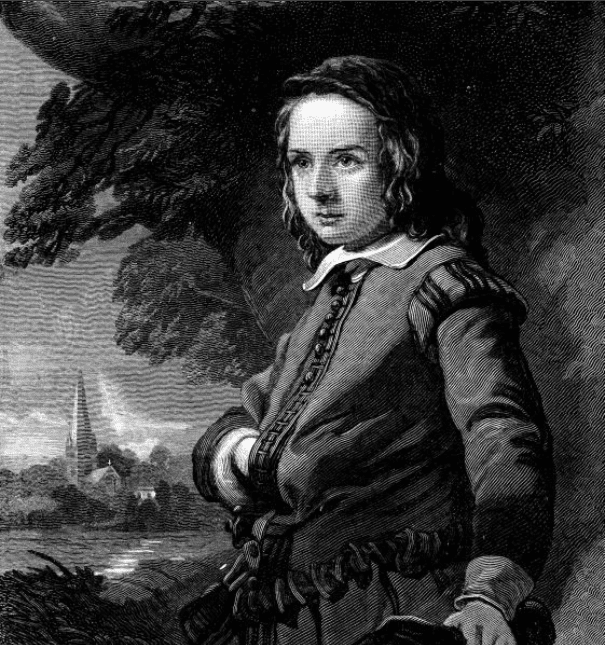
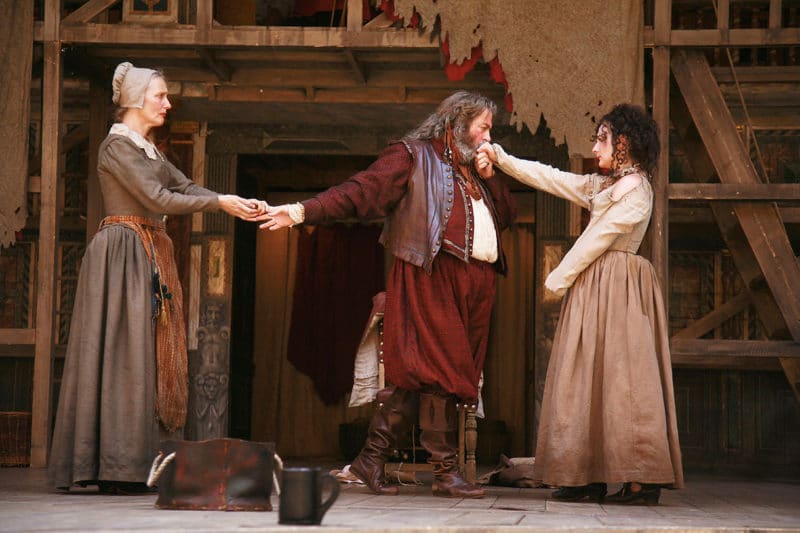
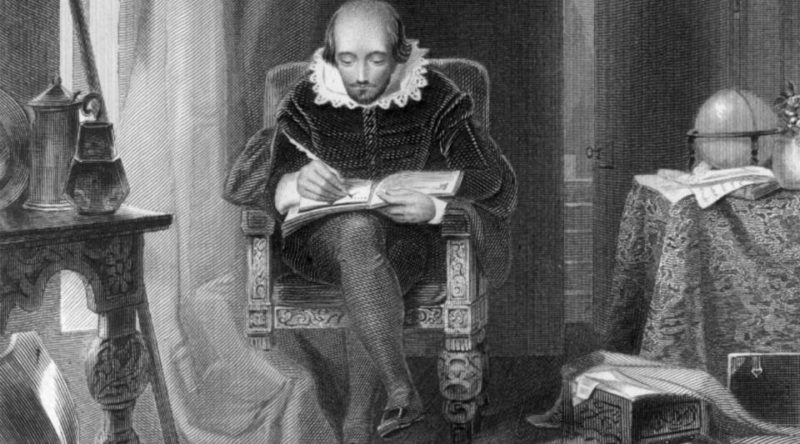
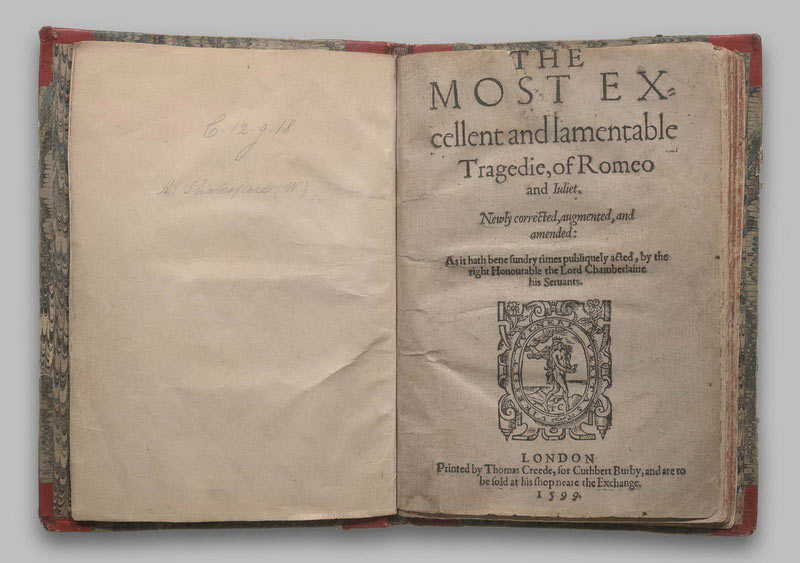
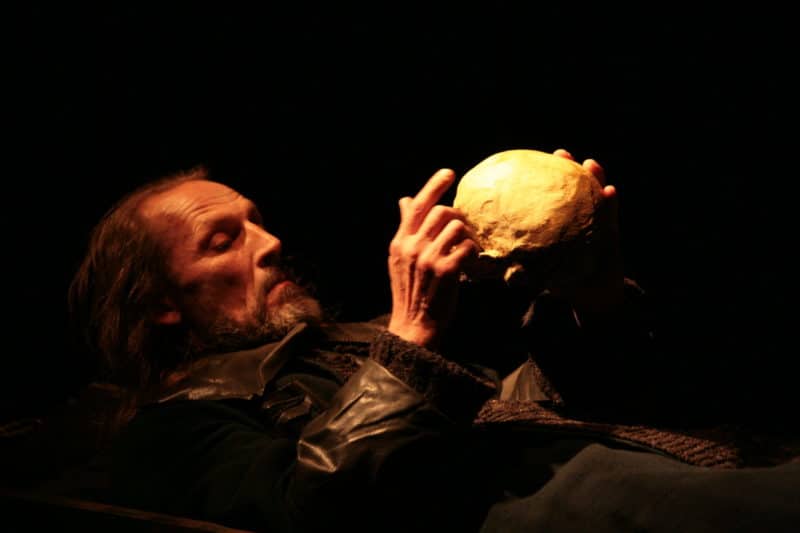
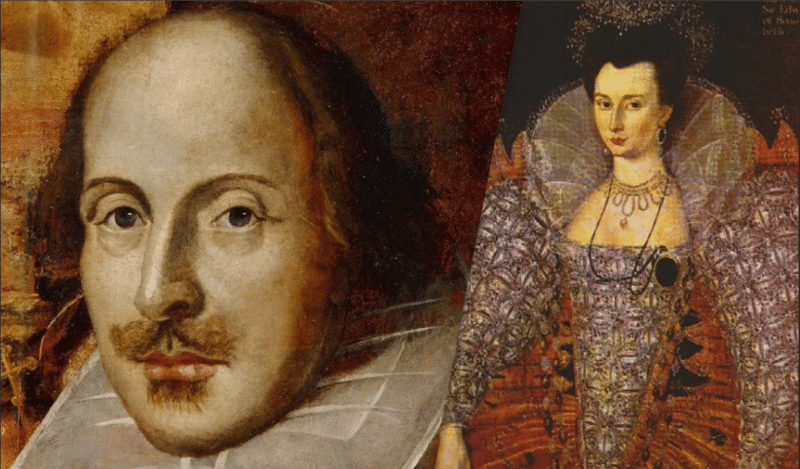
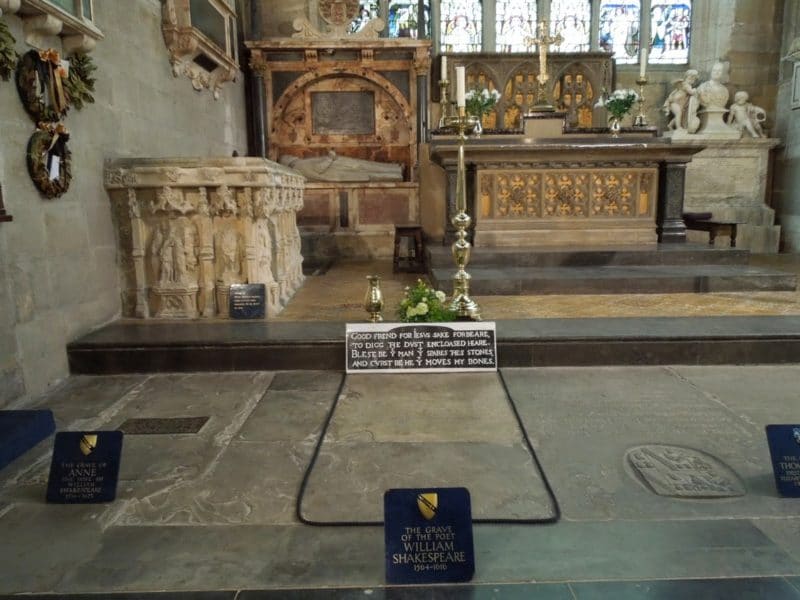


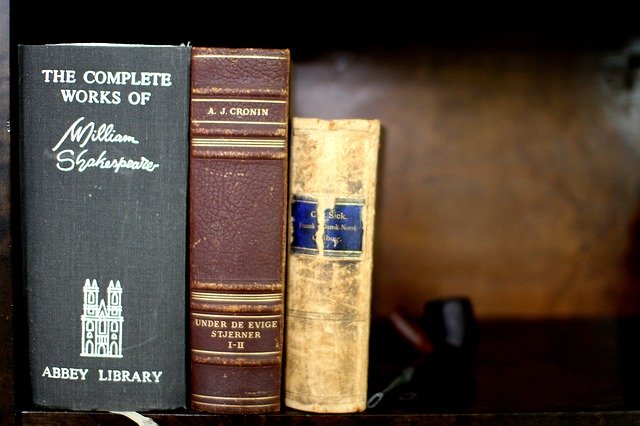
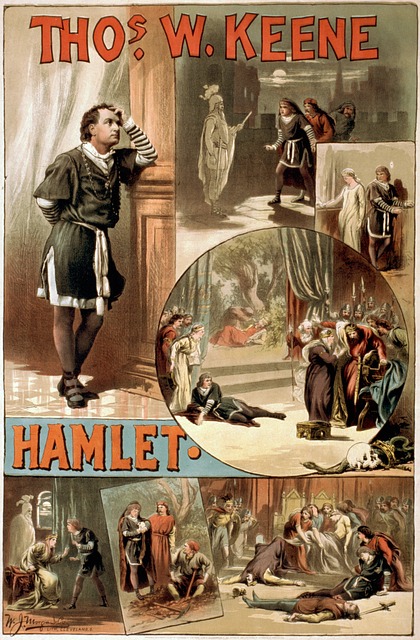

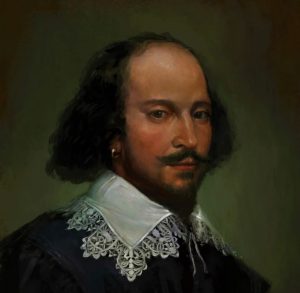 Роль и место в литературе
Роль и место в литературе